Section 5. The worksheets
© 2017 Tony Laing, CC BY 4.0 https://doi.org/10.11647/OBP.0092.07
Worksheet for No.1 (verso)
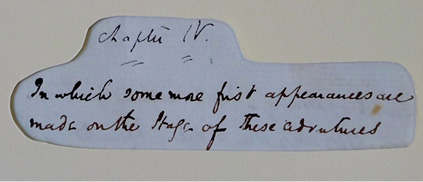
Image No.2012FE1485 verso: Forster Collection, National Art Library, Victoria and Albert Museum (2015). © Victoria and Albert Museum, London.
Click here to view a 'zoomifiable' version.
Transcription of Ws.1 (verso)
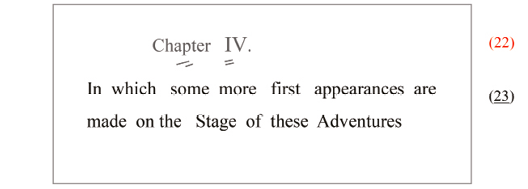
Worksheet for No.1 (recto)
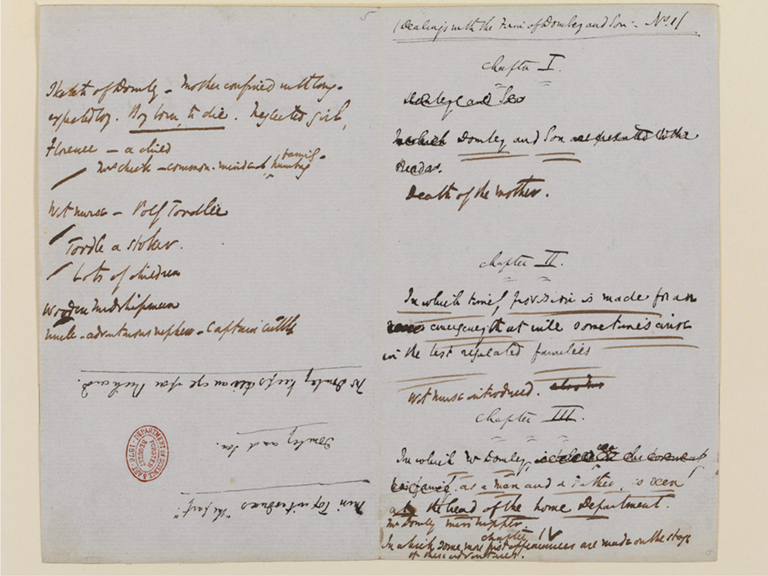
Image No.2012FE1485 recto: Forster Collection, National Art Library, Victoria and Albert Museum (2015). © Victoria and Albert Museum, London.
Click here to view a 'zoomifiable' version.
Transcription of Ws.1 (recto)
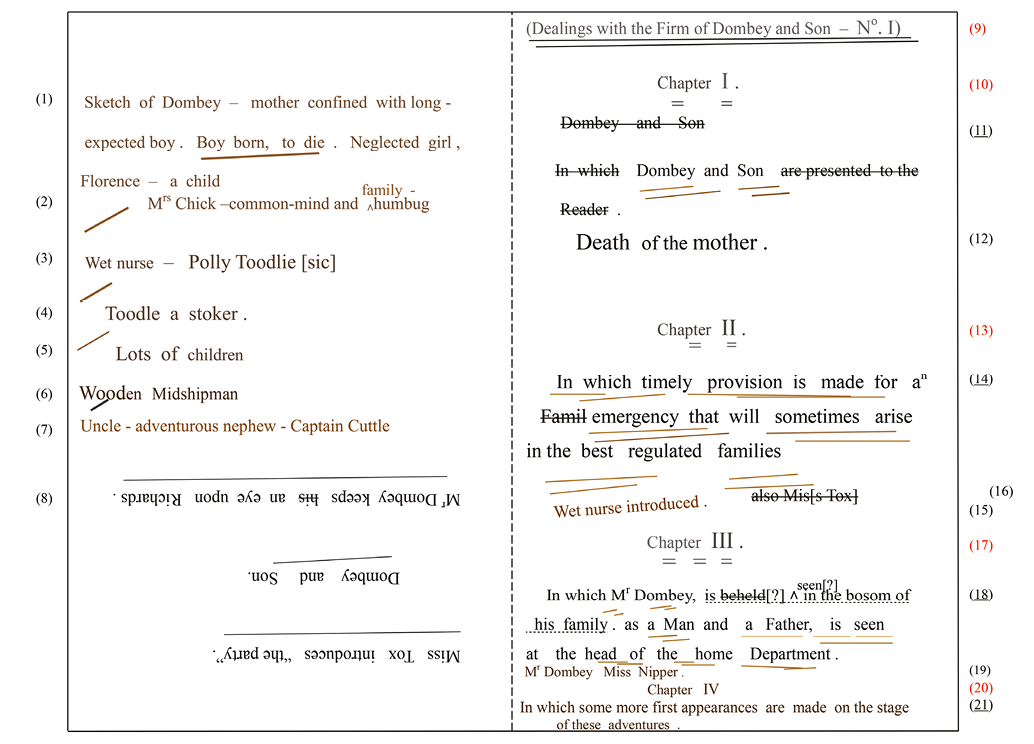
Commentary and order of entry Ws.1 (recto and verso)
Dickens and family settle in Lausanne in June 1846. The day after the arrival of his box of writing materials on 27 June, he “BEGAN DOMBEY! I performed this feat yesterday—only wrote the first slip—but there it is, and it is a plunge straight over head and ears into the story” (Life 400K:8159). Just four weeks later, he sent the first four chapters to Forster, and with it a lengthy detailed summary of the novel’s themes and structure, what he calls “the outline of my immediate intentions”.42 Nine weeks later, on 30 September, No.1 for October 1846 is published.
LH
Initial plan for the number: (1) & (2)→ch.1; (3), (4) & (5)→ch.2
These are identifiable by similarity of hand, ink and alignment. They are divided by idiosyncratic slashes, with one entry “Mrs Chick…humbug” (2) probably inserted soon after the others. The density and corrosion of entries is reasonably consistent in (1) and (2), though less so in (3)–(5). The corrosion of the two groupings is shown in two shades of brown. “Toodlie” is either an early version of Polly’s surname or a temporary trial alternative; either way it is rejected, perhaps for its inappropriate associations. In the last three initial entries, where Dickens is assembling materials for ch.2, entries (3)–(5) slip to the right as his hand and arm move downward. The first entry of a number plan often has wider scope than later ones. After noting the opening situation and the characters involved, Dickens indicates the direction of the narrative by “Boy born to die”. He frequently uses a single continuous underline to show that an entry looks forward beyond the number, in this instance to No.4, during which he initially plans to “kill Paul”.
Additional number plan: (6) & (7)→ch.4
Dickens uses a slightly heavier hand—and/or a more laden quill—for the sign of the Midshipman. Consequently, the lettering of (6) has retained more of its blackness, whereas the lighter hand and/or the less laden quill used for (7) has begun corroding throughout. Both are distinct from (1)–(5) in alignment, hand and to a less extent size. The two groups are divided by a slash, perhaps to further emphasise the importance of the shop and its sign. The second group comprises the three characters in the order in which they appear in the text. Together they suggest that Dickens is imagining structure as well as content for ch.4.
MS and RH
Preliminary headings: (9), (10), (13), (17) & verso (22)43
In the worksheet, Dickens gives the part heading—the longer novel title with the part number—and the number headings for four chapters, three spread evenly down the page and the number heading for ch.4 (22) entered by turning the worksheet over and writing on the under (verso) side. (The facsimile and transcription of the number heading for ch.4 is shown in portrait mode, before the facsimile of No.1 (recto). For an explanation, see endnote 41).
Composition and titling of chs.1, 2, 3 & 4: (11), (14) (18) & (23)44
In ch.1, Dickens probably titles in both worksheet and manuscript, but revises in worksheet and copies the revision to manuscript. In ch.2 on the other hand, he begins by titling in worksheet (he makes a running correction there that is not in the manuscript). Similarly, in ch.3, he again revises in worksheet and transfers the final version to the manuscript. The title of ch.4 (23) is first entered, like its number heading, on the worksheet’s verso side. For more on title revisions, see ‘Appendix D’. He sent Forster three letters, the first when he had written ch.1, the second when “all was finished except for eight slips”, i.e. chs.2 and 3 but not ch.4, and the third when he sent the manuscript of all four chapters (Life 472K:9243). The first three chapters take up thirty-two MS pages, and the initial final chapter adds another ten pages. So even allowing for irregularity of hand and spacing at the start of composition, he would know that, in his enjoyment of a “great plunge […] into the story”, he had overwritten No.1 by many printed pages. After a two-year break, perhaps needing the reassurance of composition, he quite uncharacteristically paid little attention to his instalment boundary.
RH
Summary notes for chs.1–3: (12), (15), (16) & (19)
For chs.1 and 2, partly because the titles are teasingly uninformative, Dickens gives their subject. For ch.3, he juxtaposes Dombey and Susan, whom he intends to be “a strong character […] throughout the book” (see the final paragraph of endnote 42). All four notes are corroded, some more than others. Entry 16 “also Mis(s Tox)” is a separate entry, using a non-corroding ink like that of (8), (14) and (18) but made with a thicker nib or heavier hand. He is perhaps considering how to put right the omission of Miss Tox in the chapter record of ch.2 (and in the number plan). The entry of her name here, and its deletion, is another sign of uncertainty, in this instance over the scope of the worksheet record. At this early stage, Dickens consistently treats the left-hand as a number plan and the right-hand half as a chapter record, apparently entering the few summary chapter notes altogether, after completing the first three chapters.
LH
These three items, perhaps initially intended as trial chapter titles, could just as well be the letterings to accompany illustrations. The first referring to ch.2 becomes the lettering for the first plate; the second becomes the title of ch.1. Dickens composes the third after finishing ch.3, but before he proposes to Forster the more ironic lettering for the second plate on 7 August “‘Mr Dombey and family’ meaning Polly Toodle, the baby, Mr. Dombey, and little Florence” (Life 473K:9283). Dickens, viewing both illustrations as a number requirement always places their lettering on the left-hand side. But because lettering usually arises from a particular text, it is often delayed until the relevant chapter has been written. Entry (8) is the only group made by reversing the page. Finding reversal inconvenient, he avoids repeating the practice. Thinking of how he might use the worksheets, he decides to avoid reversals and keep entries easy to scan and read at a glance.
Composition of an alternative ch.4 (later ch.7)
To reduce the “over-matter” which the added ch.4 creates, Dickens writes a shorter alternative chapter on Miss Tox and the Major to take the place of the one on “Wally & Co”.45 Forster objects to the change that it “might damage his interest at starting”. Dickens agrees “Strength is everything” (Life 474K:9297), implying that he felt it especially important, early on, to capture the reader’s interest in both the main storylines. Balancing the longer ch.4 (and the prospect of more deletions) against the alternative, Dickens prioritises what is more important for the novel as a whole. He also begins to use a smaller hand for the manuscript, with less space between words and between lines. The reductions, applied consistently from No.4 on, make it easier for him to estimate pages of manuscript as pages of print, and thus to calculate how many pages of print remain as he composes.46
RH
Broken underlining of titles of chs.1–3
They are probably made altogether, perhaps in a rush. Swiftly made black lines such as these usually corrode.
Chapter number heading and title for ch.4: (20) & (21)
Once the decision is made to retain the initial ch.4, its headings—already entered on the back, carefully laid out and capitalised—are squeezed onto the front, without capitals or underlines, a hurried final entry for the sake of the record. Transferring the title to the front is another practical decision that shows Dickens is thinking of how he might use the worksheet later (cf. the comment on reversal in the column opposite).
Proofs
The decision to retain the longer fourth chapter gives Dickens “great pangs” (Life 474K:9286). About thirty deletions have to be made, all to chs.1–3, but none to ch.4, which was probably at the printers.47
[Editor’s note: references above to Forster Life are (1) to Ley’s edition and (2) to ebook 25851 in Project Gutenberg downloaded to Kindle (see p.7)].
Worksheet for No.2
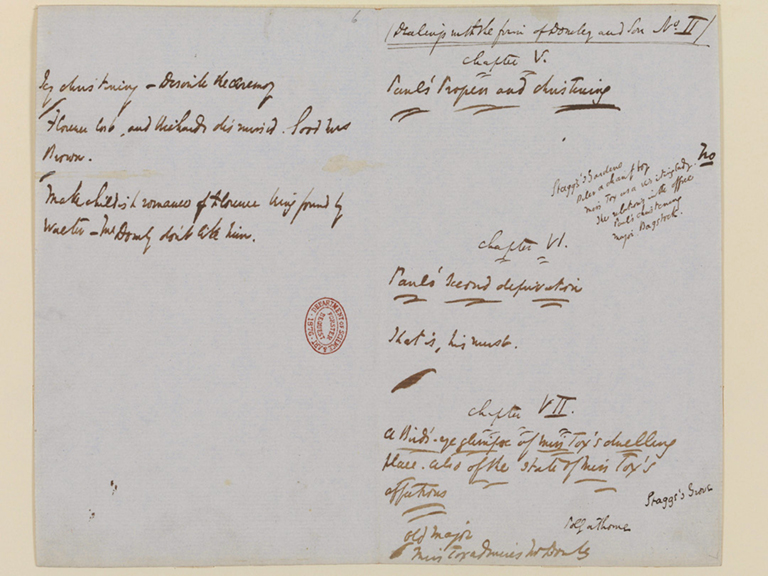
Image No.2012FE1506 (reduced): Forster Collection, National Art Library, Victoria and Albert Museum (2015). © Victoria and Albert Museum, London.
Click here to view a 'zoomifiable' version.
Transcription of Ws.2
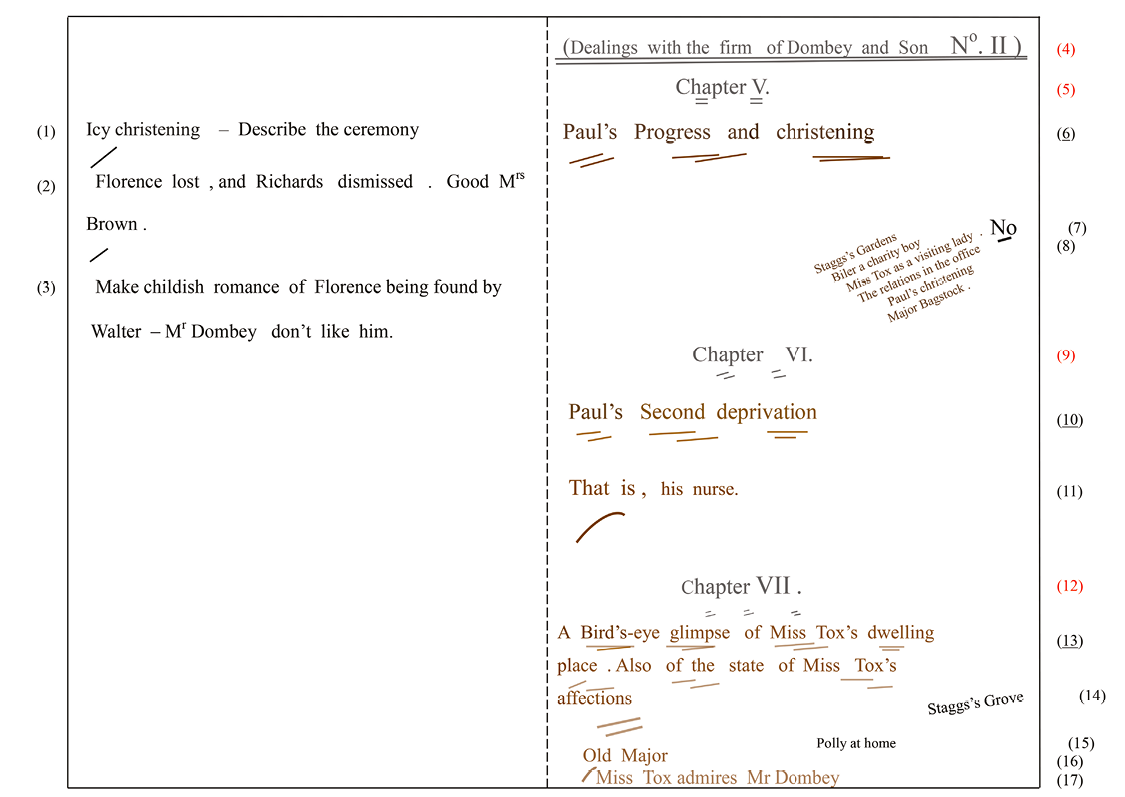
Commentary and order of entry (Ws.2)
Dickens begins No.2 on 8 August, writing with “infinite pains”, and finishing in the first week of September. The rest of September and early October are given over to his Christmas book for 1846, The Battle of Life. “You can hardly imagine,” he writes on 30 August “what infinite pains I take, or what extraordinary difficulty I find in getting on FAST. Invention, thank God, seems the easiest thing in the world; and I seem to have such a preposterous sense of the ridiculous […] as to be constantly requiring to restrain myself from launching into extravagances in the height of my enjoyment” (Life 423K:8591). The “pains” arise, he supposes, from the long gap between Dombey and his previous novel, and from writing for the first time while living abroad without access to the stimulus of London.48 Nevertheless, he is drawn into the wealthy English speaking community in Lausanne that forms “an agreeable little circle” to whom he reads the first number on ?19 September and the second on 10 October to the “most prodigious and uproariness delight of the circle” (Life 477K:9366). On 31 October, No.2 for November 1846 is published.
RH
Discarded entries (probably pre-format plans): (7), (8), (14) & (15)
Six items (8) on a slant, near the right-hand edge, and two others (14) and (15), directly below towards the bottom of the page, are all written in “smallhand”. Most of list (8) are ideas for this number, though one is for No.4; the two misplaced below (14) and (15) are for a narrative on the Toodles’ home and family. The six entries in (8) cover material that will be considerably reordered: the christening and the charitable gesture that separates Rob from his family to ch.5; “Staggs’s Grove” (perhaps its earlier title) and “Polly at home” to ch.6; the “old Major” to ch.7; and the first extended account of the office to ch.13. The entry “Miss Tox as a visiting lady” may refer her as a visitor to the Dombey house (ch.1), or to her calling on Queen Charlotte’s (as reported in ch.2) or more probably to the development of her visit to the Toodles (reported in ch.2 but not dramatized until much later in ch.38). These entries appear to be ‘pre-format’ notes, i.e. among the very first notes on the early numbers that Dickens jotted down before he had devised the worksheet format. Setting them aside is a result of two key decisions that accompany the division of the worksheet into two halves. Firstly, to always position ideas for the number as a whole on the left-hand side, and secondly to limit all entries on the right-hand side to part heading and chapter number, title and description. If the above are pre-format entries, as seems likely, the “No” of (7) applies to all eight.
RH
Preliminary headings: (4), (5), (9) & (12)
Reverting to the opening procedure of Ws.1, Dickens now enters the longer title with the number of the part issue, followed by three chapter number headings spread evenly down the page.
LH
Plan for the number: 1→ch.5; 2 & 3→ch.6
These notes, written fluently on the same occasion, move smoothly though aspects of the opening and middle chapters. Each entry is twofold giving the subject and some development of it. Dickens already has their shape in mind, though not their detailed structure. In (3) he is imagining Florence speaking, rather than Walter. Compare Walter’s speech to Cuttle that Dombey “does not like me” (209223) with Florence’s cry at the prospect of saying goodnight to her father “Oh no no! He don’t want me” (3535), where the repetitive “no no” and “don’t” is used to typify the speech of a young child. Many contemporary aspiring middle class would expect Dombey, as the head of a respectable and wealthy family, to disapprove of her association with a junior clerk; Dickens deflects their disapproval somewhat by always avoiding nonstandard language when Walter speaks.
MS and RH: (6)
Composition and titling of ch.5
Dickens revises the title as he writes the chapter, and transfers the final version to the worksheet.
MS
Composition and titling of ch.6
Dickens, happy in his choice of a title that looks back to Paul’s first loss in ch.1, enters it at start of composition.
RH
Titles and descriptions of chs.6 and 7: (10), (11), (13), (16) & (17)
Similarity of hand and progressive corrosion confirms that titles and descriptions are entered at the same time.
For the history of the revision in the manuscript of the title of ch.4 (later ch.7), see ‘Appendix D’, ch.7 p.182. When Dickens transfers the revised title of ch.4 to ch.7 in Ws.2, he revises it a second time. Adapting the proofs of the initial ch.4 for ch.7, he appears to copy in the title from the worksheet and, as he does so, to tighten its sentence structure. (Alternatively and perhaps less likely, he may enter the title in the worksheet from his memory of the corrected proofs of ch.4, and misremember its punctuation, in which case the second revision of the title is first made in the proofs).
Progressive corrosion begins with the title of ch.6 and continues to the end, confirming that Dickens makes these entries at the same time. The two summary entries for ch.7 are separated by a slash (used on the right-hand side for the first time). They correspond to the two contrasting concerns of the chapter the Major’s disbelief at being passed over, and Miss Tox’s romantic feelings for Mr. Dombey.
Forster corrects the proofs with Dickens’s consent. He had already “put the drag on” in ch.5 so as not to offend Christian sects. He now adds a conciliatory stuffy paragraph on the sacrament of baptism; the paragraph begins “It might have been well” (6062). Just before that addition, he cuts a comparison of the font to a child’s toy.49 He also deletes the two closing sentences of ch.7 that prepares for the next number to open with Paul’s schooling.50 The deletion of this plant for the opening of No.3 reflects the outcome of a choice under consideration at the time, to postpone schooling to No.4 and “kill” Paul in No.5, and “make number three a kind of halfway house between infancy and Paul being eight or nine”, in contrast to the first paragraph of the outline to Forster “When the boy is about ten years old (in the fourth number), he will be taken ill, and will die” (see endnote 42). Dickens raises the possibility with Forster at the beginning of October, after writing No.2 but before starting No.3 (Life 477K:9358).
The decision to postpone opens the way for an extended portrait of Mrs Pipchin’s “establishment”, the first of Dickens’s explorations in fiction of painful childhood memories. He writes to Forster on 4 November “I hope you will like Mrs. Pipchin’s establishment. It is from the life, and I was there—I don’t suppose I was eight years old; but I remember it all as well, and certainly understood it as well, as I do now. We should be devilish sharp in what we do to children” (Life 479K:9396).
Worksheet for No.3
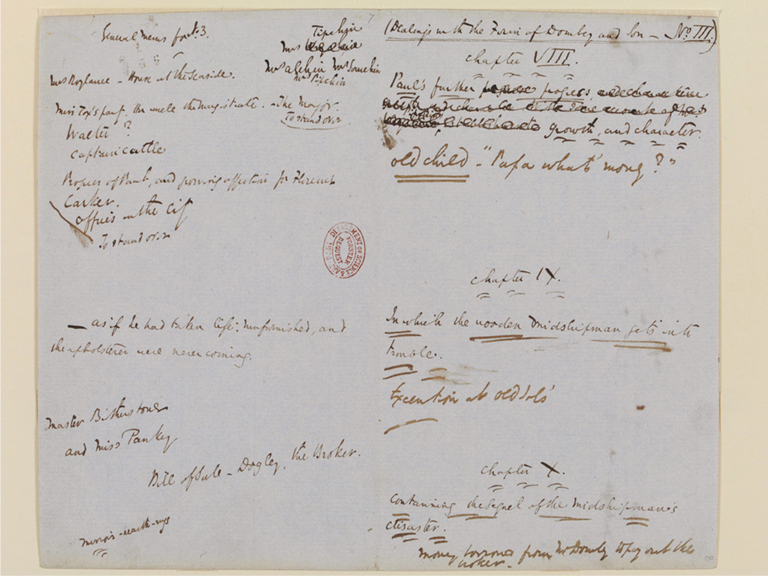
Image No.2012FE1486 (reduced): Forster Collection, National Art Library, Victoria and Albert Museum (2015). © Victoria and Albert Museum, London.
Click here to view a 'zoomifiable' version.
Transcription of Ws.3
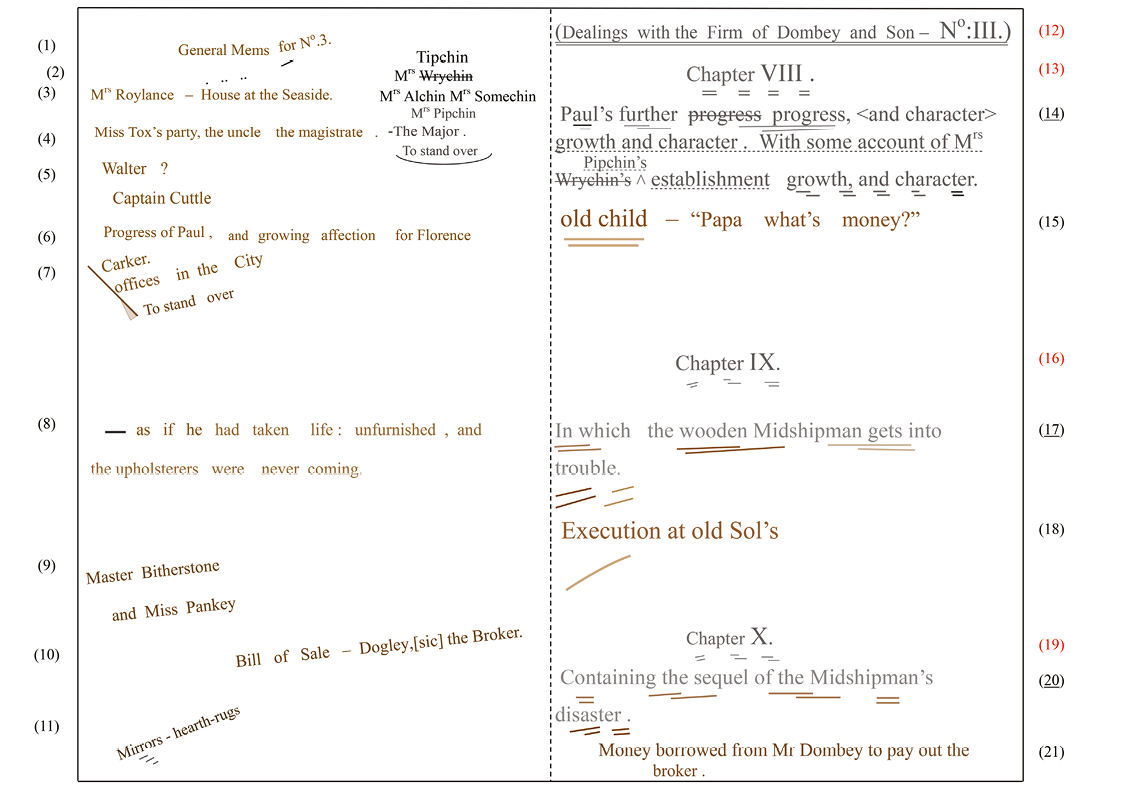
Commentary and order of entry (Ws.3)
Immensely relieved by the “BRILLIANT!” sale of No.1, Dickens is anxious to sustain its success (Life 477K:9363). He writes to Forster that “A week of perfect idleness […] has brought me round […] I am quite glad to write the heading of the first chapter of number three to-day [26 October]. I shall be slow at first, I fear, in consequence of that change of plan [see ‘Proofs’ in Ws.2 p.45]. But I allow myself nearly three weeks for the number” (Life 478K:9369). On 4 November, he is half through it, on 7 November he is in the “agonies” of its last chapter, and on 9 November, as Forster says ‘all was done…marvellously rapid work’ (Life 441K:8977). Dickens hurries to complete the instalment early, in order to prepare for the family’s move to Paris the following week. He composes fluently, inspired by the memories of childhood that were beginning to preoccupy him. The gap between completing the number and his deadline for delivering copy to the compositors (at least five days prior to issue) is narrowing. On 30 November, No.3 for December 1846 is published.
LH
Plan for the number (including some pre-format plans, cf. Ws.2):
(1); (3)→ch.8; (4); (5)→chs.9 & 10; (6)→ch.8; (7)→ch.13
Dickens’s choice of word in (4) repeats the lettering for the first plate of No.1, where Miss Tox’s “party” is the Toodles family, and repeats the “magistrate” detail of ch.5 (5254).51 These untypical repetitions suggest that he may have been making notes here for the opening numbers before he began work on No.1. The sheet, consisting of entries (1)–(7) excluding (2), may have begun as some “General Mems” for the first few numbers, Dickens’s earliest notes (with Ws.28, 14 & 15) jotted down before he devised the worksheet format (hence the addition later “for No.3”, see below).
Dickens retains the heading “General Mems” because, in comparison with Ws.1 and 2, its left-hand entries go beyond the current number. The heading is not used again until Ws.19&20, when he is once again considering the story as a whole.
He inserts “for No.3” after the heading (2), adds the two “To stand over” entries, jettisons a party at Miss Tox’s—perhaps attended by her uncle and part of a more extended satire of Miss Tox, apparently abandoned—and postpones both the Major (4) and James Carker in the city offices (7). He is left with early memories of Mrs Roylance (3), Walter Cuttle (5), and the development of Paul (6), particularly the boy’s growing attachment to Florence.52 The concentration on Paul, as he begins Ws.3, flows from the decision made between Nos.2 and 3, to lengthen Paul’s story to five numbers (see above “that change of plan”; also the final comment in ‘Proofs’ in Ws.2 p.45).
RH
Preliminary headings: (12), (13), (16) & (19)
LH and RH
Additional number plan: (2)
Titling ch.8: (14)
Dickens begins by devising names for Mrs Roylance as part of the number plan, first “Alchin”, then “Somechin”. When he tries out the next name “Wrychin” (2), he incorporates the name into his third attempt at a chapter title in (14). Still not satisfied, he tries out “Tipchin” and then “Pipchin” in (2), which he inserts into the revised title in (14)—again moving between the left and right-hand half. This version is then copied to MS, where the revision process continues during composition (‘Appendix D’, ch.8 p.183).
Caught up in the memory of Mrs Roylance, Dickens feels compelled to find a name that rings true for a character “from the life”. It is his detailed memory of Mrs Roylance that sways his judgment of the second illustration of Paul and Pipchin at the fireside “It is so frightfully and wildly wide of the mark” (Life 478K:9383). Despite his outrage, he is becoming aware of the difficulty that his retentive memory for visual detail posed for his illustrators.53
MS
Composition and titling of ch.8
When Dickens transfers the title from the worksheet, he adds what is probably an ironic reference to Mrs Pipchin’s “Establishment”. During the writing of the chapter, he reconsiders the emphasis, deletes the phrase, and limits the title to Paul (see reference above).
LH
Further number plan: (8)→ch.11; (9)→ch.8; (10) & (11)→ch.9
Dickens begins to use the lower part of the left-hand side. He notes ideas for individual chapters, here an evocative comparison (8), children’s names (9), a plot detail (10), and a startlingly random but significant juxtaposition of objects (11). These are all written with a similar hand—and with (9) and (10) written on a slant—suggesting that, although his general practice is to work closely on each chapter in turn, he is at the same time imagining characters, places and other details that will find a place somewhere in later chapters.
He holds back the striking entry (8) for the end of the opening chapter of the next number (with amendments to its punctuation) in line with his decision to extend Paul’s story. The entries as a whole signal an important change in the use of the worksheet. He adapts its format to include prospective details for individual chapters before they are written, in this instance using the lower left-hand.
MS
Composition and titling of chs.9 and 10
The long ch.8 has already taken up fifteen MS pages. Ch.9 fills a further ten. Consequently, ch.10 begins on MS p.26. Dickens is probably by now working to a notional 27 or 28 MS pages to thirty-two pages of print, in which case he knows, even as he writes, that cuts will be needed. The number of pages taken up by each chapter as published in each instalment is given in ‘Appendix A’ (see the ‘Key’, p.167, for how chapter length is calculated there).
RH
Titles of chs.9, 10: (17) & (20)
Similarity of hand suggests that Dickens transfers both titles to the worksheet at the same time.
Description of chs.8, 9 & 10: (15), (18) & (21)
Dickens emphasises a common theme, perhaps entering the descriptions of (21), (15) and (18) in that order (see their progressive loss of density and increasing corrosion). After adding, for some reason an extra double underline to (17)—haste rather than a blotting error—he finishes ch.9’s description and the worksheet, with a flourish.
Proofs
As expected, the proofs overrun by four pages. Dickens takes out about two and a half pages, leaving the rest to Forster (Life 479K:9400). The longest of the cuts in ch.10 concerning Miss Tox’s attachment to Dombey—and many early ones in ch.8 that are not so long—are restored in Project Gutenberg’s edition ebook 821, chs.8 and 10).
More cuts are avoided by reducing gaps between chapters and adding a line to each printed page—both devices of last resort that were available but not invoked for No.1, perhaps because they might not be sufficient to accommodate the scale of the cuts required.
Worksheet for No.4
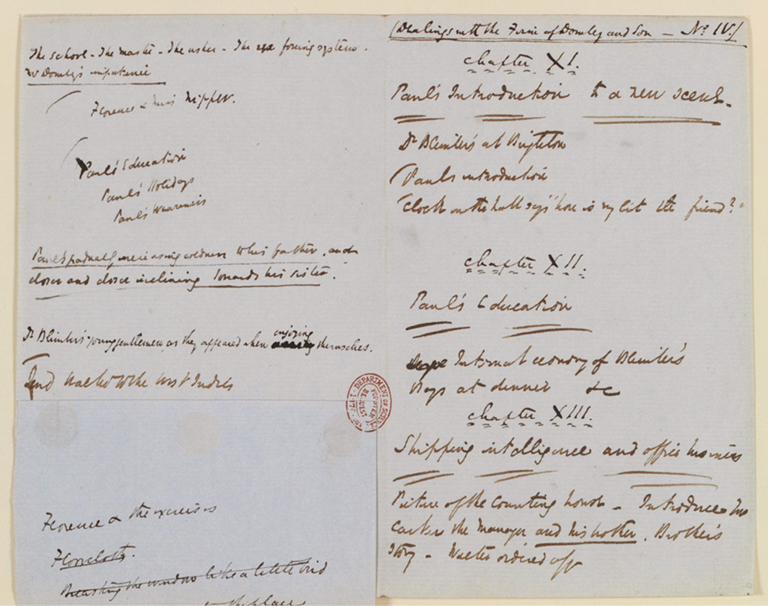
Image No.2012FE1488 (reduced): Forster Collection, National Art Library, Victoria and Albert Museum (2015). © Victoria and Albert Museum, London.
Click here to view a 'zoomifiable' version.
Transcription of Ws.4
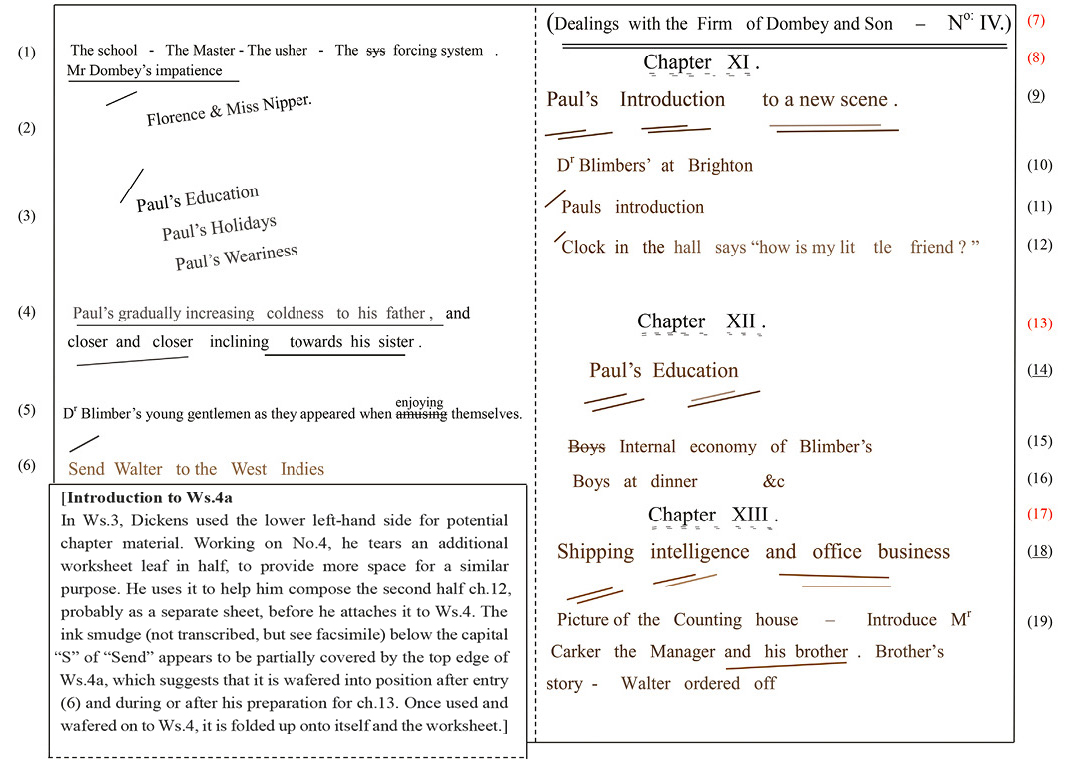
[Introduction to Ws.4a In Ws.3, Dickens used the lower left-hand side for potential chapter material. Working on No.4, he tears an additional worksheet leaf in half, to provide more space for a similar purpose. He uses it to help him compose the second half ch.12, probably as a separate sheet, before he attaches it to Ws.4. The ink smudge (not transcribed, but see facsimile) below the capital “S” of “Send” appears to be partially covered by the top edge of Ws.4a, which suggests that it is wafered into position after entry (6) and during or after his preparation for ch.13. Once used and wafered on to Ws.4, it is folded up onto itself and the worksheet.]
Commentary and order of entry (Ws.4)
The Dickens entourage—himself, wife, children, servants and luggage, in two carriages and a wagon—leaves Lausanne on 16 November, arriving in Paris on the 20th. For days, he searches for a house to rent, organises the household and explores the city. “I tried to settle to my desk, and went about and about it, and dodged at it, like a bird at a lump of sugar.” By 6 December, he has “written five printed pages” (Life 447K:9094). In another nine days, he completes the number, some ten days before his deadline. On the 15th he goes to London, bringing the finished manuscript with him. He stays until the 23rd, partly to read the proofs and partly to settle details of the publication of the Cheap edition, his first collected works (see Life 448K:9107). The “new preface” he had just written for Pickwick Papers reveals some of his artistic ambitions for Dombey and Son.54 On 31 December, No.4 for January 1847 is published.
RH
Preliminary headings: (7), (8), (13) & (17)
Dickens returns to the procedure of Ws.1, making these entries first (cf. Ws.1–3).
LH
Initial number plan: (1)→ch.11; (2) & (3)→ch.12 ; (4)→chs.11 & 12
Four groups in the same hand are separated by slashes and positioning. In entry (1) Dickens notes the organisation of the school and its methods that are well matched to Dombey’s ambitions for Paul. In (2), Susan now a “Miss Nipper” is a companion—and foil—to Florence. In (3) he proposes three stages to Paul’s progress; the first becomes a title for ch.11 (later transferred to ch.12); the other two will be held over for No.5.
Paul’s turning to Florence and away from his father (4) is underlined, like Dombey’s impatience, as an ongoing and, in Paul’s case, a growing feeling (cf. Ws.36 p.47).
MS
Composition and titling of ch.11
Dickens writes a long recapitulation, adding to the portrayal of Pipchin by her meeting with Dombey, now impatient to push ahead with Paul’s formal education. He initially titles ch.11 “Paul’s education” perhaps expecting to write further into the Blimber material. Then he limits the remaining pages to “introducing a new scene”, arresting the action at the moment of Paul’s abandonment. He can now use Ws.38—the image of the child sitting alone in a desolate and empty newly rented house, so expressive of loss—as a curtain to the chapter. Number openings, usually with strong links with the previous number, are often, as here, expansive and improvisatory.55
LH
Additional number plan: (5)→ch.12; (6)→ch.13
Dickens uses his smallest hand in (5) to get the lettering for the first illustration on one line, probably as he is writing ch.11. The lettering is sent to Browne (?6 Dec 1846, L.4:677) with a lengthy account of the general context (from the completed ch.11) and a brief description of the subject in ch.12 (yet to be written).
Despite the letter, Browne adds to the number of pupils (Dickens writes there are ten). He also supplies a well-developed visual contrast of his own between the formally clothed pupils and the other boys who are free to enjoy the pleasures of the seaside (cf. his final image of a young Florence, with Paul on the seashore in his frontispiece for the finished novel p.163). Although Browne’s subject of both plates for No.4 comes from the same chapter (ch.12), he maintains a strong contrast between them, by inventing the setting for his second illustration, an indoor scene at night (see “Paul’s exercises”).
For all other numbers, Browne finds (or is given) subjects from different chapters, presumably to heighten visually the contrast between storylines. Like other second illustrations, this one requires less detail than the first making it easier for Browne and his engravers prepare it in time.
Chapter plan: Ws.4a→ch.12
Ws.4a is a plan for the second half of ch.12 probably not attached to Ws.4 until entry (6) is made (see above ‘Introduction to Ws.4a’ p.51).
MS
Composition and titling of ch.12
Dickens uses the initial but discarded title of ch.11 for ch.12. He probably has Ws.4a alongside him to help him order the later parts of the chapter, including its ending (see below Ws.4a p.54).
RH
Titles and summaries for chs.11 & 12: (9), (10), (11) & (12); (14), (15) & (16)
Throughout the right-hand side, hand, quill and ink are similar. The hand is rapid, especially in the descriptions, with a great deal of elision of letterform. Both titles are similar in their generous layout, slant and hand. The descriptions of chs.11 and 12 are basic summaries, giving a setting in (10) and (15) and the central episode in (11) and (16). Among Paul’s reactions in ch.11, Dickens picks out a particularly significant moment—his sensation of the great clock’s machinery that begins and ends his first experience of Blimber’s (12). The description of ch.12 is briefer and even hastier, the letters losing definition and increasing in their slant.
The “etc” probably refers to the rest of the repetitive daily tasks and routines, rather than the materials touched on in Ws.4a, though these also act as a record of the chapter, as well as an aid to its composition.
LH
Further number plan: (6)→ch.13
Dickens decides to remove Walter from the narrative until Florence is old enough for the romance plot to be resumed. After this entry, he wafers Ws.4a to the bottom of the left-hand half, overlaying the smudge in (6) (see below, top left of facsimile Ws.4a p.54).
RH
Dickens allocates a generous space for the chapter title as in chs.11 and 12, but this time leaving a gap for the title to be inserted later. The description is the first plan for a whole chapter. The directive “Introduce” is a decisive indication of planning. In composition, he reworks the plan, contriving to give Dombey a prominent part in the picture of the office, in the drama that follows and in the dispatch of Walter—all understandable additions and departures when reworking a plan, but unlikely omissions in a summary.56 Throughout the plan, he uses the same sprawling hand as before. Writing in haste, he avoids re-dipping by reducing pressure on the quill, which thins the density of the ink (see the progressive loss of density in (12) and (19)).
MS and RH: (18)
Composition and titling of ch.13
During composition, once he is satisfied with the title after much revision, Dickens transfers the final version into the gap left for it in the worksheet (see ‘Appendix D’, ch.13, p.183).
Facsimile of Ws.4a
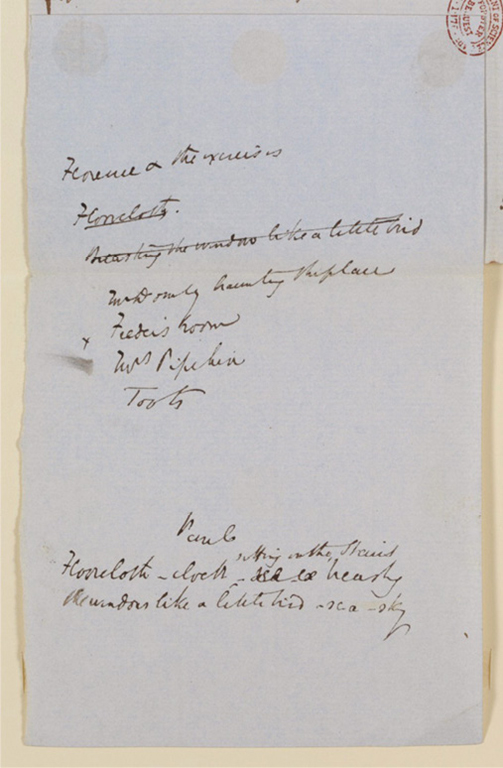
Image No.2012FE1488 (reduced): Forster Collection, National Art Library, Victoria and Albert Museum (2015). © Victoria and Albert Museum, London.
Click here to view a 'zoomifiable' version.
Transcription of Ws.4a
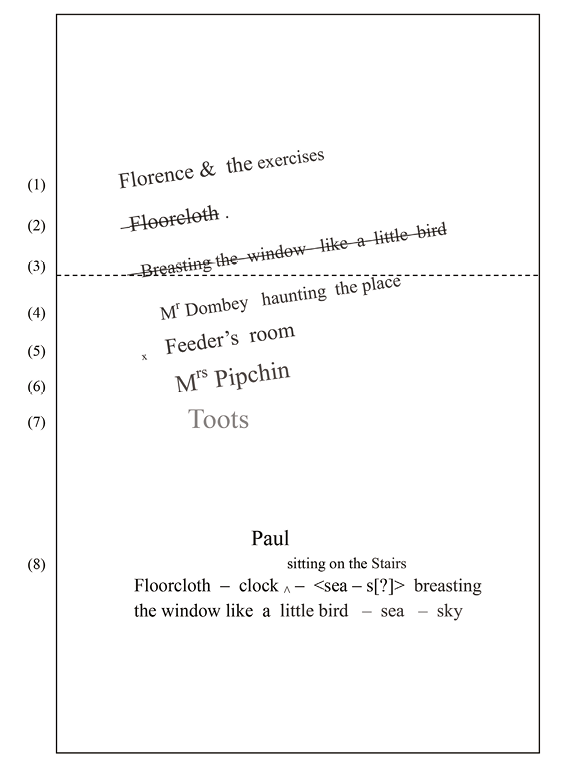
Commentary on Ws.4a
This is the first of the four leaves that Dickens attaches to a worksheet. He wafers the leaf to the bottom left-hand of Ws.4, probably after making entry Ws.46 (see the tail end of the “S” of “Send” that is covered by Ws.4a, shown top left in the facsimile above). He spreads a list of entries down and across the page, writing in a fast hand, as though hurrying to keep abreast of thought. All are linked to ch.12, beginning “Oh Saturdays!” (162–70177–81).
The resonance that each entry has for him can be sensed from what it becomes in the manuscript, for example:
- Florence’s scheme to help Paul, in which love transforms learning.
- Paul’s withdrawal into the inner life of his imagination, seeing patterns in the floor covering.
- His helplessness and longing to escape is imaged as an imprisoned bird (cf. 170181).
- Dombey isolated and preoccupied is cut off by his ambition for Paul.
- The compensations of his own room for Feeder “the organ grinder” are prepared for in passing (159169), with a tiny ‘x’ to the left of the name, perhaps to indicate postponement—a reminder to describe the room later (see ch.14, 187198–99).
- Pipchin, still very much present in Dickens’s imagination—note the slight increase in size of the name—is in charge of Florence and so occasionally at Blimber’s; she interrupts Toots’ conversation with Paul.
- Slowly, each appearance of Toots deepens Dickens’s conception of him; he uses him here to draw out the portrayal of Paul (cf. 152–53162–64, 159169).
- He creates a second list by moving (2) and (3) into a separate list of those entries that concern Paul alone. The order of the items in (8)—like those in Ws.5a—has both an emotional and a narrative logic (168–70179–81).
The act of making a second list gives a glimpse into Dickens’s inventive intelligence. He reworks heightened moments in his imagination of the child’s inner life until they join and take on a narrative order, which is then incorporated into the longer text that he has perhaps already imagined. Laying out on the page the sequence of ideas in preparation for a passage of narrative is a significant development in his use of the worksheet. In this respect, Ws.4a—laid out as narrative focalised on the ailing Paul—prepares for the notation of Ws.5a.
Worksheet for No.5
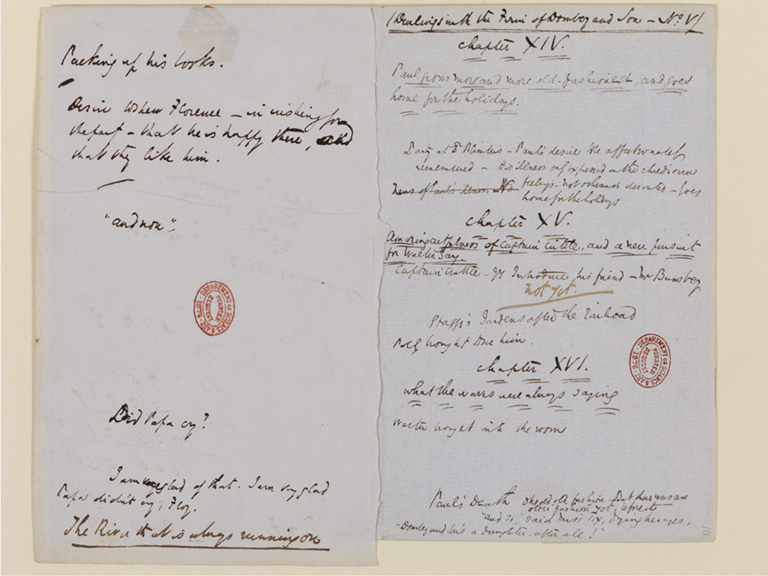
Image No.2012FE1496 (reduced): Forster Collection, National Art Library, Victoria and Albert Museum (2015). © Victoria and Albert Museum, London.
Click here to view a 'zoomifiable' version.
Transcription of Ws.5
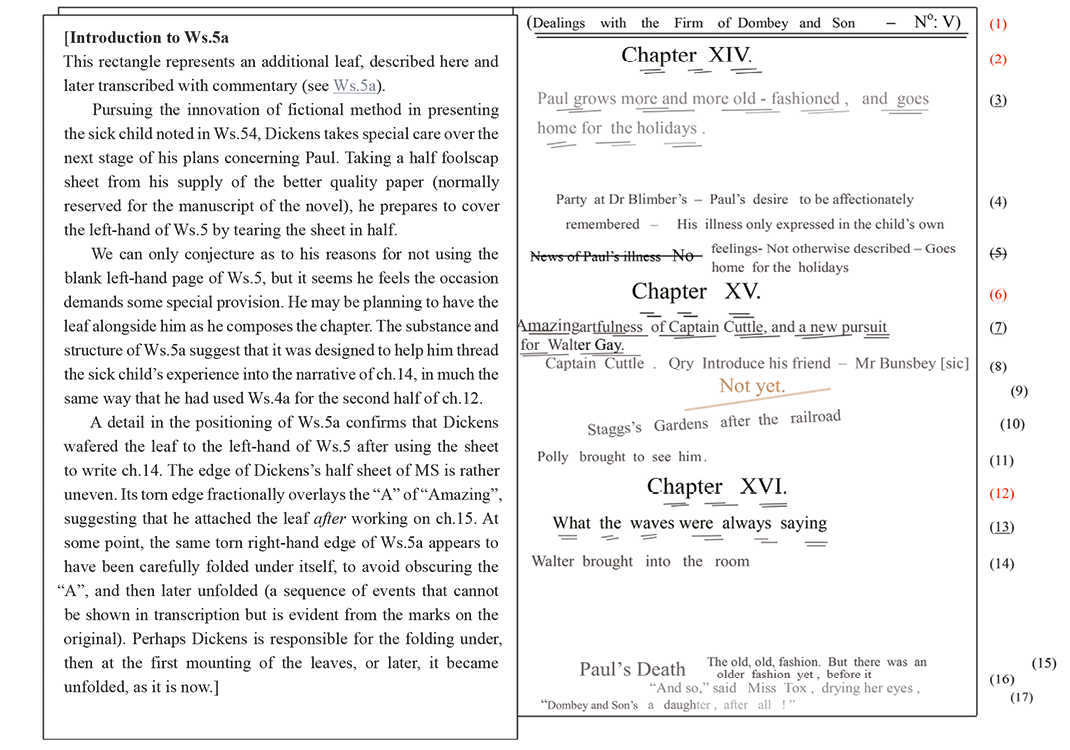
[Introduction to Ws.5a This rectangle represents an additional leaf, described here and later transcribed with commentary (see Ws.5a).
Pursuing the innovation of fictional method in presenting the sick child noted in Ws.54, Dickens takes special care over the next stage of his plans concerning Paul. Taking a half foolscap sheet from his supply of the better quality paper (normally reserved for the manuscript of the novel), he prepares to cover the left-hand of Ws.5 by tearing the sheet in half.
We can only conjecture as to his reasons for not using the blank left-hand page of Ws.5, but it seems he feels the occasion demands some special provision. He may be planning to have the leaf alongside him as he composes the chapter. The substance and structure of Ws.5a suggest that it was designed to help him thread the sick child’s experience into the narrative of ch.14, in much the same way that he had used Ws.4a for the second half of ch.12.
A detail in the positioning of Ws.5a confirms that Dickens wafered the leaf to the left-hand of Ws.5 after using the sheet to write ch.14. The edge of Dickens’s half sheet of MS is rather uneven. Its torn edge fractionally overlays the “A” of “Amazing”, suggesting that he attached the leaf after working on ch.15. At some point, the same torn right-hand edge of Ws.5a appears to have been carefully folded under itself, to avoid obscuring the “A”, and then later unfolded (a sequence of events that cannot be shown in transcription but is evident from the marks on the original). Perhaps Dickens is responsible for the folding under, then at the first mounting of the leaves, or later, it became unfolded, as it is now.]
Commentary and order of entry (Ws.5)
Dickens begins No.5 soon after Christmas 1846 (probably 31 December) and finishes on 15 January, once again about ten days before his deadline. Forster arrives on the 16th ‘The greater part of the night of the day on which it [No.5] was written…he [Dickens] was wandering desolate and sad about the streets of Paris. I arrived there the following morning on my visit; and as I alighted…a little before eight o’clock, found him waiting for me at the gate of the post-office bureau’ (Life 481K:9442). On 31 January, No.5 for February 1847 is published.
RH:
Preliminary headings: (1), (2), (6) & (12)
Dickens follows his established routine.
Plan for ch.14: (4) & (5)
He puts number planning aside and instead plans for the first of two chapters concerning Paul. He begins by entering a note of the chapter’s ending, the news of Paul’s illness, adds “No”, and then deletes the whole entry (5). In its place—still leaving half of the space blank for the title—he plans the chapter from its central episode (the party) onwards. He notes Paul’s displacement of feelings of loss by concern for others, and finally his intention to present illness exclusively from the sick child’s viewpoint (4).
Ws.5a
Dickens breaks off from Ws.5 to prepare Ws.5a. The decision to focus on the ailing Paul is “a difficult, but a new way of doing it […] and likely to be pretty” (Life 404K:8229) something he had in mind since at least the 5th of July.57 His use of the word “pretty” to describe the innovation is a characteristic defensive understatement. Aware of some of the difficulties, he makes special preparations in Ws.5a.
MS
Composition and titling of ch.14
Anticipating that the final chapter will be short, Dickens feels free to improvise an unusually long lead-in to the main episode the end-of-term party; it becomes ten printed pages of about seventeen (see ‘Appendix A’ p.165). As he writes ch.14, he weaves the substance and structure of Ws.5a into its composition. He also enlarges its title, revising it twice (‘Appendix D’ p.181). The leave-taking after the party is one of many extended departures that intensify pathos and the general mood of the novel (cf. the procession of farewells in chs.16, 44 and 57).
RH
Title of ch.14: (3)
Dickens copies the final version from manuscript into the gap left for it in the worksheet.
Plan for ch.15: (8), (10) & (11)
Leaving a line for the title, Dickens enters note (8), which presumably points to the first episode that ends with Cuttle seeing Walter off on a long walk. As in the other two chapters, Dickens defines an endpoint (11). The challenge then is to devise a plausible and effective narrative that links (8) to (11). He considers the introduction of Bunsby (9), leaving it as a possibility to be settled during composition. Entry (10) on the progress of the railroad explains Susan’s predicament and makes more acceptable the coincidence of her meeting with Walter (in preparation for his recall). Dickens is alert throughout the novel to the different ways the development of the railway impinges on his characters.
MS and RH
Composition and titling of ch.15: (7)
Dickens ends with Walter being called back to the house, a plant for the opening of ch.16. He copies the title to worksheet.
RH
Outcome of (8) in ch.15: (9)
With a drying quill, Dickens confirms the postponement of Bunsby. The timing is conjecture; there is nothing to indicate when after writing ch.15 he made the entry (8).
Titling and plan for ch.16: (13), (14), (15), (16) & (17)
Dickens titles at once (13), as he sometimes does if certain of his choice. The style of broken underlining—many equal short strokes—may give it additional emphasis, though the style is used elsewhere, without that effect (see Ws.8 p.75). He notes that Walter is to be brought into the room (14), completing the action began in ch.15 (220236), and adding weight to Paul’s last wishes, which later are impetuously set aside by Dombey. Layout and hand suggests that he enters “Paul’s Death” (16) first, then (15) and lastly (17), as the quill begins to dry.
Ws.5a
Dickens adds a final entry to Ws.5a, the river symbol (6). He can then use Ws.5a in much the same way for ch.16 as he did for ch.14.
MS
Composition and title of ch.16
Having copied in the title, Dickens incorporates Ws.5a into the composition of ch.16. The concentration on Paul’s sensations and thoughts continues. Paul’s feelings about his father noted in Ws.5a are echoed in what he says to him in this chapter, adding gesture to words. Throughout the chapter, the “now” gathers emphasis until a final “and now” on the last page.
Similarly, the particulars of the river are developed with every repetition. As the focus is on Paul, we hear through his ears, which conveniently keeps anonymous the speaker whose mention of Walter leads to his summons. Paul makes his last wish to his father before he describes to Florence his imagined journey on “The River that is always running on”. The final narrative represents his passage into death, told in the terms that have been taught him (cf. Richards’ explanation of her mother’s death to Florence (26–2726–27)).
Dickens ends with a consolatory but qualified hope “for all who see it”, a plea to the reader not to estrange the spirits of children, then a “white line”, then a reworked version of Miss Tox’s cry (16). Her exclamation, present in his outline to Forster, is also anticipated at the end of ch.4 (see first paragraph of endnote 42).
After the experience of reading ch.16 in public, Dickens drops the exclamation from the later editions of 1859 and 1867. It was probably Forster who wrote that the sentence ‘was felt a jar at the time [1848], and too light an intrusion upon a solemn catastrophe’.58 A reading copy (1862) has “too” after “bears us to the ocean”.59
Dickens wafers Ws.5a over the left-hand half of Ws.5.
List: [1–5]
In the interval between completing the novel’s first quarter and preparing for No.6, Dickens decides to keep a what he calls a “List of Chapter Headings”. After preparing a few slightly larger leaves, he writes the chapter number and title for chs.1–16 in an even fine hand with consistent alignment and spacing, and without hesitation, probably copying from Ws.1–5 (‘Appendix C’ p.173). Once completed to the end of No.5, the list is usually compiled number-by-number. He now feels the need for a compressed record of the story’s growing complexity, which perhaps reflects some uncertainty over how reliable or useful the worksheets will be in helping him oversee his larger intentions for the novel.
Proofs
There are no proofs extant, but as five long passages in manuscript do not appear in the part issue, it is likely that they were cut at proof stage. Once again, Dickens probably already suspects he has overstepped his limit; ch.16 begins on MS p.26 and ends on p.29.60
Facsimile of Ws.5a
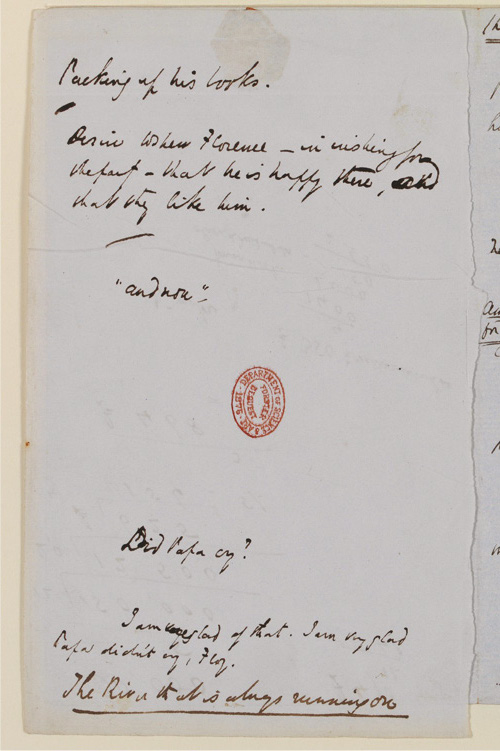
Image No.2012FE1496 (reduced and cropped): Forster Collection, National Art Library, Victoria and Albert Museum (2015). © Victoria and Albert Museum, London.
Click here to view a 'zoomifiable' version.
Transcription of Ws.5a
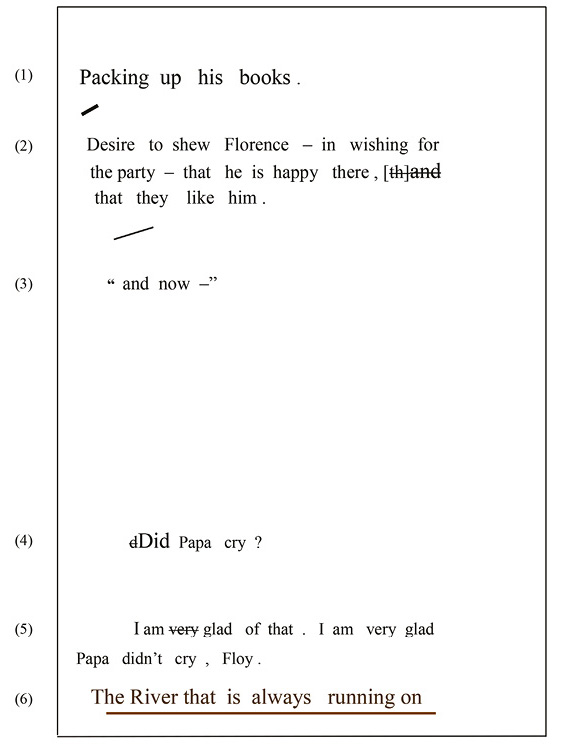
Commentary on Ws.5a
Instead of a number plan for No.5, Dickens prepares an additional leaf, in which all entries are concerned with the presentation of Paul. The entries are similar in hand, quill and ink, and made on the same occasion (except for the final entry). They are spread out so that they fill the page, matching their position in an imagined narrative. He appears to wafer Ws.5a over the unused side of Ws.5, after revising the title of ch.15, and probably after the writing of ch.16 (see above ‘Introduction to Ws.5a’; also ‘Ws.5a’ in the commentary on Ws.5 p.58).
Entry (1)
Dickens begins, in a slightly larger hand, describing an action representative of all of Paul’s preparations for departure that are ways of delaying and coming to terms with loss (see 193205–06).
Entry (2)
Paul’s attachment to and concern for others is noted in language appropriate to him, emphasising the present and in free indirect thought. In the text, his concern becomes more insistent as he declines; it displaces his fears, and increases the reader’s empathy. At the end of the second line of (2), “th” is over-written by a large “and”, which is then smudged and deleted. He removes childlike coordination to emphasise the repeated syntax and monosyllabic choice of word.
Entry (3)
The “and now” is in speech marks to suggest a special function, as if it is an authorial interjection interrupting Paul’s narrative. It marks a decisive stage in Paul’s illness (194207). The blank space below (3) evokes the passage of time and the progress of his sickness in the intervening narrative.
Entry (4) & (5)
In the two penultimate entries, Paul questions Florence about his father’s reaction to his arrival home. The irony of his repeated assertion of his protective feelings for his father provides an endpoint for ch.14 (204219).
Entry (6)
Finally, in a heavier hand (that later corrodes), Dickens adds the always flowing River, underlined as a recurrent symbol. With this addition, the notes—up to this point planned for ch.14—reach into ch.16, where he also repeats the “and now” (220236, 225241) and further develops Paul’s thoughts and gestures in his speeches to Florence about his father (222238, 224240).
The River, as a fact of Nature, a symbol of Time passing and a figurative allusion to death, appears at the chapter’s beginning and at its end. It carries the author’s closing plea “look upon us, angels of young children, with regards not quite estranged, when the swift river bears us to the ocean [too]!”61
Worksheet for No.6
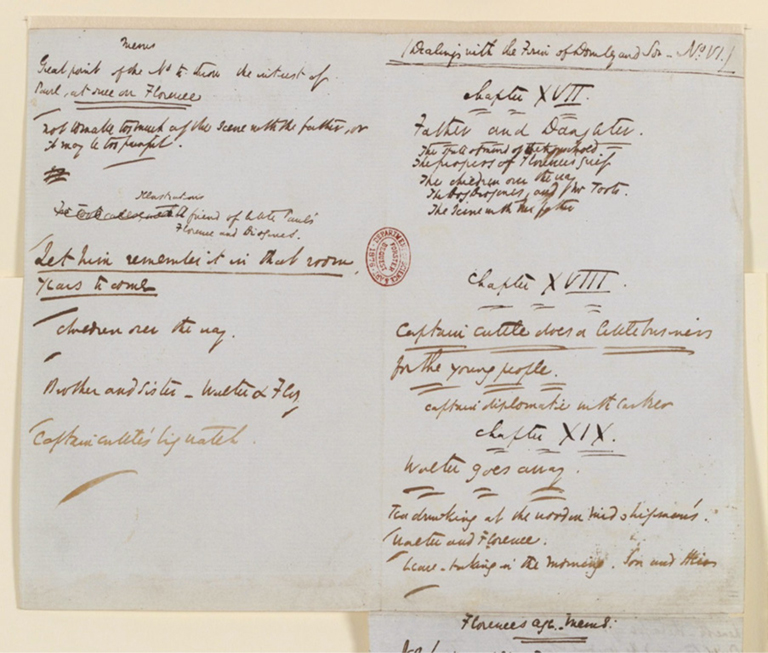
Image No.2012FE1494 recto (reduced): Forster Collection, National Art Library, Victoria and Albert Museum (2015). © Victoria and Albert Museum, London.
Click here to view a 'zoomifiable' version.
Transcription of Ws.6
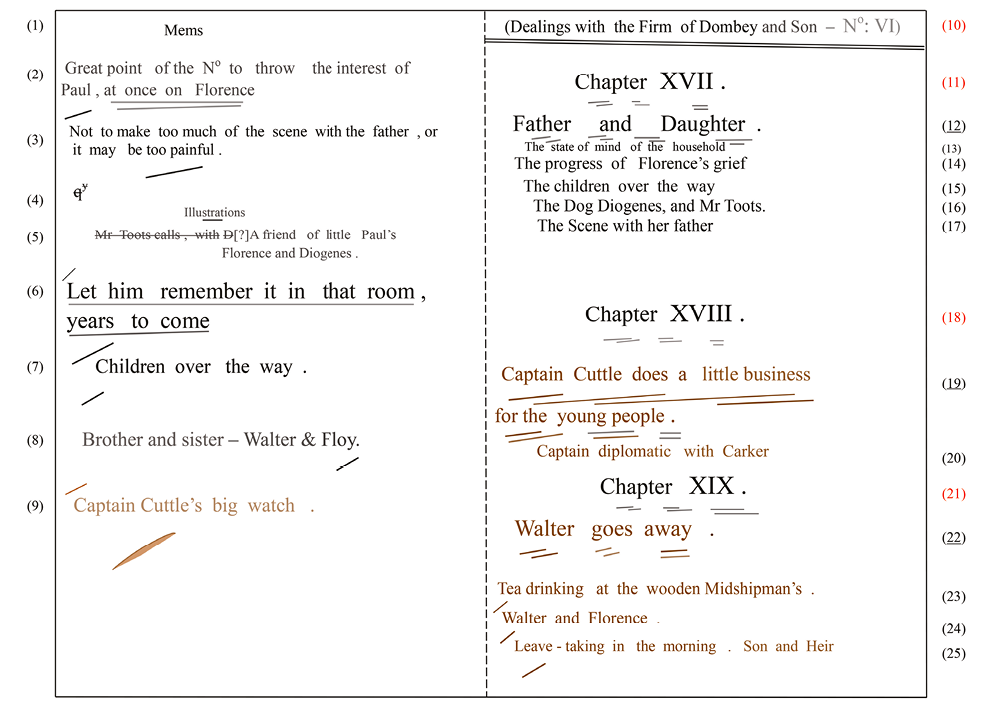
Commentary and order of entry (Ws.6)
Forster left Dickens on 2 February with his writing-table in readiness for No.6. However, on the 4th Dickens writes he is “not under weigh [sic] yet find it very difficult indeed to fall into the new vein of the story […] I will send the chapters as I write them, and you must not wait, of course, for me to read the end in type. To transfer to Florence, instantly, all the previous interest, is what I am aiming at” (Life 481–82K:9446). When Dickens receives the proof of ch.17 (later 18) and ch.18 (later 17), he discovers that the former is more than a page short of what he expected (Life 453nK:9197 n.135). He cannot wait for the proofs of ch.19, so rushes to London from Paris on the 18th to provide more text.62 On 28 February, No.6 for March 1847 is published.
RH
Preliminary headings: (10), (11), (18) & (21)
Dickens’s alignment of the number headings for three chapters slips to the right.
LH
Heading: (1)
He heads the left-hand half “Mems” for the first time. The heading signals that some strategic notes have to do with how the number plan relates to what is to come (see Ws.7, 9, 12, 13 and 15). By contrast, where he is concerned only with the number itself, he may omit a heading (see Ws.16–18). However, the distinction is not made consistently (cf. Ws.8, 10, 11 and 14).
Initial plan for the number: (2), (3), (4), (6) & (7)→ch.17 (later 18)
There are signs—in the changes of hand and positioning—of an untypical hesitancy in selecting and ordering ideas (cf. Horsman 1974, ‘Introduction’, p.xxix). Dickens is troubled by the problem of (2), and makes no mention of Cuttle, leaving the subject of (4) temporarily undecided. He enters (6) with a heavier and larger hand, writing fluently and underlining the whole entry.
Entry (6) anticipates the importance that memory will play in the development of Dombey. However, the content of those memories—their source in crucial scenes between father and daughter—lives so vividly in Dickens’s imagination that, though they are alluded to later, they are seldom planned or even recorded in the worksheets. On this occasion, already aware of the painfulness of the scene, he can only warn himself “not to make too much of it” (3).
Additional number plan: (8)→ch.19
Dickens enters (8) in preparation for ch.19. The young lovers-to-be make their secret relationship more acceptable, to themselves as well as others, by treating it as a close tie between brother and sister. He closes the number plan with a short slash below “Floy”.
MS
Composition and titling of ch.17 (later 18)
Dickens links to ch.16 by opening with the responses to the funeral of the household, office staff, street entertainers and children opposite. Afterwards comes the moment when Dombey miswords Paul’s memorial, the conversation of Chick and Tox, and the comfort they offer Florence—in all, nearly half the chapter, a long lead-in to the solitary Florence. She contemplates the rosy children and their father opposite (7), is distracted by Toots (5), comforted by Diogenes and, on the night prior to his departure, ventures to disturb her father in his study. Surprised, angered and deeply resentful, he lights her ascent on the stairs as before, aware of an earlier similar occasion, but “poisoning” the memory of it with jealous resentment. Dickens keeps the encounter brief, compressing the drama and paring down the exhortatory rhetoric. Revisions show him searching for an inclusive chapter title, but finally choosing to put the emphasis entirely on the closing scene (see ‘Appendix D’, ch.17, p.184).63
RH
Title and summary of ch.17 (later 18): (12), (13), (14), (15), (16) & (17)
Dickens copies in the final version of the title. Omitting the lead-in and writing at speed, he aligns the first entry with the title. He lists four phrases of similar length, structure and rhythm, his arm pulling to the right. They order four parts of the narrative focused on Florence (14–17). Then, noting the role of the household chorus, he inserts (13) almost avoiding the underlines above. Instead he smudges downwards the ‘ou’ of ‘house’, the ‘nd’ of ‘and’, and the ‘a’ of ‘father’, which confirms all five entries were made together, before the ink could dry (shown only in the facsimile; see above).
LH
Further number plan: (5)→ch.17 (later 18)
In his smallest hand, Dickens devises two letterings for illustrations of the chapter he has just completed. Eventually, the first is rejected in favour of the second. (The second plate’s subject, also involving Florence, is found later from ch.19; see ‘List of plates/illustrations’ (lviiilix)).
MS
Composition and titling of ch.18 (later 17)
The title is entered at the start of composition and not revised.
List: [6]
Dickens copies in the headings for chs.17 and 18 (as numbered before their reversal at proof stage) together with a chapter number heading for ch.19 mistakenly entered as ch.9. The omission of a title confirms that these entries are made prior to the composition and titling of ch.19.
MS
Composition and titling of ch.19
Dickens leaves an empty line for a title, a ‘gapping’ tactic used in composition for the first time, and often employed in subsequent chapters. He had devised the ploy in Ws.4 in titling the closing ch.13 (see p.53).
Beginning the chapter on MS p.21, he has sufficient space to preface Florence’s unexpected visit to the Shop with the details of Walter’s recent contact with Susan. The lovers struggle to convey their feelings. When Florence gives him the purse she made for Paul “with money in it”, Walter “would have left without speaking, for now he felt what parting was” (263284). Next morning, amidst the final farewells, he refuses Cuttle’s gift of the watch. Dickens ends on MS p.27 (a half page, like MS p.13 at the end of ch.17).
RH
Title and summary for ch.18 (later 17): (19) & (20)
Title and summary of ch.19: (22), (23), (24) & (25)
LH
Memo: (9)
Progressive corrosion—perhaps re-dipping at (22)—and similarities of hand, suggests the order of entry is as above (19)–(25) plus (9). He memos the gift of the watch (cf. ch.10), for use in later numbers, finishing with a flourish as the quill runs dry.
Proofs
As chs.17 and 18 in their different ways both recall ch.16, Dickens can open the number with either. He transposes them, perhaps to avoid two consecutive numbers involving Cuttle and/or to enclose a “painful” scene within lighter material. He expects ch.17 (now 18) to be 15 or 16 printed pages, but finds the proofs to be only 14. Later chapters add to the shortfall. After rushing to the London office from Paris, he makes five insertions in ch.19, the last two being the most significant: Florence’s conversation with Walter about her father’s dislike of him, as a motive for sending him away (262–63282–83), and the meeting with John Carker (264–65285–86), a farewell that anticipates a shift of emphasis in the latter’s function, from a parallel to Walter to a contrast with James.64
Facsimile of Ws.6a
(recto)
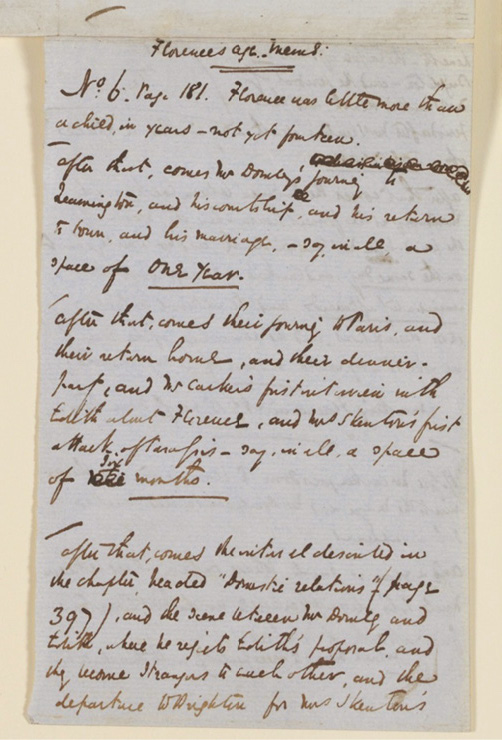
Image No.2012FE1494 recto (reduced): Forster Collection, National Art Library, Victoria and Albert Museum (2015). © Victoria and Albert Museum, London.
Click here to view a 'zoomifiable' version.
(verso)
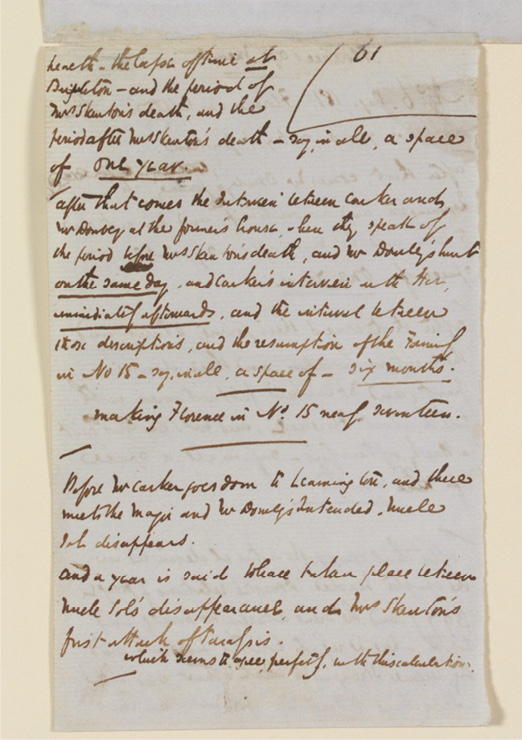
Image No.2012FE1494 verso (reduced): Forster Collection, National Art Library, Victoria and Albert Museum (2015). © Victoria and Albert Museum, London.
Click here to view a 'zoomifiable' version.
Transcription of Ws.6a
(recto)
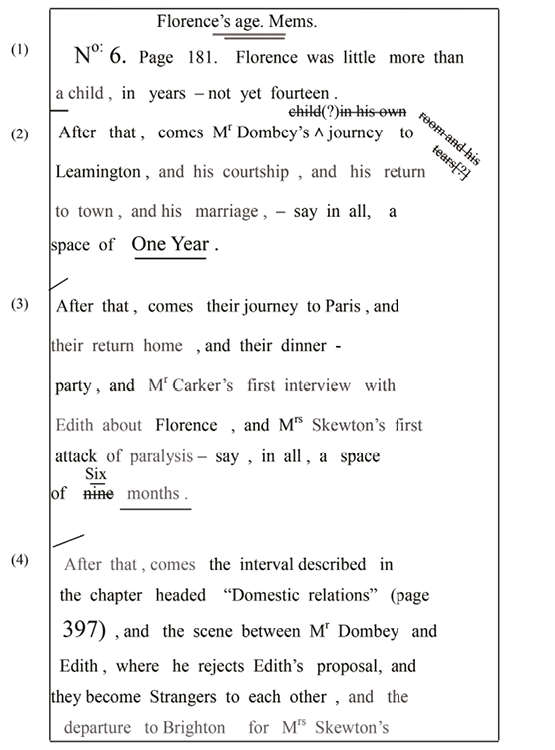
(verso)
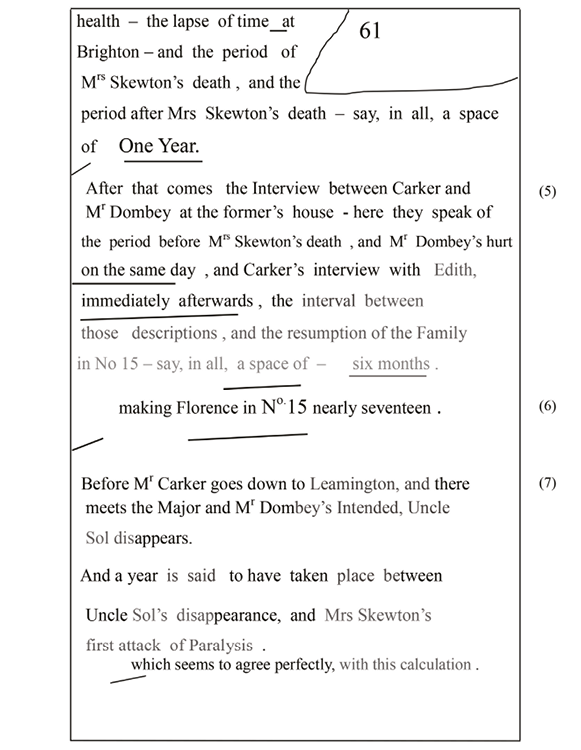
Commentary on Ws.6a (recto and verso)
The additional leaf entitled “Florence’s age. Mems” is attached to Ws.6, pasted by its top edge to the underside of Ws.6, probably because of its opening reference to that number (see the facsimile of Ws.6, p.62). However, the sheet written on both sides was always kept as a loose leaf by Dickens. Closely connected to the beginning of the narrative in No.15, it might be more appropriately attached to Ws.15. The quill and ink appear erratic in flow, perhaps due to a poor barrel and/or sullied ink. The density of the hand fluctuates irregularly throughout, the fluctuation becoming more frequent towards the end.
Aim and method
As the focus of the story changes from one group of characters to another, Dickens suspects that his management of time may lead to inconsistencies. His concern is with accuracy rather than likelihood. The purpose is to check that Florence could be almost seventeen years old at the start of No.15 (621686), that he can make her seventeen during ch.47 (624689), and that the year’s gap between Sol’s disappearance and Mrs Skewton’s first attack is generally consistent. His method is to collate the duration of the episodes as well as the interval between them, using the relevant worksheets and parts published so far.
[Editor’s note: references to the Clarendon text are by page alone, giving the page in the hardback, ed. Horsman 1974, then the page (superscripted) in the paperback, ed. Horsman 2008, superscripted (see ‘References (1)’, p.7)].
Entry (1)
Dickens begins with a moment in the aftermath to Paul’s death, when “Florence was little more than a child in years—not yet fourteen” giving her age as in the published text, rather than the manuscript, which differs in wording.65 He has reason to recall his starting point (1). It was a significant moment in the progress of Dombey’s relationship with Florence. During preparation for the scene, he had warned himself that it “may be too painful” (Ws.63), and at proofing moved the chapter from its opening position to the middle of the number. So, familiar with the occasion, he may scan the worksheets to find “the Scene with her father” (Ws.617) on the evening of the funeral. From there, going to his copy of No.6—perhaps delayed for a moment until he recalls that chs.17 and 18 were later transposed—he finds the relevant quotation on “p.181” (251270). Giving the printed page of the quotation as “p.181 No.6” establishes his reliance on the back number.
Entry (2)
He then calculates the gap between the departure for Leamington and the marriage. Considerations include, as a starting point, Floy’s visit to Dombey’s room, and afterwards his solitary tears of grief, triggered by the sight of her climbing the stairs alone (pp.182–83 of the part issue).66 Powerful for its compression of feeling, the scene adds nothing to the prosaic calculation of time passing, so the allusion is deleted. A glance at Ws.7 for the journey, Ws.9 for the courtship and Ws.10 for the wedding would confirm “One year” as a reasonable estimate of the first interval. The events referred to in (2) are prominent in Ws.7, 9 and 10.
Entry (3)
The second interval covers the return from Paris to Mrs Skewton’s first attack, to be found in No.12. The calculation depends partly on the untimed gap between the return from the three weeks in Paris and the “at home”. That occasion is soon followed by Mrs Skewton’s stroke, whose convalescence, Dickens hopes, can be made to concur with the first wedding anniversary. He stretches the next interval to nine months then later amends it to “Six months”.
Entry (4)
Dickens refers to ch.40 by chapter title and opening “p.397” in the part issue for No.13. The chapter “describes an interval” during which Dombey confronts Edith in her bedroom (he perhaps turns on to p.399). With the rejection of Edith’s proposal “they become Strangers to each other”, an echo of Edith’s last words “Nothing can makes us stranger to each other than we are” (p.404). From this moment, he resumes tracing the interval in the rest of the part. From the quarrel in the bedroom and the departure of Mrs Skewton, Florence, and Edith for Brighton to the time spent there and Mrs Skewton death and her “convenient” burial in Brighton (ch.41), he estimates the interval to be “One Year”.
In contrast to entries (1) and (2), many of the details he refers to in entries (3) and (4) are not mentioned in the worksheets. Instead, when he calculates the intervals from the return from Paris to Mrs Skewton’s death, he relies on two recent back numbers Nos.12 and 13.
Entry (5)
He recounts the events of the day that opens No.14, the instalment he has just completed: Dombey’s exchanges with Carker at his home, the mention of the time before Mrs Skewton’s death (when Carker witnessed Dombey’s first rebuke to Edith see p.569627), the accident and Carker’s interview with Edith—all on the same day. From these events to the dinner on the day preceding the second wedding anniversary, he estimates to be “six months”.
Entry (6)
Taking (1)-(5) together, an interval of about three years, he finds that it is possible for Florence to be “nearly seventeen” at the start of ch.48 (later 47).
Entry (7)
Finally he ties in the Sol/Cuttle subplot. He notes that Sol’s disappearance, discovered in the last chapter of No.8 (ch.25), is prior to Carker’s appearance in Leamington in the first chapter of No.9 (ch.26), and that the gap between Sol’s disappearance and Mrs Skewton’s first attack “is said” to be one year. There is no explicit statement defining the interval—Dickens uses “said” to mean ‘said by implication’.67
Dickens is now prepared, having checked the timeline in Ws.6a, to make its coherence more apparent to the reader. He is particularly concerned that the elopement should occur on the day of the second wedding anniversary, as an expression of Edith’s bitter hostility to Dombey (Ws.152). He continues ch.47 by recapitulating Florence’s experience up to the final quarrel. The new hope—to be loved by her father—is now after “nearly two years” quite gone. In its place, she clings to an idea of the father, dreaming of a man “to cherish and protect her”, a change in her consciousness, which “like the change from childhood to womanhood” occurs when she is “almost seventeen” (621686). She grows to be seventeen a few pages later (624689). Visitors to the house hardly notice her. When they do, they think her pretty, but withdrawn.
Dickens buries his calculations in his description of Florence’s apprehension:
None the less so [“delicate and thoughtful in appearance”], certainly, for her life of the last six months (after the accident), Florence took her seat at the dinner-table, on the day before the second anniversary of her father’s marriage to Edith (Mrs Skewton had been lying stricken with paralysis when the first came round), with an uneasiness, amounting to dread (625690-91).
The interpolated leaf Ws.6a shows that Dickens uses the worksheets to remind him of the content of more distant numbers and to help him retrieve detail in the pages of the part to which they refer. However, for the detail of the more recent numbers, including the number just published, as we might expect, he relies more on the parts themselves.
Worksheet for No.7
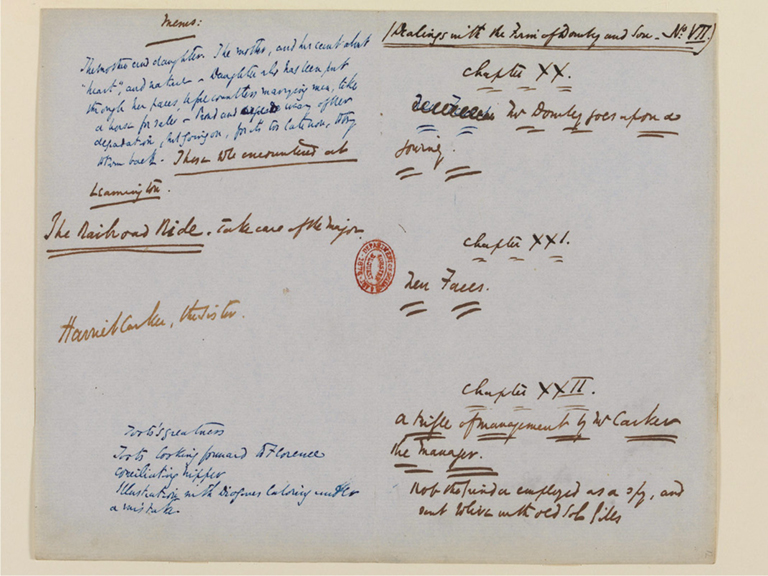
Image No.2012FE1498 (reduced): Forster Collection, National Art Library, Victoria and Albert Museum (2015). © Victoria and Albert Museum, London.
Click here to view a 'zoomifiable' version.
Transcription of Ws.7
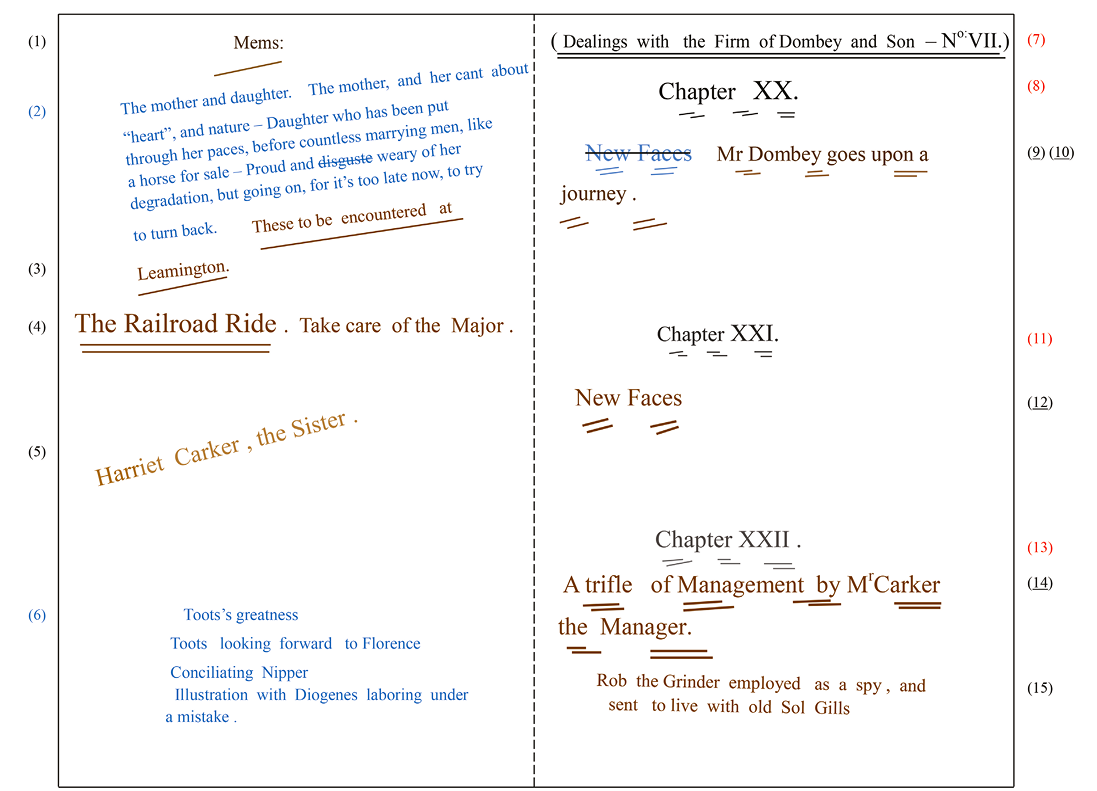
Commentary and order of entry (Ws.7)
Once back in Paris at the end of February, Dickens is overtaken by another crisis. Charley his eldest, contracting scarlet fever at his boarding school in the Strand, is quarantined and has to be nursed. He returns to make the arrangements and get accommodation for the family. For the first time, he begins a number well into the second week of the month, probably starting on 10 March—“the moment we got housed here, I fell into a dream of work, from which I only awoke last night”—and finishing on 23 March (L5:33 and 41). On this occasion near the office, he finishes his task close to the printer’s deadline. On 31 March No.7 for April 1847 is published.
Preliminary: (2)
This unique entry, the backstory of Edith, is quite unlike any other in its position on the page and in the fullness of its detail. Some of that detail will re-appear in the second half of ch.20 (later ch.21), some not until ch.27. Perhaps using the opportunity to test the quality of a new ink and quill, Dickens writes in the bright blue ink that he intends to use in the number’s composition. The order of entry proposed here minimises the ink changes and keeps consecutive all of the following: the other five blue entries in Ws.7, the corresponding chapters in the manuscript, and the relevant entries in the “List of Chapter Headings”. Further argument for a single entry in blue (Ws.72), with all remaining entries consecutive, runs as follows: (1) judging from the blue inks used later elsewhere, the available blue inks are variable in quality (2) Dickens uncertain of the ink’s quality may be testing it, before using blue of any sort in the manuscript for the first time (3) the bright blue seems to flow more smoothly and dry more quickly (4) having tested it, as the supply is probably uncertain, he restricts its use in the worksheet to those entries that he makes while composing chs.20 (later 20 and 21) and 22.68
RH
Preliminary headings: (7), (8), (11) & (13)
Dickens as usual makes the worksheet entries in black with some progressive loss of density.69
LH
Preliminary heading: (1)
Initial plan for the number: (3) & (4)→ch.20
Dickens now using black ink incorporates the mother and daughter back-story into his plan for the setting (3) and heavily stresses the importance of the railroad (4) with large lettering and double underlining, anticipating its recurrence as setting and symbol. He warns himself to attend to the key figure of the Mephistophelean Major, but perhaps not to overdo his bluster (4). The idea of a second marriage is hinted at in the cover design of the green wrapper by an altar scene involving a shadowy military figure, who becomes the “Old Major” of ch.7 (Ws.216 p.43). Dickens had already made preparations for No.7; during his struggles with No.6, he wrote to Forster “I think I shall manage Dombey’s second wife (introduced by the Major), and the beginning of that business in his present state of mind, very naturally and well” (endnote 62).
Titling and composition of ch.20 (later chs.20 and 21): (9)
Returning to the bright blue ink and quill, Dickens confident in his choice of title enters it in both manuscript and worksheet. On the same day that he starts the chapter, he writes a long letter to Browne about illustrating Dombey’s first meeting with Edith (see below p.136).
List: [6/7]
Still in blue he corrects the numbering of ch.19, adds its title, and copies to the “List of Chapter Headings” the number heading and the initial title of ch.20 (see p.176).
MS and Proofs
Composition and titling of ch.21 (later 22)
Corrections to the Proofs of ch.20
Dickens completes the fifteen MS pages of ch.20 on about 18 March, sends it to the printers and begins ch.21 (later 22).70 Receiving the proofs two or three days later, he is far enough into ch.21 (later 22) to know that it will become the closing chapter. On reading ch.20 in print, he divides the chapter, perhaps because it falls naturally into two parts but also because it seems too long (cf. Ws.128 p.91). Deleting the “New Faces”, he re-titles ch.20 “Mr Dombey goes upon a journey”; then, after “with the Major arm-in-arm”, he inserts the heading for a new ch.21 entitled “New Faces”. He can then return to MS p.16 to change ch.21 to ch.22 by adding a Roman ‘I’ to “XXI”.
In ch.22, Carker weaves his web, in some way touching each of the lives of John and Harriet, Sol and Walter, and Rob and Polly. After making one revision, Dickens finds an appropriately ironic title (see ‘Appendix D’, ch.22, p.185). With “the business of the day accomplished” Carker rides home, contemplating the daughter almost grown into a young woman (304330).
LH
Additional plan to extend the close of ch.22: (6)
Dickens may initially have intended to end with Carker’s reverie on horseback (as in chs.24 and 31). However, after following Carker through the day, he misjudges the approach to the ending. Raw from the mistake in No.6, he perhaps fears he is coming up short again. So breaking off from composition and having rehearsed in his mind’s eye a Toots episode, he notes its ‘salient points’ on the lower left side of the worksheet, still using the blue ink and quill. He then seizes on the episode as material for a contrasting second illustration.71
MS
Composition of an extension to ch.22
Dickens goes back in time to get a satisfactory lead-in to the climax (see “a few digressive words are necessary” (305330)). From then on, he transforms the passage into a sharply comic scene. Identifying with each character in turn—even with the dog—he paces the narrative to its close as planned.72
Titles for ch.20 & 21: (10), & (12)
Now using black ink, Dickens updates the worksheet entries in line with changes in proofs. Deleting the “New Faces”, he retitles ch.20 “Mr Dombey goes upon a journey” and uses its initial title for ch.21, in which Dombey meets the ‘new faces’ for the first time.
Title and summary note for ch.22: (14) & (15)
Dickens copies in the title (14) as revised in manuscript, adding the description, a plot device (15) that establishes a link between Sol’s shop and Carker.
LH
Memo: (5)→ch.22
In ch.22 the Carker brothers recount Harriet’s story (293–94317–18). This note of her mention is corroded, the ink probably thinning as the quill empties. It is another final entry—made after composing ch.22—serving as a reminder of the location of her backstory.
Proofs
Proofs show that, although the manuscript ends on p.26, the number is over, rather than under, written. In contrast, the manuscript of the previous number, which ended on p.27, was short by two pages of print. The discrepancy arises from differences in the amount of empty space and in the number of deletions in No.6 compared to No.7. Dickens makes three small cuts: two cuts to ch.20, one to ch.22 and increases the number of lines per page (Horsman 1974, p.270 n.1, p.278 n.4, and p.289 n.2).73
Worksheet for No.8
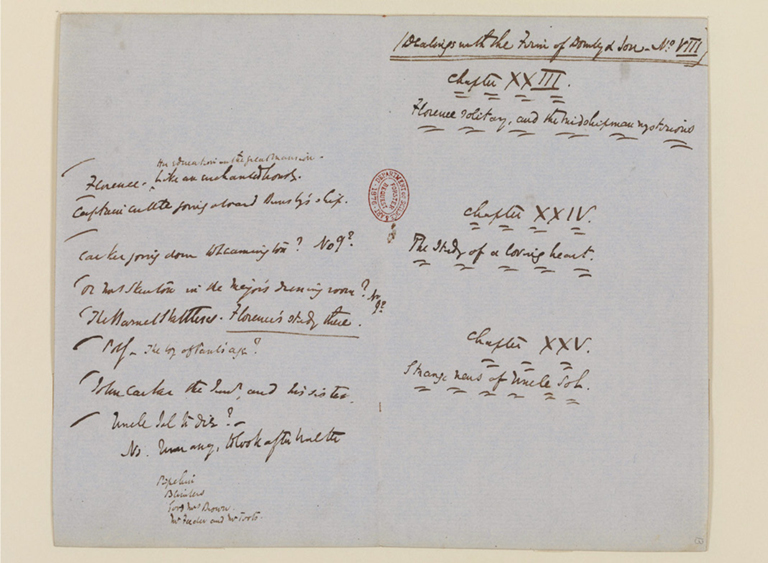
Image No.2012FE1499 (reduced): Forster Collection, National Art Library, Victoria and Albert Museum (2015). © Victoria and Albert Museum, London.
Click here to view a 'zoomifiable' version.
Transcription of Ws.8
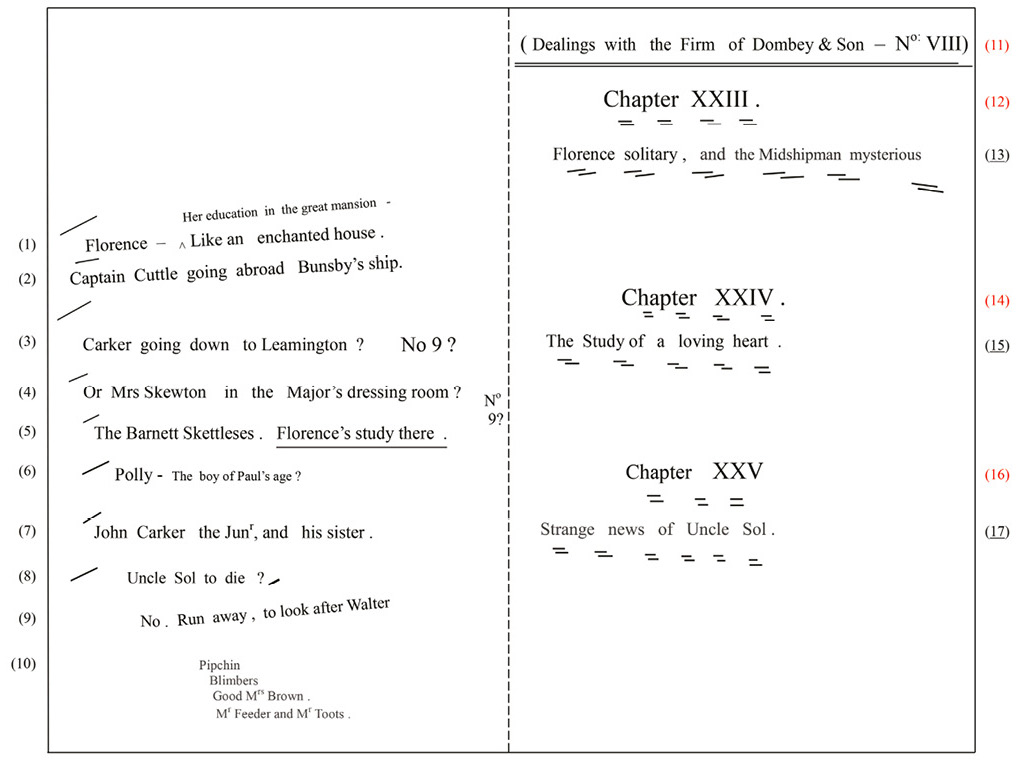
Commentary and order of entry (Ws.8)
Dickens writes to Forster on 10 April 1847, “I have been trying for three or four days, but really have only just begun” (L5:55). On 19 April, he was so shocked by the difficult birth of Sidney, his seventh child, that on the 20th “with half of the No [chs.24 & 25] yet to write – with my thoughts so shaken by yesterday” he was unable to “fall to work”. Nevertheless, he has “infinite relish for the story I am mining at” completing the second half by 26 April, when he has “just recovered from convulsions of Dombey after which I can never write legibly” (L5:59–60). Five days later on 30 April, No.8 for May 1847 is published.
LH
Plan for the number: (1) & (2)→ch.23; (3) & (4)→No.9, ch.26; (5)→ch.24; (6); (7)→No.11, ch.33; (8) & (9)→ch.25; (10)
Abandoning previous routines, Dickens omits all preliminaries. He writes without much regard to layout, in a fast hand that slopes unevenly, eliding the shapes of many letters, but with many stops and starts from (5) onwards.
He collects ideas for opening with Florence: the spellbound house as (in an inserted note) the setting of her education (1), then the move from pathos to comedy, much as he did in Ws.6, but this time by means of Cuttle, and then Bunsby (2).
He hesitates over the order and timing of the Leamington material (3) and (4), considering a visit to the Skettles (5)—as a way of extending the portrayal of Florence’s “study” of how to win her father’s love, by ‘studying’ the children of loving fathers that she finds there.
The two queries (3) and (4) precipitate the decision to postpone the courtship to No.9, and therefore the wedding to No.10. This has the obvious advantage of ending the novel’s second quarter with a climax. However, the decision to postpone leads to another problem, how to sustain a number devoted entirely to the isolated Florence.
Other notes are also set aside. The opportunity to fan Dombey’s resentment of the Toodles family—aired in ch.20 (273–75294–97)—by introducing a boy of Paul’s age (6) does not arise. The John/Harriet material of (7) would lose some of its point, if it preceded the development of James Carker. Sol’s death (8) might spoil the celebratory opening of his last bottle of Madeira, planned for the last chapter.
Dickens follows the suggestion of (8) with an emphatic hurried ‘No’ and then, after a small gap, adds that Sol should leave, unexpectedly (9), to search for Walter, and presumably return later. His departure opens the way for Cuttle to become caretaker of the Shop—an important first step in forming the small society that goes “over to the daughter” (see the last paragraph of the outline to Forster endnote 42).
Finally, using his “smallhand” for (10), Dickens lists persons for whom he has some particular intention, noted here as a reminder of their futures, but also as a part of his search for material for the current number:
“Pipchin”: to become the head of Dombey’s household staff (ch.40)
“Blimbers”: to be visited again (ch.41), but during the composition of ch.24 to be reintroduced as guests of the Skettles
“Good Mrs Brown”: to tell the fortunes of Edith and Carker, before the courtship begins (ch.27)
“Mr Feeder and Mr Toots”: now both young men, to meet again (ch.41).
MS
Composition of ch.23
Dickens leaves a blank line for the title and composes the chapter. He draws out Florence’s inner life through her reactions to the accelerated decay of the spellbound house and through her dreams of how to gain her father’s love. Her conversation with Susan about Walter leads to their search for news, and meetings with Rob—a ‘Son and Heir’, whose education has trained him for service as Carker’s spy—with Mrs MacStinger, Cuttle, Bunsby and Sol. Cuttle’s alarm at Sol’s strange behaviour prepares for the opening of the next number.
List: [7/8]
Titling of ch.23
Dickens sometimes updates his “List of Chapter Headings” as he begins writing the next number. When he updates the List on this occasion, he treats it as an opportunity to work on the title for ch.23, revising it, not in Ws or manuscript, but in the List (see ‘Appendix C’ [7/8] p.176). He transfers the final version to the gap left for it in the manuscript, and later to the worksheet (see below).
MS
Composition and titling of ch.24 and ch.25
The objective stated in Ws.62 “to throw the interest of Paul at once on Florence” still poses acute difficulties. In ch.23, Dickens relied on Florence’s reactions to “living alone in the great, dreary house” and her meetings with the company at the Wooden Midshipman. But in ch.24 during her visit to the Skettles, he has to import completely new material—with the inevitable appearance of contrivance—to draw out her state of mind in the continuing search for “the road to a hard parent’s heart”.
Dickens is “anxious not to anticipate in this No what I design for the next [No.9], and consequently must invent and plan for it [in No.8]” (L5:55). His planning successfully delays the courtship but his invention for once appears to fail him, contriving a series of poorly motivated encounters with conveniently long passages of stilted dialogue.
Although he postpones Carker material to No.9, he still has him very much in mind (3). He ends ch.24 with Carker’s offer of a message from Florence to her father (343–44373–74 and its illustration). In the next number, he reports other earlier encounters (ch.28: 383–84419–20).
LH
Outcomes: (3), (4), (6)
Dickens has already given in (9) his answer to (8). He leaves implicit his answer to the other three queries. In later worksheets, where he delays replying, he records outcomes more systematically, presumably to signal clearly what might (or must) be included later.
RH
Preliminaries and chapter titles: (11), (12), (13), (14), (15), (16) & (17)
The fall towards the end of each line, especially the curve of each title down the page (not shown) and the style of underlining used throughout suggest that all entries are made at the same time, in the order of their appearance on the page. It is likely that Dickens entered these headings hurriedly, for the sake of the record, after the number was written. The absence of chapter description arises, as in Ws.7, from the pressure of circumstances. It shows that, at this stage in the development of the worksheet, when he is pressed for time and in difficulty, he reins in planning or summarizing, and relies on chapter headings as a record of the instalment—with the exception in Ws.715, which plants Rob in the shop as Carker’s spy.
Worksheet for No.9
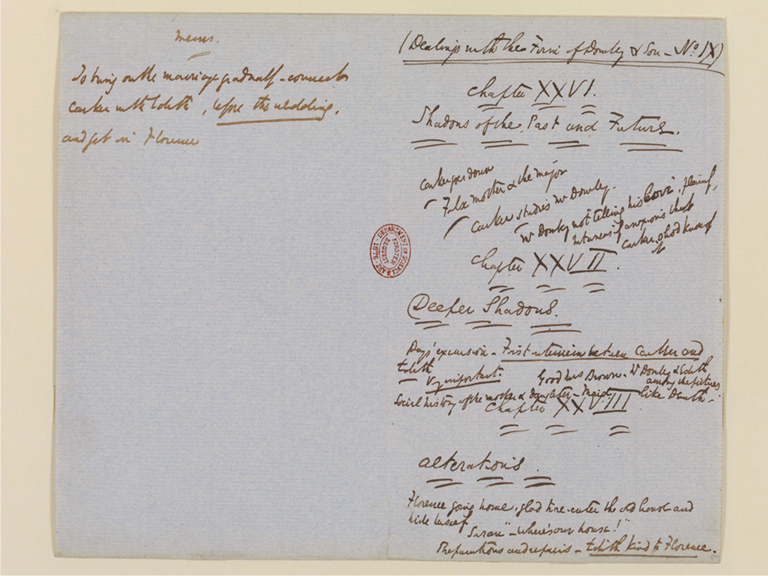
Image No.2012FE1491 (reduced): Forster Collection, National Art Library, Victoria and Albert Museum (2015). © Victoria and Albert Museum, London.
Click here to view a 'zoomifiable' version.
Transcription of Ws.9
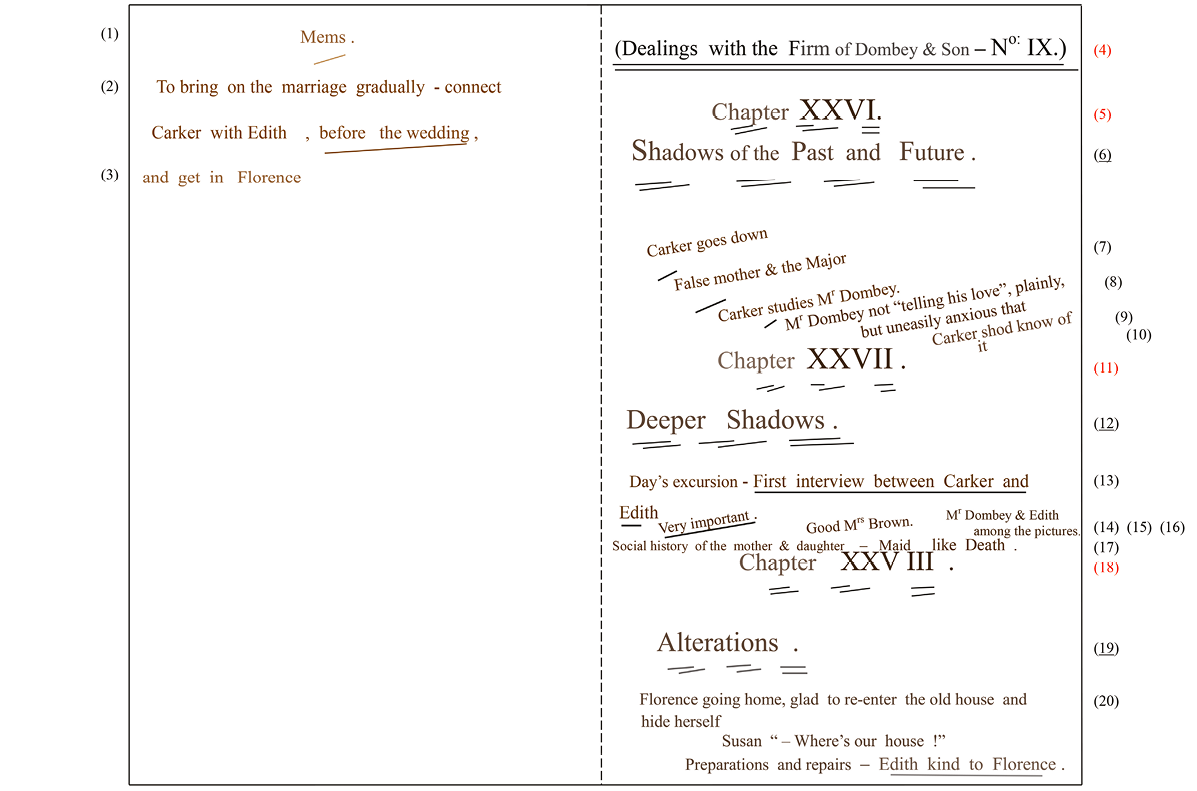
Commentary and order of entry (Ws.9)
Dickens’s misfortune continues. On 3 May, he is bitten by a horse “under the impression I had gone into his stall to steal his corn” (L5:65). It affects him badly “a low dull nervousness of a most distressing kind”, so much so that for two weeks he is unable to write without discomfort (L5:66). He writes only a few short letters before 16 May, making a very slow recovery from 10 May. He is still “very unwell when I left town [for Brighton 17 May], and had not the heart to go at my Number. I have gone since, however, and with such good will that the Number is very nearly gone too [23 May]” (L5:69). In Brighton “for a change” (L5:67), he produces the number in just seven or eight days, an extraordinary achievement (cf. his struggle to finish No.7, starting 10 March). After starting to write the opening ch.26 in black, he changes half way through to a bright blue ink. Presumably reserving his supply of bright blue for the manuscript (cf. his trial of the ink commented on in Ws.7, see ‘LH preliminary’ p.72), he changes back to black to plan both chs.27 and 28. Similar in hand, ink and quill, the plans for chs.27 and 28 seem to be prepared together. He then changes again to compose those chapters in bright blue (cf. the planning of ch.33 and 34 together in Ws.11, also followed later by a final chapter in bright blue). On 31 May, No.9 for June 1847 is published.
RH
Preliminary entries: (4), (5), (11) & (18)
In making these routine entries, Dickens appears to strain somewhat. He writes in a slightly larger hand, with less control than usual (see the wayward “ch” for the middle chapter, and the untypical ampersand in the novel’s title—only found here and in the hurried part heading of Ws.8).
LH
Plan for the number: (1); (2)→ch.27, (3)→ch.28
Sure of the number’s shape and content, Dickens gives himself three brief instructions. All three are concerned with events after the arrival of Carker. Progressive corrosion suggests that (2) is entered first, followed by (3) then (1). As in his preparation for the climax of the first quarter, the balance changes from number to chapter planning that is mainly concerned with the outcome of earlier plans.
RH
Plan for ch.26: (7), (8), (9) & (10)
Dickens leaves a gap for the title, entering four salient points in the usual black that cover the first half of the chapter: Carker has made the journey (7), the false Mrs Skewton and scheming Major conspire together (8), Carker closely watches Dombey’s reactions (9), and Dombey seeks to get Carker’s understanding without revealing himself (10). In composition the plan is reordered and Bagstock’s part is enlarged to include his assessment of Edith and his rivalry with Carker for influence over Dombey.
MS
Composition of first half of ch.26 in black ink
Leaving the chapter untitled, Dickens begins in the middle of the introductions. He follows the order of his plan, except for the meeting of Bagstock with Mrs Skewton, held back for the long central section of the chapter, during which he breaks off to write in blue.
Composition of second half of ch.26 and its titling
While writing the second half of the chapter, he inserts the most teasingly oblique title thus far (the blue of the title confirms its late entry). The action follows Bagstock to his meeting with the “False mother” in the longest episode of the chapter, which dramatizes the duplicity of Bagstock and Mrs Skewton, an old acquaintance (one of the “shadows of the past”). On his way back to the hotel, he reflects on Edith’s obvious reluctance (a “shadow of the future”). Dickens makes the competitiveness explicit between Bagstock and Carker, showing the latter to be the better game player. Making such a late start, as soon as the chapter is completed, Dickens probably sends it at once to the printers to give more time to set up and run off proofs.
Plan for ch.27: (13), (14), (15), (16) & (17)
Plan for ch.28: (20)
Both chapter plans are written in a similar hand with the same ink and quill. Both leave a similarly generous space for the chapter title, and, uneven in layout, have their final entry pressed up against a boundary (the next chapter number and page bottom respectively).
In ch.27, Dickens misplaces (13) and, instead of reordering, adds the emphasis of (14). Mrs Brown deepens the mystery (15). The courting couple become a picture themselves, as they view the sights (16). The “social history” (17), noted in Ws.72, leads to a closing tableau “Maid…like Death”, the words separated so as not to overwrite the much extended top ligature of “III”. He lays out and sizes the entries to show the order of events as he imagines it, assembling his ideas in a way typical of his planning method.
In ch.28, as he often does, Dickens leaves the opening material unplanned, concentrating instead on the approach to the end (Florence’s return with Susan, their expectations, surprise and disorientation), and ending chapter (and number) with Edith’s loving treatment of Florence, underlined for its future significance.
MS
Composition and titling of ch.27
Dickens resumes with blue ink and quill. The outing determines the shape of the day, its settings and characters (13). He uses the portrayal and viewpoint of Carker to carry the opening narrative (14). Good Mrs Brown’s curses hint at what she knows of Carker’s “deeper shadow”; she can also guess what is to come (15). The picture presented of Edith and Dombey, viewed from a distance by Bagstock, Carker and the mother, circumvents the difficulty of presenting directly the interaction of the unlikely couple (16). Throughout the day, any momentary contact between Carker and Edith is pregnant with their shared consciousness of the earlier meeting. As Dickens often does with backstories, he delivers Edith’s history (17)—another “deeper shadow”—through dialogue, in the bitterly frank exchanges between mother and daughter that ends the chapter.
List: [8/9]
Still in blue, Dickens transfers headings for chs.24–27
MS
Composition and titling of ch.2874
Always aware, towards the end of a number, of the position of each chapter within his allowance of twenty-seven to twenty-eight manuscript pages, Dickens has leeway, beginning on manuscript p.21, to delay the “going home” for the printed equivalent of four and three-quarter pages out of the remaining seven and a half (383–89419–25). Once home, he focuses on Florence as he accelerates the narrative to its close. In the relationship between Florence and Edith, he dramatises the intensity of latter’s “kindness” that will later strengthen Dombey’s jealous resentment and lead to Edith’s determination to protect Florence—understated, but implicit in the underlining of the final entry “Edith kind to Florence” (20).
Titles of chs.26, 27 & 28: (6), (12) & (19)
Alignment, underlining and size of the rounded hand may be a reaction to the strain of composition, though Dickens often finds it difficult to write legibly “after convulsions of Dombey” (L5:59–60). Similarity suggests that all three titles are entered at the same time. Writing in black, with unusual slow deliberation, he spreads their entry to fill the space left for them, thus completing the record of the worksheet.
Proofs
Dickens returns to town for the day on 27 May to correct the proofs (none are extant). Differences between manuscript and text show that all chapters are only lightly corrected.75
Worksheet for No.10
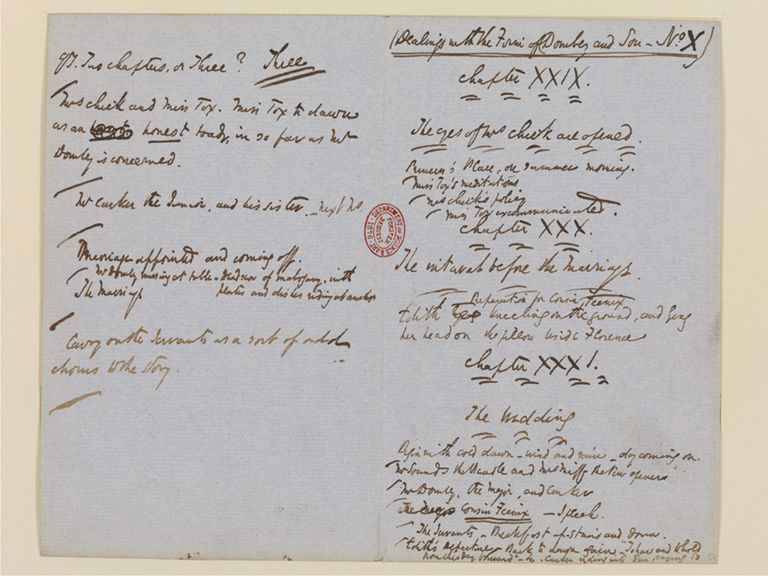
Image No.2012FE1497 (reduced): Forster Collection, National Art Library, Victoria and Albert Museum (2015). © Victoria and Albert Museum, London.
Click here to view a 'zoomifiable' version.
Transcription of Ws.10
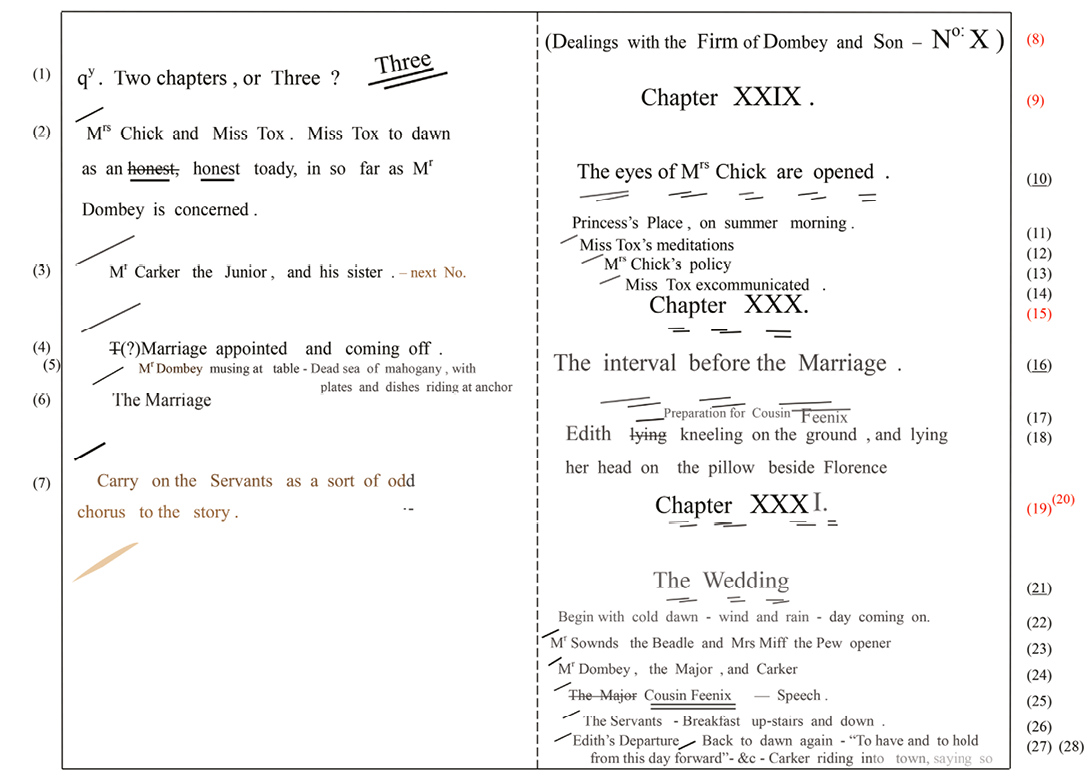
Commentary and order of entry (Ws.10)
Dickens begins on 13 June and by the 21st has finished ch.30 and sent it to the printers. “Bidden tomorrow to the marriage of a friend of mine”, he begins ch.31 the next day (L5:96). On the 24th he hopes to finish in time for a celebratory dinner, but is interrupted, and has “to sit down at my desk again, and give the finishing dig at Dombey in a vicious despair” (L5:98). The speed of his work confirms Forster’s comment that “the interest and passion of the story, when both became centred in Florence and Edith Dombey, took stronger hold of him than any of his previous writings, except only the close of the Old Curiosity Shop” (Life 482K:9462).76 On 30 June, No.10 for July 1847 is published.
RH
Preliminary headings: (8), (9) & (19)
Dickens positions the two chapter number headings so that twice the space is allocated to the first chapter, making the last chapter the shorter one (just as he may have done initially for Ws.7).
LH
Plan for the number: (1); (2)→ch.29, (3)→(ch.33); (4) & (5)→ch.30; (6)→ ch.31
Dickens considers the two-chapter arrangement, looking for the shorter closing chapter in (2) or (3). However, at entry (4), he may begin to write “T[he marriage(?)]”, apparently stopping his hand, when on reflection, he realises that the marriage might fall easily into two, the wedding preparations (4) and the wedding itself (6). So he converts the opening down stroke of “T” to the first stroke of “Marriage” and finishes with “appointed and coming off”. He adds the next entry “The Marriage”, re-aligning it and emphasising the change with a slash between the two entries. The addition forms a new middle chapter. He decides to open with the shorter chapter and close with the wedding. Mrs Chick’s cruel pretense of shock at Miss Tox’s disappointed hopes (2) can then become a prelude to the marriage arrangements of the middle chapter. Miss Tox’s dawning honesty promises further development.
Adding the insertion (5)—Dombey’s “musings at […] the dead sea of mahogany”—reveals the priority that this moment has in Dickens’s creation of the new chapter; the reverie gives a rare insight into Dombey’s deepest feelings towards Florence.
LH and RH
Outcome of (2)
With a full quill, he replies with an assured “Three” underlined twice.
Change to chapter number headings: (15) & (20)
Dickens converts the number heading of ch.30 to 31 (20) and inserts a number heading for the new ch.30. The change is revealed by the misalignment of the added ‘I’ and its underline; the ‘I’ may also cover the stop that initially followed “XXX” (see the facsimile of Ws.10 above, and cf. Ws.7 p.71).
MS
Composition and titling of ch.29
Dickens enters a title at the start, then during composition revises it for the first time (see ‘Appendix D’, ch.29 p.185).
RH
Title and summary of ch.29: (10), (11), (12), (13) & (14)
Dickens copies in the title with its first revision. In an orderly set of similar phrases, he enters a summary note for each section.
MS
Second revision to the title of ch.29
When Dickens provides Browne with the lettering of the first illustration “The eyes of Mrs Chick are opened to Lucretia Tox”, he returns to the manuscript to revise the title for ch.29 a second time, presumably to avoid repeating the wording of the lettering. He does not copy to the worksheet, perhaps considering it not worth recording. The chapter goes at once to the printers.
RH
Plan for ch.30: (18)
Leaving a gap for the title, Dickens begins by entering the end plan, the text of the chapter’s final tableau of Edith and Florence, revising it as he does so (18).
MS and RH
Composition and titling of ch.30: (16)
Dickens enters a title at the start of composition, later revises it, then copies the revision to the worksheet (see ‘Appendix D’, ch.30, p.186). He develops Edith’s protectiveness of Florence, the satire of false feeling and aristocratic affectation in Mrs Skewton’s preparations at Brooke Street and, through Dombey’s reverie after dinner alone at the table, his apprehension and guilt over Florence (5).
Memo: (17)
Dickens later inserts entry (17), overwriting slightly one of the title’s underlines and defining it as a separate entry with a diagonal slash. The “preparation” refers to the paragraph on “Brooke-street, Grosvenor-square” (410449–50). Already identified in ch.21 as Mrs Skewton’s nephew, and Edith’s cousin (286309), Feenix is linked to the Brook Street house, being “one of the Feenix brood”, in preparation for his role here as ‘father’ of the bride, and later as head of the family.77
Plan and titling of ch.31: (21), (22), (23), (24), (25), (26), (27) & (28)
The most inclusive through plan thus far covers one full day, dawn (22) to dawn (28). When Dickens re-allocates the wedding speech to Feenix, he enlarges his conception of the character as a ditherer in language as well as action (25). Another day brings the ritual of the wedding of another ill matched couple, and Carker’s mockery of the marriage vows to “have and hold” [editor’s italics], as he rides to the City (cf. chs.22 and 24).
MS
Composition and title of ch.31
Dickens draws together the first half of the novel using many retrospective references. All are present at the wedding that can be, including Good Mrs Brown (also given a small part in the very detailed illustration). Making the climatic finale the longest chapter is in contrast to most previous numbers; the notable exception is ch.22, which—like ch.31—began as the second chapter in a two-chapter experiment (for chapter length, see ‘Appendix A’, p.165).
List: [9/10]
Dickens transfers the headings for chs.28–31 to the List. He begins by giving the title of ch.29 to ch.28, forgetting the omission of “Alterations” in [8/9]. He corrects the error and completes the headings up to and including ch.31, marking the end of the first half.
LH
Outcome: (3)
The thread associated with John and Harriet, crucial to the plotting of the novel, is postponed again, this time to No.11 (cf. Ws.87 p.75).
Memo: (7)
Probably entering (3) and (7) at the same time—the corrosion of (3) matches that of (7)—he adds a note on using household servants as “a sort of odd chorus”, a reminder to voice their reactions in the second half, as he did in the first half (cf. the other forward-looking lower left-hand memos in Ws.69 p.63, Ws.75 p.71 and Ws.810 p.75). He finishes with a flourish, perhaps of exasperation (see opening biographical detail).
Proofs
Dickens is determined that the last two chapters of No.10, the climax of the first half of the novel, should start at the top of the page, without leaving empty spaces. In the proofs he instructs “Mr Jones” to begin chs.30 and 31 on a new page, and to delay both, if more text is needed for ch.30, to achieve the layout that he wanted. His instructions show his concern for page design, a dislike of gaps without function, and his commitment to giving readers what he feels is their due.
Worksheet for No.11
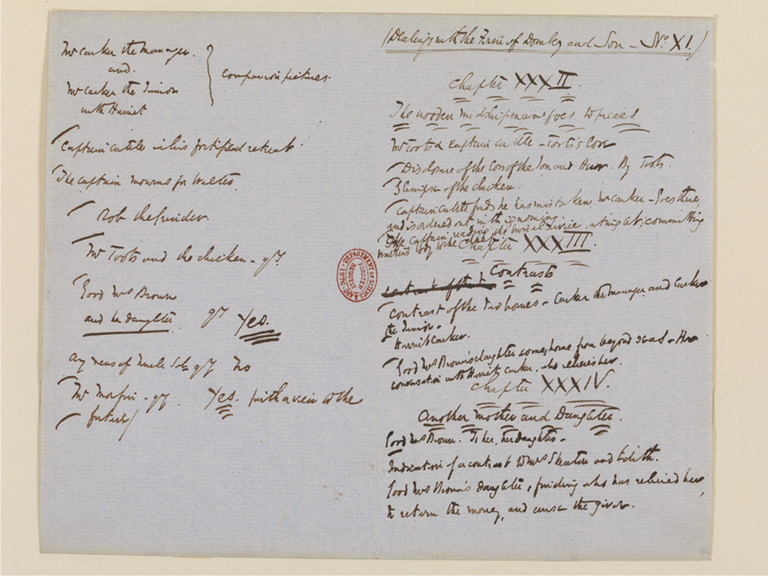
Image No.2012FE1501 (reduced): Forster Collection, National Art Library, Victoria and Albert Museum (2015). © Victoria and Albert Museum, London.
Click here to view a 'zoomifiable' version.
Transcription of Ws.11
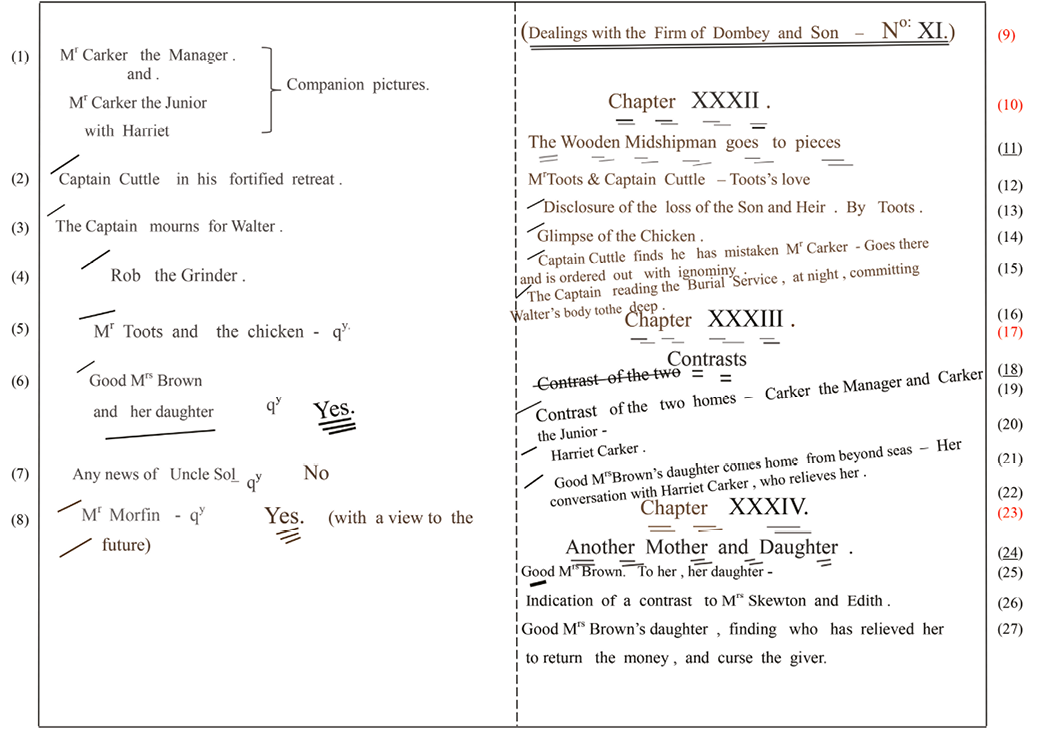
Commentary and order of entry (Ws.11)
Most of Dickens’s July letters are taken up with organising and rehearsing Ben Jonson’s Every Man in his Humour and three farces, to be put on for charity by his largely amateur company of writers and artists, in Manchester on 26 July and in Liverpool on the 28th. The play has similarities in characterisation and plot to Dombey (see Schlicke 185–87).78 Comparatively early, on 2 July, he begins working on the number, with its parallels, contrasts and intrigues “taming a spider or two […] weaving a small web of my own” (L5:96 and 111). He finishes shortly before going north with company (plus wives) on Sunday 25 July (first class, booked by him). On 31 July, No.11 for August 1847 is published.
RH
Preliminary headings: (9), (10), (17) & (23)
Dickens returns to his earlier entry routine (see Ws.2–6).
LH
Plan for the number:
(1)→ch.33; (2), (3), (4) & (5)→ch.32; (6)→ch.34; (7)→ch.32; (8)→ch.33
Most previous worksheets begin the number plan with a note that relates to the opening chapter of the number. Entry (1) is a notable exception. Relating to the middle chapter, it shows Dickens’s interest, at this stage, in contrasting parallels, and in the portrayal of Carker. The two new settings are “companion pictures”, a mockery of a pair of family portraits. The queries added to the last four entries (5)–(8) confirm that all are waiting a decision. The sifting process, evident midway through the previous quarter, occurs here and in the next five worksheets, because Dickens is now preparing not just for No.15 but also for the crises and revelations of the last quarter. He advances three of the four waiting intrigues, thus maintaining suspense in the Dombey and Edith storyline and increasing the reader’s anticipation of their return.
RH
Plan for ch.32: (11), (12), (13), (14), (15) & (16)
The “Wally & Co” narrative has often, in the first half of the novel, taken up the final chapter position of each number. It appears there in Nos.1, 3, 6 and 8 (and in No.9 is displaced entirely by the main plot). In contrast, he now opens with Cuttle’s hopes dashed by the news of Walter’s loss at sea, followed by his humiliating encounter with Carker, juxtaposing grief and disappointment.
Uniformity of layout and hand in title and description suggest that they are entered at the same time. Yet the title in MS is apparently delayed. Perhaps, on this occasion, Dickens having entered the title in the worksheet has some reservations later about his choice.
He takes special care over the chapter. The number plan has more entries than usual concerned with a single chapter (see entries (2)–(5) in preparation for ch.32); the chapter description is also a lengthy plan. He blends the material of both number and chapter plans—a subtle process that incidentally confirms the planning intent of the description. The combination helps him achieve an extraordinary coherence, combining comedy, pathos, dramatic conflict and a muted close. Other indications of planning are: (1) he is unsure of the space the plan needs, hence the cramped final entries (2) he re-orders somewhat in composition; the glimpse of the Chicken comes earlier than the plan implies, and (3) he prepares for the closing text.
MS
Composition and titling of ch.32
Despite the title being given in the worksheet, Dickens leaves a narrow gap for the title, perhaps waiting to see how he might develop the metaphor in the text and improve on the worksheet allusion. He inserts the title during or after composition.
In a long carefully crafted chapter (thirteen MS pages), he opens with bad weather, deepening Cuttle’s depression and foreshadowing Toots’s news. He approaches his plan with exuberant comic invention—the recapitulation (the signal and spy-hole defence against Mrs MacStinger), the clash of the Game Chicken’s sporting jargon, Toots’s confusion of names and person—eventually modulating to Cuttle’s history of Walter and Floy and Toots’s news of the loss of Walter’s ship. He relieves the intense pathos of Cuttle’s elegy with Toots’s response, the dramatic irony of the discovery of Carker’s trickery, and Cuttle’s own solemn consolatory enactment of an imaginary burial at sea.
Plan for ch.33: (19), (20), (21) & (22)
Deletion, and re-entry further down, shows Dickens forgetting then remembering to leave sufficient space for the title (incidentally confirming that the description is entered before the title). He maximises the remaining space by tilting the entries. Harriet’s meeting with Morfin is not mentioned, though it is implied by “with a view to the future” (8), a revealing entry that confirms Dickens is carefully preparing for the intrigue of Morfin and Harriet in the fourth quarter.
Plan for ch.34: (25), (26) & (27)
There is a marked similarity of hand and quill between this description and that of ch.33, which makes it likely, given the strong links between the two actions, that Dickens enters his outline plan for ch.34 at the same time as that of ch.33. The elided wording “to return” suggests intention and therefore planning, as does the re-ordering of “Indication of contrast” (see below). The gap that Dickens leaves for a delayed title entry now tends to be smaller than previously, a sign of his determination to leave more room for chapter planning.
MS
Composition of ch.33
Dickens writes in black ink, leaving a blank line for the title.
Composition and titling of ch.34 and titling of ch.33
Finding a limited supply of bright blue, he uses it to title and compose ch.34. At some point while using the ink, he turns back to MS p.12 to insert the title of ch.33. The “Indication of contrast” (26) is re-ordered and reshaped to end the number.
By closing with an earnest direct address that rhetorically questions Edith and her mother, and through them, the reader, Dickens encourages us to sustain his fictional world into the next instalment.
List: [11]
Using the same bright blue quill-and-ink as he employed in ch.34, Dickens transfers the headings for chs.32–34 to the list, misnumbering ch.34 as ch.24.
Titles of chs.33 and 34: (18) & (24)
LH
Outcomes: (5), (6), (7) & (8)
Dickens returns to black ink to complete the record of the worksheet, entering the titles of chs.33 and 34 together, then moving to the left-hand half to reply to its queries. He answer the first two (5) and (6) with a heavy triply underlined “Yes”, the next (7) with a “No” and the last (8) with a similar “Yes”, the ink apparently thinning (and corroding), as he goes. The three replies show that Dickens is indeed “weaving a web of his own”, establishing a preparatory link between Harriet and Alice, which like the link of Harriet and Morfin looks forward to the last quarter. Similarly, the negation of “Any news of Uncle Sol” (7) may suggest that he also anticipates the explanation of Sol’s protracted silence and its neat tie-in with the MacStinger thread (762–63844–45).
Proofs
Dickens finds that he has calculated his length accurately. Apart from the only longer addition—the sentence on Rob’s sou’wester (453498)—his and Forster’s changes add little to the overall wordage.
Worksheet for No.12
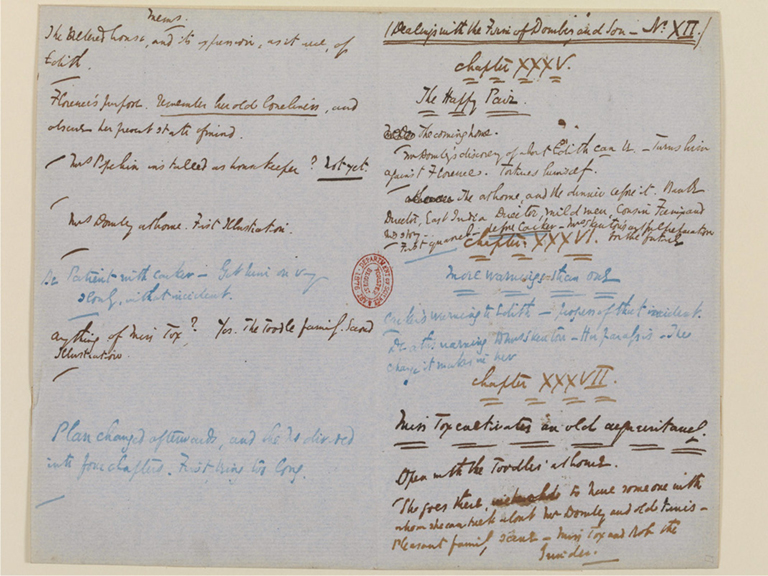
Image No.2012FE1502 (reduced): Forster Collection, National Art Library, Victoria and Albert Museum (2015). © Victoria and Albert Museum, London.
Click here to view a 'zoomifiable' version.
Transcription of Ws.12
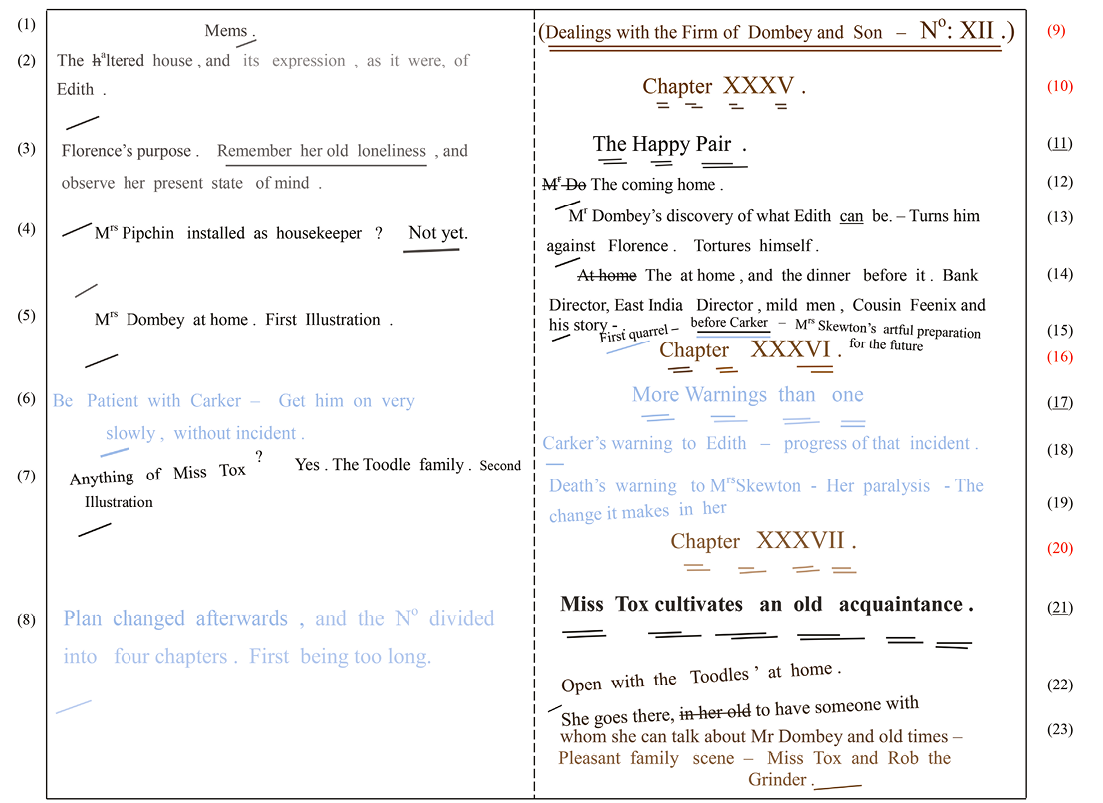
Commentary and order of entry (Ws.12)
Dickens was “still behindhand in my month’s work” on 17 August, being “delayed by other business”, settling bills and accounts of the July productions (L5:150 & 137). He feared that he might have lost “an important chapter”, probably ch.36 (later 37), when his portmanteau fell off the cab on the way to his newly vacated house in Devonshire Terrace on 22 August. He rejoices “Thank God! the MS. of the chapter wasn’t in it. Whenever I travel […] I always carry it in my pocket” (Life 465K:9727).79 While in town 23–27 August, he corrects the second proofs of ch.35 and writes ch.38 (L5:151–53). On 31 August, No.12 for September 1847 is published.
RH
Routine headings: (9), (10), (16) & (20)
Progressive corrosion in the chapter number headings—with movement to the right—confirms that they are entered together.
LH
Preliminary: (1)
Initial plan for the number: (2) & (3)→ch.35 (later 35 & 36); (4); (5)→ch.35 (later 35 & 36)
Dickens looks forward and back. The more luxurious the house is, the more degraded Edith feels (2). He does the same for Florence, contrasting the earlier account in Nos.6 and 8, with her new hopefulness that Edith will help her secure her father’s love (3). Having decided to keep Pipchin in the narrative, Dickens is waiting for the right moment to install her as housekeeper (4). The second half of entry (5) confirms the first subject for illustration, and is perhaps a reminder to give Browne early notice of such a visually busy occasion as the “at home”. Dickens makes no note of the material of ch.36 (later 37) in the number plan, which suggests that he already has in mind how to develop the encounters between Edith and Carker; the relationship’s progress is implicit in the later instruction to himself to “Be patient with Carker” (6). For much the same reason, he makes no mention of his intention for Mrs Skewton.
Additional plan: (7)→ch.38
At the start, Dickens had plans for the development of Miss Tox, which he later discarded (see ‘Outcomes’ p.48). In ch.29, he retains her as “an honest toady” (Ws.102 p.83), later cooling her infatuation of Dombey to a “platonic” concern for his welfare. At this point, probably in anticipation of her supporting role in the fourth quarter, Dickens is looking to remind the reader of her story. Though uncertain at first of the means, he resurrects her relation with the Toodles (see (7) and cf. Ws.28 p.43), thus also keeping the family in the narrative. By economic re-use of characters and by complicating their narrative threads “weaving a small web of my own” (see Ws.11 p.88), Dickens draws attention to the continuing connection between different groups, strengthening the unity of the novel.
RH
Plan and titling of ch.35 (later 35 and 36): (11), (12), (13), (14) & (15)
Dickens is sure of the title, entering it at the start. The first deletion and correction (12) shows him deciding, on second thoughts, to include an opening link to the earlier number, always of concern but usually not planned for, though here included, perhaps on account of the gap created by the intervening No.11. Once more, the grouping of entries and the order of detail anticipate the narrative structure. Although Dickens notes the result of a key moment in the development of Dombey’s inner conflict, the preceding ‘handkerchief’ scene is unmentioned. Like other disturbing scenes between father and daughter, it lives on so vividly in his imagination that it needs no annotation. Instead he notes its outcome (13). The second correction (14), heightens the drama; the failure of the celebratory dinner intensifying the hostilities of the ‘at home’ and what follows. He adds a note of the first quarrel, of Carker witnessing it—underlined for its significance and later use—and of the mother, who, by constructing a false version of it, attempts to absolve herself of any responsibility for it (15).
MS
Composition and title of ch.35 (later 35 and 36).
Composition and titling of 36 (later 37)
RH
Plan and titling of ch.37 (later 38): (21), (22) & (23)
Dickens postpones the summary of ch.36 (later 37)—written later in blue—and instead, still in black, works on the plan for ch.37 (later 38). One reason for doing so, as soon as he could, may be the necessity of sending Browne a second subject. He sees that it could serve as an instructive parallel to the first, another of the many contrasting pairs.
Similarity of hand and progressive corrosion indicate that all entries are made on the same occasion. Confident in his choice, he titles at once. “Open” suggests planning intent and the hesitation of “in her old” confirms it (22). The deletion shows that, on reflection, Dickens feels that Miss Tox would betray her good intentions, if she were to dress down for the occasion. The change makes her patronage appear less deliberate (23).
LH
Outcomes: (7) & (4)
Dickens confirms the visit to the Toodles and their family “at home” as the subject for the illustration, and postpones the installation of Pipchin as housekeeper (cf. Ws.133 p.95 and 142 p.99).
Title and summary of ch.36 (later 37): (17), (18) & (19)
Hand and layout suggest title and summary are entered together. The two entries describe two “Warnings”, each followed by a “progress”. Dickens begins Carker’s entrapment of Edith in (18) and in (19) uses the mother’s illness to expose her guilt.
Proofs
Still in faint watery blue, Dickens divides the proofs of ch.35 “being too long” in two, creating ch.36 and titling it “Homecoming” (Horsman 1974, ‘Introduction’, pp.xlv and xlvi).
LH and RH
Comment: (6) and additional blue underline to (15)
Dickens, using the gap left between (5) and (7), inserts the reminder to slow his progress (6) and repeats the underlines to (15) to emphasise the importance of Carker witnessing the clash. These entries suggest that Dickens, projecting the stages of the couple’s break-up, may already be looking towards a crisis in No.15 to end the third quarter.
MS
Composition and title of ch.38 (numbered correctly)
Dickens continues to use faint blue, perhaps a degree more watery than before. In composition, he re-orders the plan, tying in the subplot to his theme—Rob’s ‘charity’ education trains him to deceive. He retitles to reflect his expansion of what is planned (see ‘Appendix D’, ch.38, p.186). He revises his initial plan (22), opening instead with Miss Tox and her motives. He also enlarges the drama beyond a “pleasant family scene”, with the family’s and Miss Tox’s reactions to Rob’s deceit.
Comment: (8)
Leaving all number headings as they are, Dickens simply notes the division of ch.35 “the first being too long”. The faint blue entries begin with the proofreading of ch.35 and finish with entry (8), beneath which a final watery blue slash marks the worksheet’s end. Consecutive uses of a faint blue ink suggest that for some reason, Dickens is obliged to use a poor ink. Arriving at his recently vacated Devonshire terrace house on August 22, he seems to have sufficient black ink to finish ch.36 (later 37) but then, with only a few days left to plan and compose ch.38, he uses a faint watery blue. Perhaps this ink was left behind by his tenant.80
MS
Correction to the number heading of ch.36 (later 37)
Dickens alters the heading of ch.36 to 37 by adding a “I” in black ink. Perhaps he is at the printers, delivering chs.36 and 38, when he made the change.
List: [12]
In black, Dickens enters number headings for chs.35–38, titles chs.35 and 36 from his memory of proofing but, overlooking the revision he made in the manuscript (perhaps not yet returned from the printers), enters the worksheet title for ch.38.
Worksheet for No.13
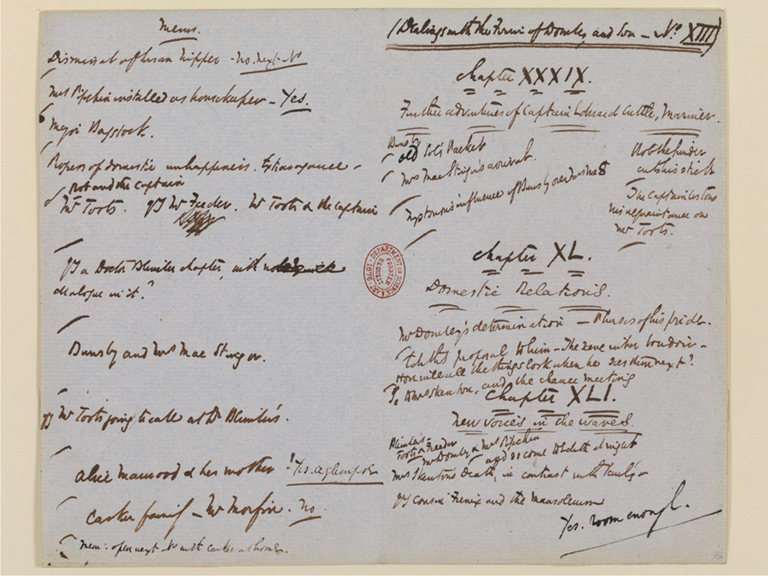
Image No.2012FE1507 (reduced): Forster Collection, National Art Library, Victoria and Albert Museum (2015). © Victoria and Albert Museum, London.
Click here to view a 'zoomifiable' version.
Transcription of Ws.13
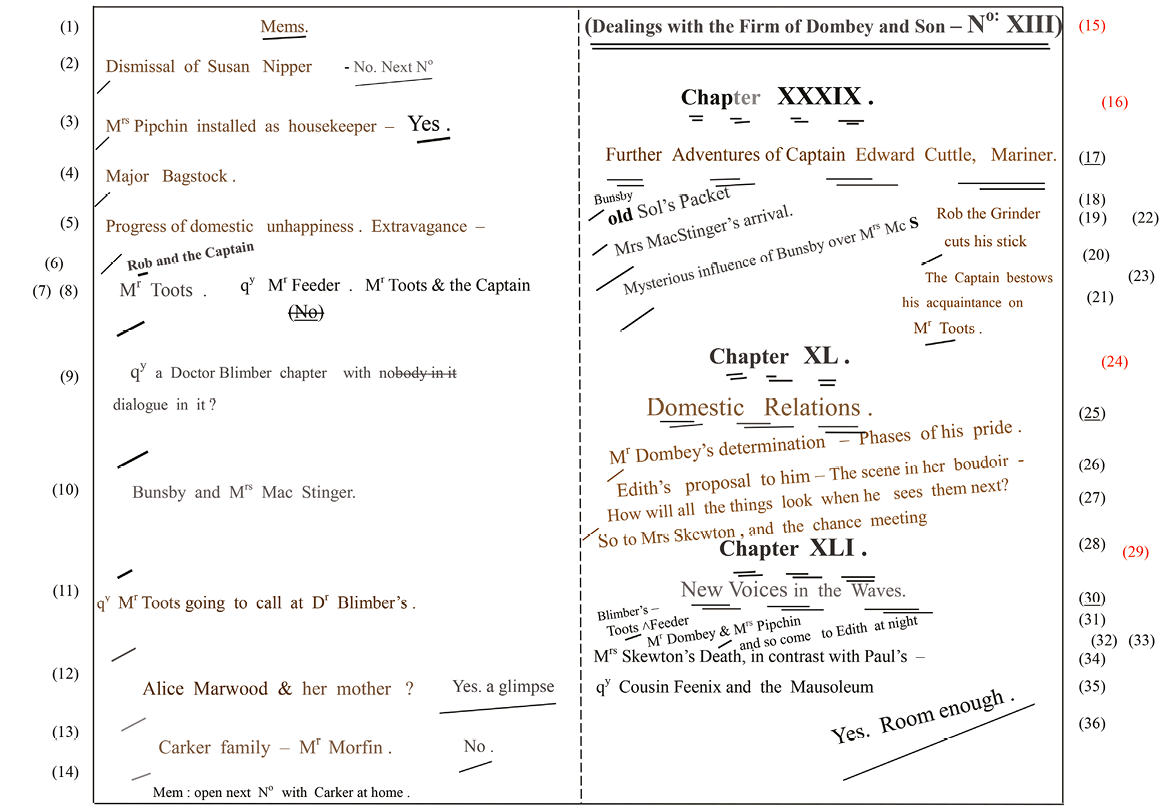
Commentary and order of entry (Ws.13)
Dickens writes the number, despite the street noise, during the final month of his regular annual summer stay in Broadstairs. On 12 September, Dombey becomes “very importunate”. He is hard at work on the 19th. He hesitates to commit to the year’s Christmas story “The Haunted Man”,“Dombey takes so much time, and requires to be so carefully done, that I really have serious doubts whether it is wise to go on with the Christmas book” (Life 466K:9743). On 30 September, No.13 for October 1847 is published.
RH
Preliminary headings: (15), (16), (24) & (29)
Dickens enters the part title and the chapter number headings—all penned with a free flowing quill or heavier hand than elsewhere.
LH
Preliminary: (1)
Initial plan for the number: (2), (3), (4) & (5)→ch.40
Dickens begins with four possibilities for the main storyline, heading them “Mems” (perhaps entering them here before the usual preliminaries). The four entries are identifiable as a group by similarity of hand and quill and by its corrosion. Judging from the resulting text, they can be expanded as follows. Dickens is concerned to isolate Florence ready for No.15. He arranges for Pipchin’s re-employment as a slight to Edith’s position (3), before Susan confronts Dombey (2). He wants to keep Bagstock (4) in the story, now his part as marriage arranger is over (cf. “Anything of Miss Tox” Ws.127 p.91), and plans the next stage of the failing marriage (5).
Additional number plan: (6), (7) and (8)→ch.39; (9)→ch.41; (9) and (10)→ch.39; (11)→ch.41,
With a hand distinct from the initial entries, Dickens decides to develop “Mr Toots” (7), hesitating between a meeting with Feeder or with Cuttle (8)—two storylines that will eventually separate to form the basis of ch.39 and ch.41.
Firstly, he adds Feeder—perhaps playing with the notion of avoiding dialogue at Blimbers (9)—then, negating the Feeder connection, links Toots to Cuttle (8), and finally, in the insertion (6) with a small slash beneath “Rob”, links Rob to Cuttle. The thread will lead on to Bunsby and MacStinger (10).
Secondly, planning to take Toots back to the school (11), he re-instates the Feeder connection by deleting the negation in (8).
Further number plan: (12)→ch.40; (13)
In a distinctively larger hand, Dickens adds two further items before he begins composition. He considers an appearance for Alice and her mother, which he later contrives during ch.40 (12). Finally, he enters (13)—the connection of Morfin to Carker’s brother and sister—not as a query but as a statement, a reminder that he needs to prepare for the thread that will foreshadow the Firm’s failure and ensure Dombey’s livelihood after his ruin.
Plan for ch.39: (18), (19), (20), (21), (22) & (23)
Layout shows Dickens assembling a chapter plan with the number plan, and adding to it. Leaving a gap for the title, he anchors the narrative with two incidents, the opening of the packet (19), and the arrival of MacStinger (20). The Bunsby insertion (18) made in connection with (19) leads to the “mystery” of her submission (21); what her submission conceals is revealed in ch.50. He prefaces the incidents with two additions—both beginning to corrode—Rob’s preparation for leaving (22) and Cuttle’s consent to befriend Toots (23).
MS and RH
Composition and titling of ch.39: (17)
The title, inserted in the manuscript during composition, is copied to the gap left for it in the worksheet.
RH
Plan for ch.40: (26), (27) & (28)
Leaving a gap for a title, Dickens plans for three sections: Dombey’s state of mind that leads to the decision to subdue Edith (26); Edith’s proposal in response, his rejection of it, and his intuited sense of an impending change, as he looks back on the opulent disorder of her bedroom (27); and lastly, the departure of Mrs Skewton (with Edith Florence) for Brighton and the apparently coincidental encounter on the Downs (28). The “So to” of (28) warns of a transition that needs careful management (skilfully done, it is more than “a glimpse” (550–54606–10)).
MS, RH and LH
Composition and titling of ch.40: (25)
Dickens titles at the start and copies the title to Ws. He adds Bagstock (4) to the departure scene with the explanation “he had come to take his leave of the ladies” (see (4) and 547603). As with Miss Tox (Ws.127), he reminds the reader of the Major’s existence, drawing him into the story at this point in preparation for his later role.
Outcome: (3)
He completes the left-hand item (3) with a bold “Yes”, Dombey having announced his intention to employ Mrs Pipchin, in connection with Carker’s various ‘services’ (see 542598 and cf. 578638).
RH
Plan for ch.41: (31), (32), (33), (34) & (35)
Layout reveals a planning procedure comparable to that of ch.39. Leaving a gap for the title, Dickens enters the episode of Mrs Skewton’s death with its query as to the involvement of Feenix (34) and (35). Then he assembles—always preserving the title gap—a list of the names of those characters involved in two scenes prior to the death: the plan for Toots’s visit to his old school (31) and a scene between Dombey and Mrs Pipchin (32), which later redundant is set aside.81 The directive “and so come to” (33) warns him of another difficult transition, from the Toots reunion (or the dropped Pipchin scene) to Edith’s final words to her dying mother (see paragraph beginning “Mr. Toots”, where Dickens uses the “waves” as a bridge passage (559–60617)).
List: [13]
Dickens transfers the headings for chs.39 and 40 and the number heading for ch.41, probably before starting ch.41, and certainly before he titles it.
MS and RH
Composition and titling of ch.41: (30)
A false start and its revision show Dickens working on a title suggestive of the contrasting parallel to Paul’s death (‘Appendix E’ p.189) . He squeezes the final version into the gap left for it in worksheet. Assisted by the Brighton setting and Toots’s visit to Blimbers (11)—joined by Florence and Diogenes—he once more finds pathos in retrospection. He does not attempt to avoid all dialogue at Blimber’s but certainly restrains it (9). With about one manuscript page in hand, having omitted (32), he has space for the burial arrangements.
LH and RH
Outcomes: (2), (12) & (13)
In the same smallhand, the replies are probably made together. Entry (2) postpones Susan’s dismissal to No.14; (12) confirms the “glimpse” in ch.40; (13) notes the intention to link Morfin to Harriet and John; (9) and (11) are answered in the plan and text of ch.41.
Memo: (14)
Dickens gives himself a reminder of the start of the next number.
Outcome: (35)
Entry (36) confirms the bleak ending with an irony and a final Shakespearian flourish.82 With thirty-six separate entries, Ws.13 is the most elaborate of the single worksheets. More than the midway sheets of the first two quarters, e.g. in Ws.3 or Ws.8, the left-hand half is crowded with potential business and the right-hand with detailed plans. Florence though present in chs.40 and 41 is not mentioned in the worksheet (cf. Ws.11).
Worksheet for No.14
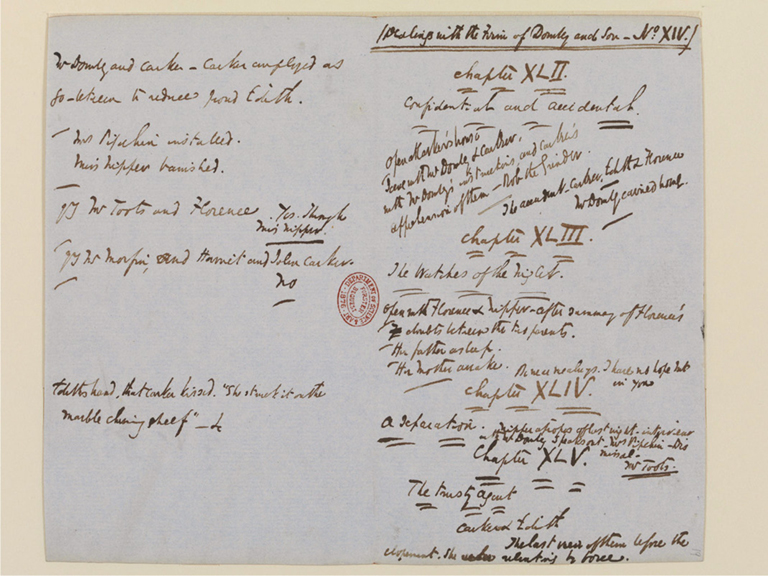
Image No.2012FE1503 (reduced): Forster Collection, National Art Library, Victoria and Albert Museum (2015). © Victoria and Albert Museum, London.
Click here to view a 'zoomifiable' version.
Transcription of Ws.14
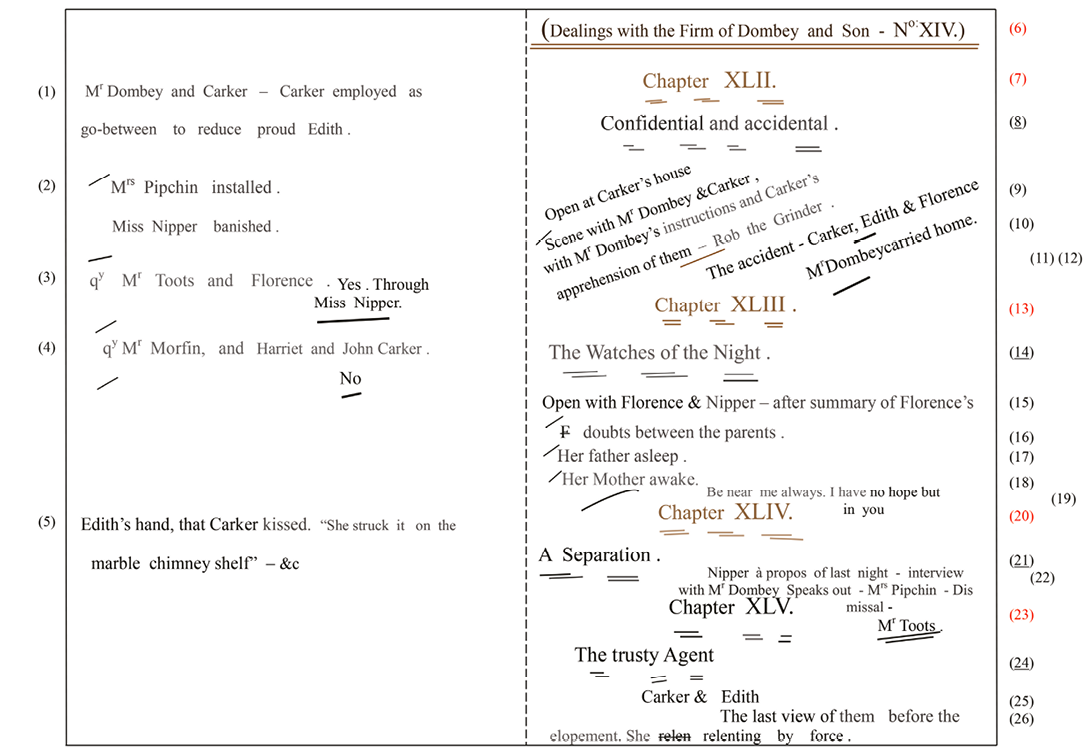
Commentary and order of entry (Ws.14)
The family returns at last to Devonshire Terrace on 1 October. “In harness” (L5:220) to Dombey from the second week until the 24th—a feasible deadline with the printing offices only an hour away—Dickens finds the number, concerned entirely with the main plot, both challenging and absorbing. He is unable to promise even a couple of hours to a close friend, compelled as he is to give it uninterrupted attention. On 15 October he writes “so late am I [...] I cannot spare those two hours” (L5:174). He postpones the Christmas story, a sure sign of his commitment to Dombey (L5:175). On 31 October, No.14 for November 1847 is published.
RH
Preliminary headings: (6), (7), (13) & (20)
Dickens enters the part heading and three chapter number headings with their underlines. The chapter number headings are progressively corroded, confirming that they are entered together.
LH
Plan for the number: (1)→ch.42; (2)→ch.43; (3) & (4)
In entry (1) Dickens lines up Dombey and Carker; one works round to his go-between proposal while the other schemes. In entry (2) he meets his timetable for Pipchin and Nipper (cf. Ws.132 & 3 p.95). He plans to have Pipchin established as housekeeper in time for the drama of Susan’s confrontation with Dombey. The involvement of Toots will end his hope of Florence but also prepare for his role as messenger in recalling Susan (3). Finally in (4), the note for Morfin to meet Harriet is repeated, reflecting Dickens’s determination to include the meeting, well in advance of the denouement. He writes that he is “forced to creep carefully over the ground I am laying for the No. after this one” (L5:174). As in the penultimate number of the second quarter, he is concerned with main plot and its climax in the next number.
RH
Plan for ch.42: (9), (10), (11) & (12)
Dickens slopes the line to avoid the title gap above and the heading below. The directive “Open” (9) shows his planning intent. Group (10) summarises Dombey’s purpose and Carker’s reaction. The last item “Rob the Grinder” is probably a reminder to detail Rob’s promotion to livery, which becomes a topic of conversation to Carker’s advantage. Dombey’s injury and treatment (11) and (12) gives Carker access to Florence and Edith, and many opportunities later to get to Edith alone.
MS & RH
Composition and titling of ch.42: (8)
Dickens inserts the title into the manuscript during composition and copies it to the worksheet. He re-orders the final item of (10), bringing Rob into the opening recapitulation. In conversations with Edith, Carker plays on what is unspoken. When he brushes her hand with his lips, her reaction shows that she knows its meaning. Despite revulsion, she dwells on it for the opportunity it may give (578–79638–39).
LH
Memo: (5)
Dickens copies in the text of Edith’s decisive moment of self-harm. He signals its special significance by isolating it in the bottom half of the left-hand page (cf. Cuttle’s watch (Ws.69 p.63) and the servant chorus (Ws.107 p.83)). He does have other uses for the space, e.g. a last minute chapter plan (Ws.76 p.71), a checklist of potential business (Ws.810 p.75), a memo on how to open the next number (Ws.1314 p.95), and two retrospective self-justifications (Ws.128 p.91 and 156 p.103). In the fourth quarter, except for curtain call of Ws.19&20, the lower left-hand is not needed.
RH
Plan for ch.43: (15), (16), (17), (18) & (19)
After “Open […] Nipper” Dickens writes “F”, perhaps intending “Florence’s doubts between the parents” as the next entry. Then deleting “F” he adds “– after […] parents.”, thus re-ordering his initial plan, (16) now preceding (15). The change shows his concern to keep plans in the order of the narrative as he imagines it (cf. Ws.1212 & 14 p.91). His focus on Florence continues in (17) and (18), noting her visit to Dombey’s room, then to Edith’s. He plans to close on Edith’s plea (19), alluded to in the cancelled ending of ch.45 (see ‘Proofs’ below).
List: [13/14]
Dickens transfers the title for ch.41, the headings for ch.42, and the number heading of ch.43 probably before he starts writing ch.43, and certainly before he titles it.
Composition and titling of ch.43 (leading to the creation of ch.44): (14)
Dickens revises the title of ch.43 during composition, copying the final version to Ws.14. He follows the salient points of the plan, but goes beyond it when he develops Susan’s reactions to Florence’s mistreatment. At the planned endpoint (19), Dickens writes on into the second day. However, before he is far into Susan’s story, by cutting and pasting what he has just written, he creates a new chapter, inserting number and title of ch.44 at the top of MS p.17. It ends with Susan dashing Toots’s hopes of Florence, from the night-coach, on the way to her brother’s farm. The final scene echoes other farewells, furthers Toots’s attachment to Susan, and prepares for her return.
MS
Composition and titling of ch.45
The title is entered at the start. Dickens winds back the narrative to Edith’s preparations for her visit (595654), then on to later that evening. By angrily making Carker’s duplicity explicit, she becomes allied with him against Dombey, calling attention to her helplessness by absent-mindedly pulling feathers from her fan. Overwhelmed by the threat to Florence, she consents to a second kiss—on the hand she had so deliberately punished—and to further visits.
RH
Chapter number, title and summary for ch.45: (23), (24), (25) & (26)
Similarity of hand and quill suggest that number, title and description are entered together. The summary is unusually short, even for a final chapter, consisting of subject and explanation of why Edith gives way, relen relenting by force”, together with the comment “The last view….”. Dickens creates a deliberate narrative gap, partly to delay revealing Edith’s motives until the “tremendous” final scene, partly to leave other meetings to the reader’s imagination.
Title and summary of ch.44: (21) & (22)
Dickens copies in the title (21) under the number heading for ch.44 and adds its short but inclusive summary (22). For reasons why ch.45’s entries come before those of ch.44, see endnote 83. He enlarges slightly his lettering of “Toots” and ends with a celebratory double underline.84
List: [14]
Dickens transfers the title of ch.43 and the headings for chs.44 and 45. His entries completing the record for Nos.14 and 15 are more frequent than any others, reflecting his involvement in the crises (see p.178).
Overrunning by a third of a page, the last three paragraphs are cut by Forster. For the cut, see endnote 85, or Horsman 1974, p.605 n.1, or the end of ch.45 in ebook 821.86 By alluding to her earlier pleas, the final “I have no hope left” emphasises Edith’s isolation and her earlier “black fore-shadowings” (579638 and 587647). To Carker’s perception of the “graces of her face and form” in ch.42 (577636), Dickens adds in ch.45 her vulnerability, “pluck[ing] off the feathers [of her fan]” and later “lay[ing the soft trembling] plumage of the beautiful bird against her bosom” (600662). While Edith lies sleepless on her bed, Carker lies in his, “musing […] with a dainty pleasure” on her enticing strength and weakness—the reader’s last view of them before they elope.87
Worksheet for No.15
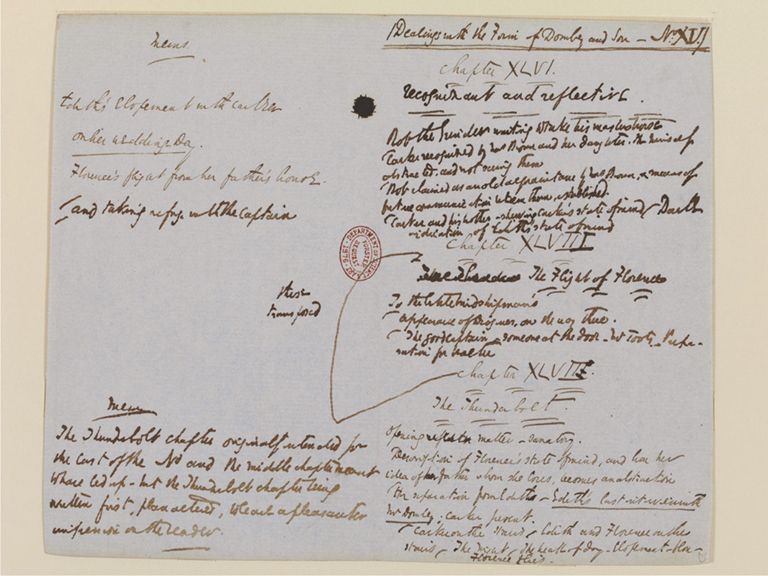
Image No.2012FE1487 (reduced): Forster Collection, National Art Library, Victoria and Albert Museum (2015). © Victoria and Albert Museum, London.
Click here to view a 'zoomifiable' version.
Transcription of Ws.15
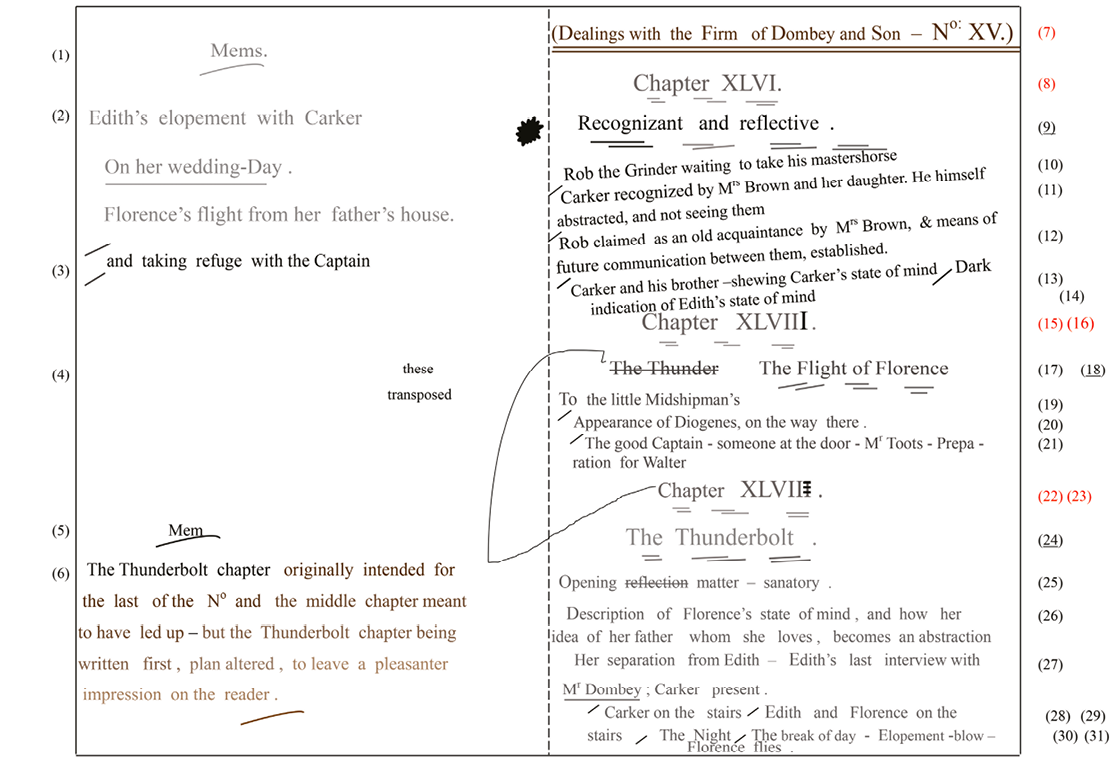
Commentary and order of entry (Ws.15)
Busy with his commitment to the opening and running of Urania Cottage, Dickens probably again begins late, working first on ch.48 (later 47).88 He writes on 18 November of “some terrible circumstances taking place in Mr Dombey’s family” (L5:197). On the 19th, he intends “to make the first two chapters as light as I can” (Life 483K:9481). On the 23rd, he is still “in the whirlwind of finishing a No with a Crisis in it” (L5:200). On 30 November, No.15 for December 1847 is published.
RH
Preliminary headings: (7), (8), (15) & (22)
Part heading (7), corroding and in a different hand, may have been entered with that of Ws.14. In contrast, the chapter numbers for chs.41–43 are entered with a distinctive thin line—as usual moving right, as he goes down the page.
LH
Preliminary: (1)
Initial plan for the number: (2)→ch.48 (later 47)
In the same fine hand as (1), (8), (15) (22), Dickens sums up the crisis of the main storyline.
RH
Plan for ch.48 (later 47): (24), (25), (26), (27), (28), (29), (30) & (31)
Dickens continues to use the same thin line for all entries (see above). Title and plan, uniform in hand and layout, are entered together. He hesitates over how to describe the planned digression and substitutes “matter” for “reflections” (25), implying that the digression is to be more fact than opinion. In (26), he traces the alteration in Florence’s feelings for her father and in (27), notes Edith’s distancing herself from Florence—the two ideas central to the narrative prior to the dinner and Edith’s final interview with Dombey in Carker’s presence. Lastly, he delineates four moments in the accelerating action: Carker’s secretive departure on the first night (28), Florence’s meeting with Edith on the stairs (29), the second anxious night (30) then, at daybreak, Dombey’s discovery of the elopement, his violence, and Florence’s rush into the streets (31). There are no positive indications of planning, apart from the corrected deletion. However, noting sequences appears to be an aid to narrating successive transitions, like the movements of Cuttle in ch.60. The parallel with the planning of ch.31 in the degree and amount of detail suggests that it too is a plan. Initially intended as an important closing climax, it is also carefully through-planned.
MS and Ws.6a
Composition and titling of ch.48 (later 47)
Florence’s age
Either before composition or soon after the digression on man and nature, Dickens breaks off to calculate Florence’s age when Edith elopes (see Ws.6a p.67). The title is entered as he begins ch.48 (later 47), early in the narrative incorporating details of the timeline (see in Ws.6a, p.69). A long chapter, completed late, it goes at once to the printers, but, because it is not the opening chapter, he does not number its pages. The compositor pencils in the temporary MS page numbers (one to fourteen).
List: [15a]
Dickens enters number headings only for chs.46 and 47, and gives the number heading and title of ch.48 (later 47), thus establishing that “The Thunderbolt” is written first (before both chs.46 and 47) and initially intended to be the last—all entered with the same fine line as the worksheet entries so far p.178.89
LH
Additional plan: (3)→ch.47 (later 48)
Dickens changes to a quill with a broader heavier line. The contrast of the two quills supports the view that he writes the “Thunderbolt” chapter before ch.46 (see ‘Comment’ below).
MS and RH: (9)
Composition and titling of ch.46
Dickens inserts the title during composition, and transfers it later to the worksheet.
RH
Summary of ch.46: (10), (11), (12), (13) & (14)
Dickens outlines the main events that prepare for the denouement (10), (11) and (12). The theatrical “recognition” is by Alice, who is seeing Carker for the first time since her transportation, whereas her mother has watched him on many other occasions. The final two entries record the angry exchange with John, which clarifies Carker’s true feelings (13) and reveal more of Edith’s motives with hints of her intentions (14), the latter added partly at Forster’s suggestion, to offset cuts made to No.14 (see ‘Proofs’ in Ws.14, p.101). Edith is to give herself to Carker, then commit suicide (Life 484K:9485 and 410449, 617682).90
MS
Composition and titling of ch.48
On reflection, Dickens decides to rearrange the order of the chapters. He numbers and titles ch.48 correctly. When manuscript of ch.47 (still numbered 48) is returned to him, the pages are lightly numbered in pencil ‘1’ to ‘14’ to preserve their sequence. Dickens can use the numbering (with that of ch.46, which finishes on p.8) to begin ch.48 on what would be the next page p.23. As usual, he paces his text as it approaches the end of the instalment.91
Summary of ch.48 (initially numbered ch.47): (4), (16), (17), (18), (19), (20), (21), (23)
Dickens’s first thought, as shown in (17), is leave the chapter number as 47 and title the chapter “The Thunder[bolt]”, retitle the chapter below, and mark only the descriptions for transposition. Midway through the title, he takes a shorter route. He deletes “The Thunder[bolt]”, enters “The Flight of Florence” and its description, and marks the whole for transposition (4), adding Roman ‘I’ to ch.47 (16) and deleting ‘I’ from ch.48 (23).
The summary notes three contrasting events. “To the little Midshipman’s” repeats Florence’s first frightening experience of the city (19), with Diogenes (instead of Walter) taking the role of protector and lessening her fear of its dangers (20). Entry (21) notes the confusion of events that both mocks Cuttle’s playful attempt at mystery and prepares for the recognition of Walter—a ‘weak’ final curtain replacing the ‘strong’ one that was initially intended in ch.48 (later 47).
List: [15b]
Dickens corrects the title of ch.48, and enters the titles of chs.46 and 47, completing the unusually broken-up record for Ws.14 and 15 (see comment in ‘Appendix C’ p.178).
Comment: (5) & (6)
The repetition of “Mem” (5)—see (1) above—shows some concern to set the record straight. Dickens explains that he wrote “The Thunderbolt” first of three, intending to make it the last chapter (and end with a strong final curtain) and that a middle chapter (not in fact written) would lead up to it. Instead “The Thunderbolt” chapter becomes the middle chapter, and he writes a “lighter” final chapter “to leave a pleasanter impression on the reader”.92 Like other final entries, entry (6) has a diminishing ink supply and progressive corrosion, and finishes with a flourish.
Worksheet for No.16
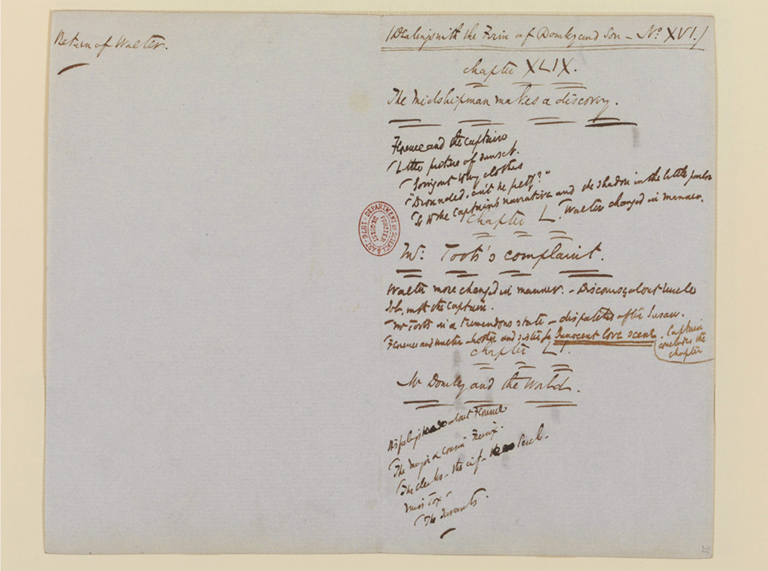
Image No.2012FE1490 (reduced): Forster Collection, National Art Library, Victoria and Albert Museum (2015). © Victoria and Albert Museum, London.
Click here to view a 'zoomifiable' version.
Transcription of Ws.16
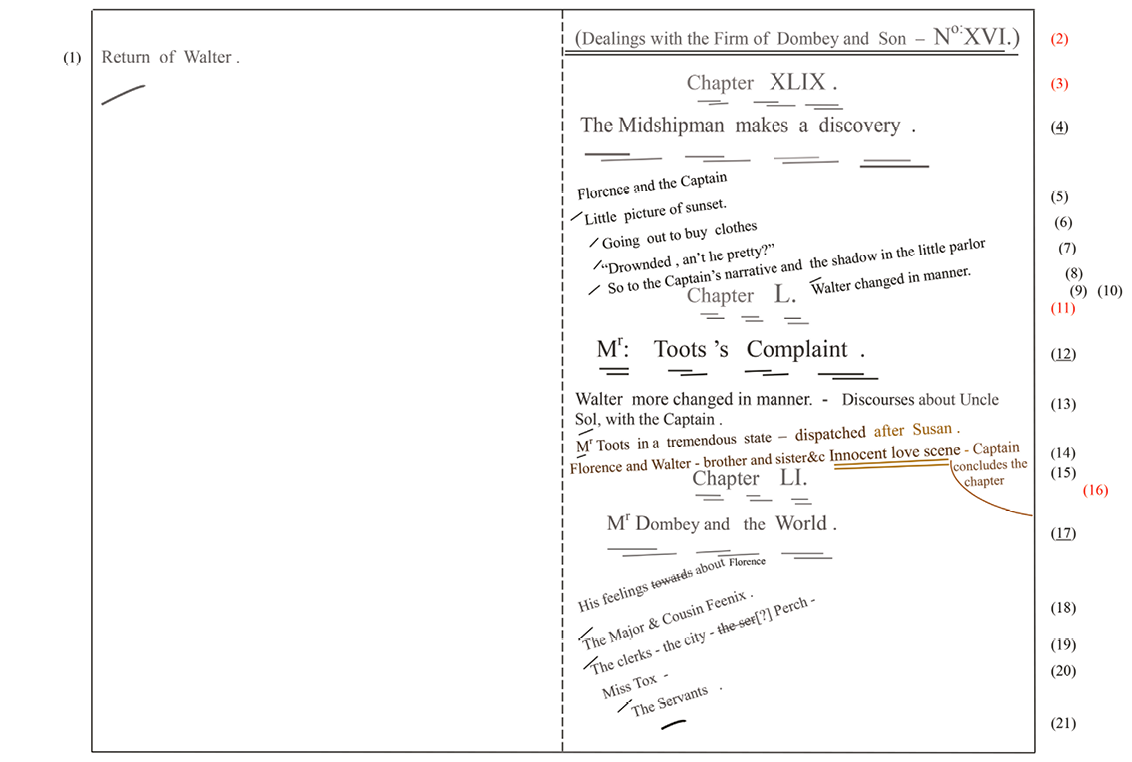
Commentary and order of entry (Ws.16)
On 10 December, Dickens is “pursuing Dombey under difficulties […] in a state of imbecility [suffering from winter flu]” (L5:207). By the 21st he is a few pages from the end of ch.50 (MS p.22), writing the “innocent love scene [that] ought to be one of the prettiest things in the book” (Life 483K:9484). He has only a day or so left for the final chapter: “Tomorrow [the 23rd] I shall be forced to imprison myself the whole day long, finishing Dombey” (L5:212). On 31 December, No.16 for January 1848 is published.
RH
Preliminary headings: (2), (3), (11) & (16)
LH
Plan for the number: (1)→ch.49
Dickens evidently feels that number planning is not needed to unravel the few entanglements of the romance plot. From now on, the remaining number plans are brief and not added to, except in the final double number.
RH
Plan for ch.49: (5), (6), (7), (8), (9) & (10)
Contrast of hand and layout between plan and title suggests that Dickens leaves a gap for the title to be added later. The plan lists six salient points in narrative order. The first, more general, introduces the over-arching relationship between the nurturing Captain and the abused and rejected Florence (5). The next two, (6) and (7), are leading episodes that aid her recovery, preliminary to the creation of a home. In entry (8), the protective Cuttle, in his childlike way, seeks to soften the shock of Walter’s return. “So to” (9) indicates a narrative turning point that may need preparation as a story within a story. With some authorial self-mockery, Dickens relates how Cuttle tells the story and into it, Walter appears. Entry (10) notes the start of a change in Walter’s feelings for Florence.
MS and RH
Composition and titling of ch.49: (4)
A false start in the manuscript shows that Dickens unsure of a title leaves a narrow blank line and inserts the title later, just as he does if unsure of a title, when planning a chapter (‘Appendix E’ p.190). Delay gives him an opportunity to reflect on what might be appropriate for the chapter, as he writes it. He eventually devises a teasing title in keeping with the chapter’s light tone, probably added to MS and worksheet after he has finished it, but certainly before he updates the List.
RH
Plan for ch.50: (13), (14) & (15)
Dickens leaves a gap for the title. The differences of alignment suggest that the plan is compiled in three stages. Entries (13)–(15) lose density towards the end of each line, while tilted entries (14) and (15) are each progressively corroded—suggesting re-dipping and separate entry. In entry (13), he notes the change in Walter that effectively hinders the resolution of the romance. His “discourse”, a longwinded contribution to the Sol plot, is partly an avoidance of what preoccupies him (other distractions will be added in composition). Entry (14) leads to the reunion of Susan and Florence, prepared for by the involvement of Toots in their separation. In (15) three items map the close: the sibling pretence—the first of a number of misunderstandings to be cleared away—the doubly underlined item “an innocent love scene”, and lastly and most corroded, the celebration of Cuttle the nurturing protector, whose presence and authority (now usually referred to as the Captain) make the relationship proper.
MS and RH: (12)
Composition and titling of ch.50
Dickens enters a title and later revises it, copying the final version to the worksheet. Like that of ch.49, the final title is more oblique and less descriptive (‘Appendix D’ p.187). The plan is much extended by various two-handed dialogues, and by the presentation of Florence, who—isolated, unhappy and unwell—takes the lead in sorting out the lovers’ misunderstandings during “the little love of Florence and Walter”, of which Dickens was rather proud (L5:223). He needs to resolve the romance plot quickly, in order to leave sufficient real and narrated time for her child to be born after the marriage, and for the Firm to fail before her reconciliation with the ruined Dombey.
List: [16]
Dickens copies in the number heading and title for ch.49. Making the entries for ch.50, he misremembers the title, then corrects it. Finally, he enters the number heading for ch.51.
Plan and titling of ch.51: (17), (18), (19), (20) & (21)
Entry (18) is shaped to avoid the broken underlines of the title that is entered at the start. The first correction “towards about” shows Dickens emphasising Dombey’s attempt to distance himself from his daughter to avoid thinking about her (cf. 682754). The second correction “the ser(vants?) Perch” shows him planning to re-position the servant chorus to the end of the chapter. In composition, reactions to the elopement are added to and re-ordered further (see below).
MS
Composition of ch.51
Dickens transfers the title from the worksheet (see above). By way of an introduction to what he has planned, he begins with a family visit from Mrs Chick. Dombey reveals his attitude to Florence in his rebuff to her enquiry after her niece (18). Despite hiding “the world within from the world without”, Dombey accepts the representations of Bagstock and Feenix; they speak for polite society (19). Dickens adjusts the plan further by re-ordering the responses in (20). He begins with the comment of the “true”, the loyal Miss Tox, in conversation with her former teacher Pipchin, goes on to the response of the clerks and of Perch, and ends as planned with the servant “chorus” (687–89760-63).
Writing on to MS p.28 for just half a dozen lines, Dickens appears to have calculated his allowance precisely. The only deletion, near the end of ch.51, is a telling piece of ‘low’ mimicry, which he may have deleted not wishing to gratuitously offend his more genteel readers.93
His terse comment to Forster on the first of the two plates that came with the proofs, “Shadow plate, poor” (Life 483K:9484), shows his resignation to being occasionally let down by what he considered clumsy or inaccurate illustration. Compare this with his reaction to Browne’s illustrations for No.2 that “made his legs curl up” and to the first plate for No.3 that was “frightfully and wildly wide of the mark” (Life 478K:9375 & 83).
Worksheet for No.17
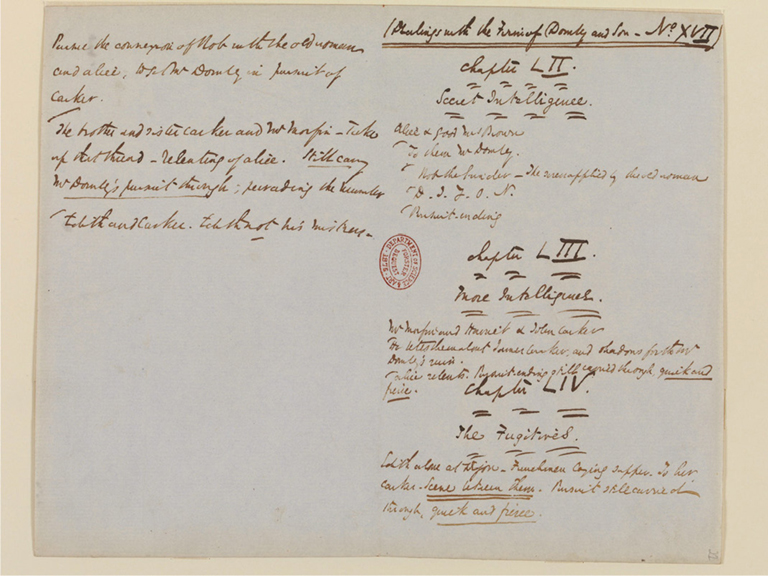
Image No.2012FE1505 (reduced): Forster Collection, National Art Library, Victoria and Albert Museum (2015). © Victoria and Albert Museum, London.
Click here to view a 'zoomifiable' version.
Transcription of Ws.17
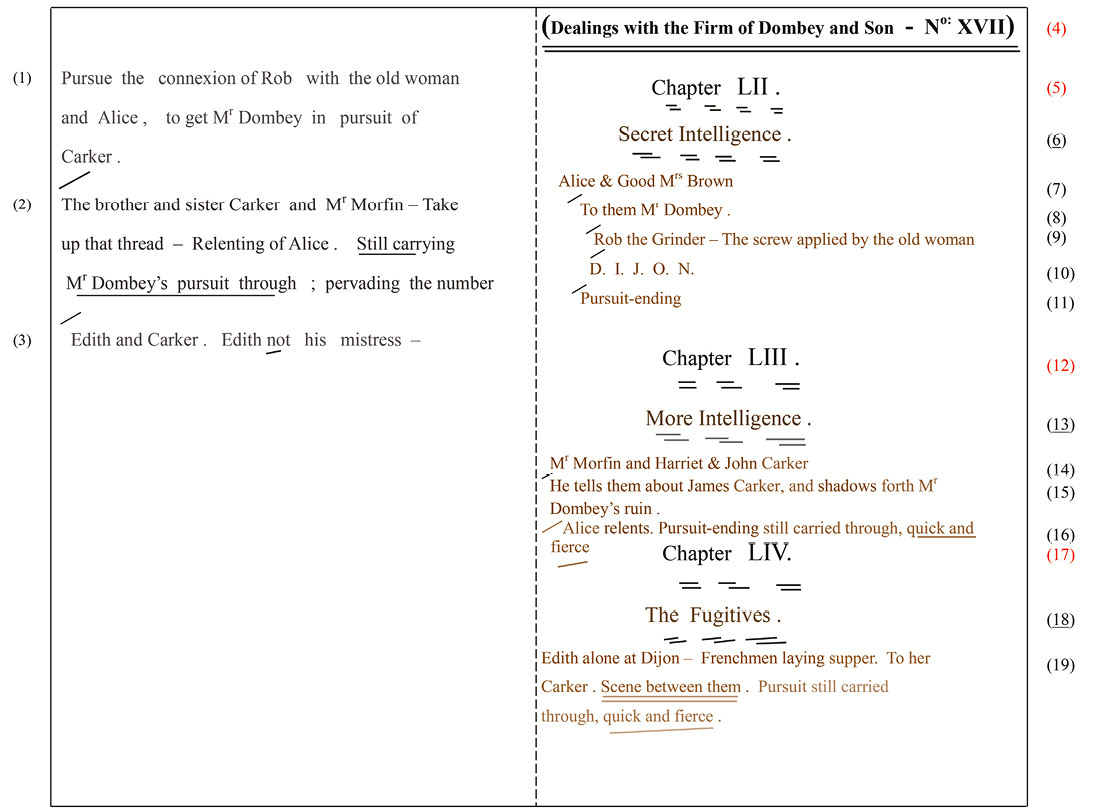
Commentary and order of entry (Ws.17)
Dickens’s monthly pattern of commitment to the “relentless savage” continues. He tries to begin No.17 on 10 January, “Sniffing, and wheezing, and hating myself”..[with a cold]..“a second Edition of my former one, and the most ridiculously intense” (L5:229 and cf. Ws.16 p.108). He finishes on the 24th, the day he usually keeps clear of engagements, expecting to “revise them [the proofs] at the printers […] before five or six or seven o’Clock this evening” (L5:237–39). On 31 January, No.17 for February 1848 is published.
RH
Preliminary headings: (4), (5), (12) & (17)
Dickens enters the part heading and the chapter number headings with a consistently heavy stroke. Similarity of hand suggests that he may enter the remaining part headings at the same time, as well as Ws.182 & 5 and Ws.19&202 (see pp.115 and 119).
LH
Plan for the number: (1)→ch.52; (2)→ch.53; (3)→ch.54
Dickens’s style of notation changes. He writes evenly across the whole page, without hesitation. Entries correspond closely to each chapter. Entry (1) advances the intrigue prepared for in ch.46 of No.15, where the pursuit is primed by Dombey’s “intelligence of a singular kind”, an incident described later by Mrs Brown (686759 and 691–2764). In (2) the “thread” has at least three strands: Harriet and John, Harriet and Morfin, and Harriet and Alice. Dickens develops all three storylines, moving on from Harriet’s first meeting with Morfin in ch.33 (Ws.118 p.87). In (3) he finally decides, on reading Jeffrey’s reaction to No.15 that Edith, while shaming Dombey by appearing to become Carker’s mistress, should refuse to be so, which in Forster’s opinion makes for a “more bitter humiliation for her destroyer” (Life 483K:9482).94
MS
Composition and titling of ch.52
Dickens enters the title as he begins composition, the “singular intelligence” of ch.51 (686759) becoming “secret intelligence”. He employs the common method of pursuit narratives, in which a clue from the past gives impetus to future action. The pace of narration is slowed by dialogue. Rob’s basic ability to read and write, so useful in the service of Carker, is now used against him. Rob pieces together the fragments of Carker’s note that names the town where Edith is to meet him, which he now spells out in Dombey’s hearing.
RH
Summary and title for ch.52: (6), (7), (8), (9), (10) & (11)
Writing with a fine hand and an ink liable to corrosion, Dickens explains how Dombey gets what is needed to begin the chase; he enters the title and names of those involved in the scene, giving its purpose, the order of events, method of interrogation and its outcome.
MS
Composition and titling of ch.53
Dickens inserts a title during composition, and later revises it. Winding back the narrative to early morning of the previous chapter, he lingers over Perch’s delivery of Dombey’s letter of dismissal and John and Harriet’s reaction to it, in preparation for the next visitor.
John Carker introduces Morfin to Harriet, unawares uncovering the name of their benefactor, in the manner of a theatrical discovery. Morfin manoeuvres so that he can confide some of his own history to Harriet alone, forewarning her of James’ deceptions and the threat they pose to the Firm.
Some evenings later, Harriet’s reverie of Carker’s ghost foreshadows his death. Another face at the window announces the final visitor Alice, who by telling her story explains her actions and the reason for her visit. Dickens is preparing for the final twist in the Alice thread to be given dramatically, as part of the ongoing relation of Harriet and Alice (see Ws.19&20, ch.58, p.121).95
RH
Summary and title for ch.53: (13), 14), (15) & (16)
Dickens enters the title. From a chapter full of incident and information, he selects the names of the principal actors (14) and a few salient points, laying bare “the management of the manager” (his running heading, in the 1867 edition, for the page that reveals James’s wrongdoings). Harriet becomes involved in the life of the repentant Alice. Her change of heart, though it comes too late to affect the outcome, adds to the urgency of the chase (16).
MS and RH
Composition and titling of ch.54
Dickens enters the title, briefly sets the scene, and then slows the action with the waiters’ business. The confrontation is visualised as theatre, a “tremendous scene” (Life 484K:9486), employing the codes of melodrama that he knows so well—the arrested tableaux, large gestures, emotive speech, explanations of past mysteries and sudden action. A libidinous Carker, clinging to the fantasy of delicious “Sicilian” days, hesitates while the imperious Edith taunts him with her “good account”. She explains her actions, and clarifies her motives to him, and to the reader. A violent outcome is circumvented by the concurrence of the ringing bell, Dombey’s voice amid the hubbub, and Edith’s exit—pointedly prepared for earlier in the chapter—followed by Carker’s hurried escape.
RH
Summary and title of ch.54: (18) & (19)
In this passage, the corrosion is more marked. After the first item, the ink begins to thin, causing the progressive corrosion of the title and summary that follows. The order of entry is confirmed by similarity of hand and alignment. Although the chapter is almost as long as the previous one, the summary is laid out as a paragraph with stops, instead of a list with slashes—Dickens’s alternative method for a final, usually shorter, description. Like a stage manager’s order of business, the summary enumerates the reveal, the waiters’ preparation, the next entry, the scene, and the continuing pursuit. Omitting any details of the climax, Dickens simply double underlines, for its importance, the “Scene between them” (19).
List: [16/17/18]
Changing his previous practice somewhat, he leaves updating the List until he can give ch.51 its title and complete all the headings for the No.17, and the number heading of the first chapter of the next number, the last single number. He is gradually catching up with the manuscript, so that he can complete the record up to the double number.
Proofs
The proofs of the number are lost. However, differences between the manuscript and the published part show the probable extent of the corrections. In ch.54, Dickens takes special care over Edith’s speeches, making many minor improvements.
The only longer deletion reveals how clearly she understands Carker’s ploys to get power over her. The deletion—worth retaining, though Dickens may have thought it too blunt an explanation—comes in the paragraph beginning “I can” and after “Hear it”:
‘You—being the villain I have spoken of—approached me, first with your entreaties for permission to remain one minute; then, with your condolences and protestations; then with your regrets that I was destined to be a curse upon the head of my adopted daughter’ (Horsman 1974 notes, p.727 n.1; not in ebook 821).
Worksheet for No.18
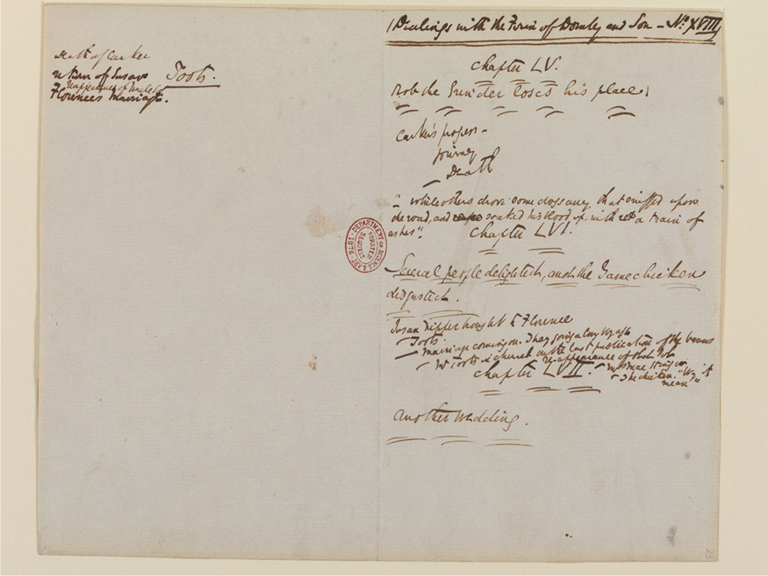
Image No.2012FE1492 (reduced): Forster Collection, National Art Library, Victoria and Albert Museum (2015). © Victoria and Albert Museum, London.
Click here to view a 'zoomifiable' version.
Transcription of Ws.18
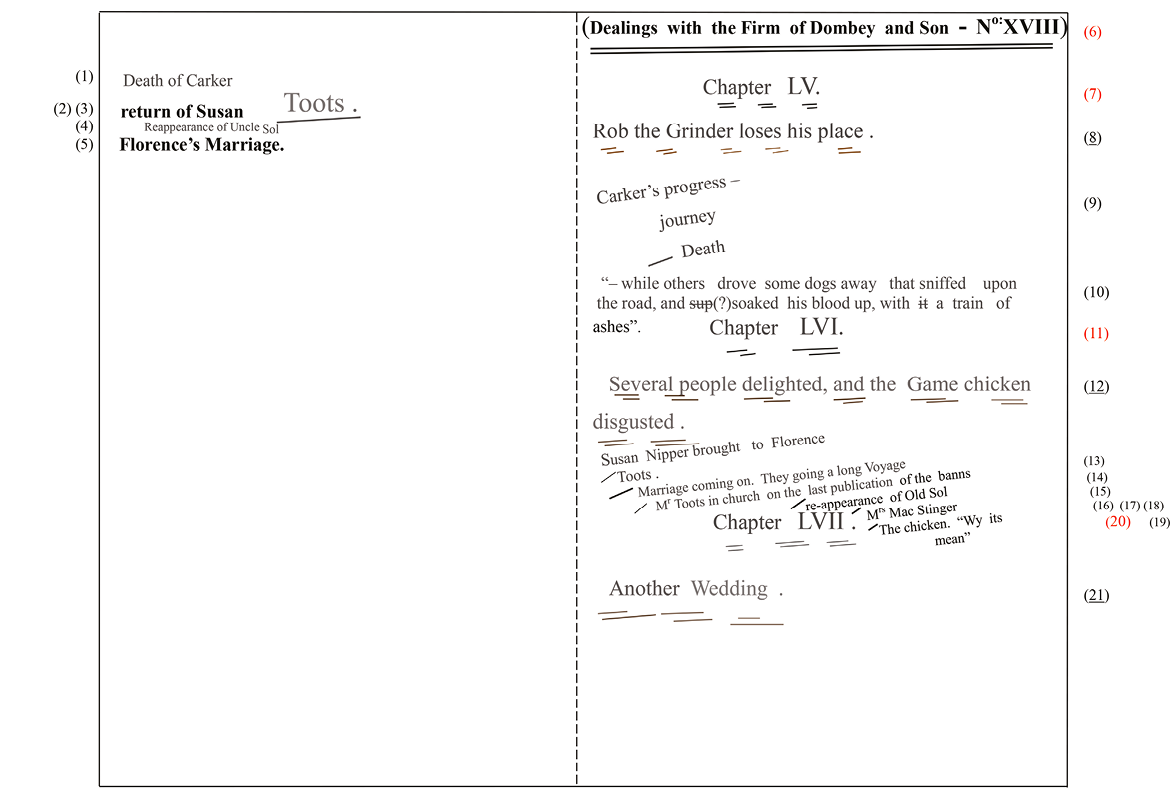
Commentary and order of entry (Ws.18)
On 17 February, Dickens is “deep in No.18”. On the 24th he excuses himself to a close friend that he “shall be very busy finishing Dombey, in a few days.” So once again, what Dickens called “that most fraudulent month” February—despite the advantage of a leap year—helps create a difficulty (see L1:510 and cf. Ws.6 p.64). Though he does not underwrite the number, as he did in 1847, he does overrun his usual deadline, which probably means his attendance in the office to correct proofs as they become available. By happy accident, the last two chapters (MS pp.9–28) would have been comparatively easy to set up—having more dialogue and cleaner copy, with fewer long corrections—compared to the opening ch.55—descriptive of Carker’s sensations as he flees overwhelmed by irrational fear and panic—which was probably set up and proofed separately earlier in the month. On 29 February, No.18 for March 1848 is published.
Initial number plan: (2)→ch.56; (5)→ch.57
Preliminary headings: (6), (7), (11) & (20)
The part heading (6) and the two events central to the number (2) and (5) were probably already entered (see “preliminary headings” p.112). Dickens now adds the chapter number headings (7), (11) and (20).
LH
Additional number plan: (1)→ch.55; (3) & (4)→ch.56
Contrasts of hand and layout shows how Dickens brings together materials for the number, assembling them in the following order: (2) and (5)—entered earlier—then (1), (3) and (4). He places “return of Susan” at the heart of the number, and, at the same time, positions “Florence’s Marriage” at the end. The death of Carker is then entered in a smaller, lighter hand, but still carefully aligned with the other two.
Dickens had very probably already decided to relieve the suspense ending of the No.17 with an immediate return to Carker’s desperate journey and death. Always alert to readers’ responses, he was gratified to overhear of discussions of what might follow ch.54 and “hugged myself in private” (L5:249).
He adds “Toots” to the right of the summary list, and finally inserts the “Reappearance of Uncle Sol”, moving the “Sol” downwards to avoid overwriting the start of Toots’ entry. In adding character and incident to the page, Dickens is also visually laying out the order of the chapters and the narrative. The underlining of the enlarged lettering of “Toots” denotes as usual emphasis and recurrence. Toots has still to work through his feelings for Florence, before he can discover his attachment to Susan (hinted at in chs.22 and 44).
RH
Titling and end plan for ch.55: (8) & (10)
Deletion with correction suggest that Dickens begins, as earlier, by devising the wording of a closing text and positioning it as close as possible to the heading beneath. Always preserving the title gap, he may then add (9) a “mem” of Carker’s “progress”, how he travels and how his feelings change. Finally, happy in the choice of a deliberately misleading title, Dickens enters it, tight against the underlines above, with its underlines midway between the title and “Carker’s progress”.
MS
Composition and title of ch.55
Dickens transfers the title from the worksheet during composition. The journey is in two stages, by horse and carriage at night in France, and by train in England the next day. Carker struggles to come to terms with exposure and disappointment, “progressing” from guilt, fear, and panic to finally an irrational fascination at the violent power of the passing trains. At the finish, after a brief but graphic account of the dismemberment of Carker’s body by the train—a shocking moment in a gruesome death—Dickens vivifies the closing text by embedding it in Dombey’s viewpoint.
RH
Plan for ch.56: (13), (14), (15), (16), (17), (18) & (19)
Dickens enters seven groups, writing on a slant to avoid the title gap above and number heading beneath. He identifies, in narrative order, an action and/or character in each group. Planning intent is shown by the number of entries, the cramped entry towards the end, and the closing text—comparable to the crowded outline plans of the double number.
MS
Composition and titling of ch.56:
Layout and underlining in the manuscript suggests that the title of ch.56 is entered during or after composition. Dickens writes fluently, with less revision than usual. Toots is threaded through most of the chapter. He comes to terms with disappointment in love, accepts that Florence is “married to the man she loves and who loves her” and begins to voice his appreciation of Susan. All of the “little society” are crowded into the shop, including Polly—recalled to become housekeeper—a detail not prepared for in the worksheets, but appropriate nevertheless. Uncle Sol reappears the day before the wedding. Cuttle’s prophetic dream is happily only partly fulfilled, the letters to Cuttle, sent to Brig Place, having been refused by Mrs MacStinger. Toots now more self-assured dismisses the “morally incompatible” Chicken.
RH
Titles of chs.56 and 57: (12) & (21)
Dickens transfers the title of ch.56 from MS and at the same time titles ch.57. Both are written with the same fine evenly corroding line.
MS
Composition and title of ch.57
Dickens enters the title at the start. The couple share memories, as they walk early one sunny summer morning, from the Dombey church through dark narrow streets to the dingy City church that Toots attends. The churches, the walk through the city, the marriage, the farewells, and the feelings of those left behind, all resonate with memories of earlier occasions.
Dickens writes that he saw “in Florence’s marriage, and in her subsequent return to her father, a brilliant opportunity” (see Life 483K:9485). “Another Wedding” gives him a chance once more to revive the past. By Walter and Florence’s visit to Paul’s memorial and by their long walk from there to Toots’s dingy City church, they revisit their feelings for Paul, and their earlier journey as children. Similarly in “Retribution”, Florence’s return to her father is preceded by Dombey’s obsessive confused recalling of moments in his mistreatment of her.
Dickens needs no plan or record for ch.57. The pathos of the chapter, heightened by the historic present, is sustained by contrasts reminiscent of early occasions, for the reader and for those involved. The couple pass by Mr Sownds and Mrs Miffs, walk through the city and take their leave in a procession of friendly farewells.
Proofs
To the proof of ch.57, Dickens adds a second mention of the sound of man with a wooden leg (Horsman 1974 p.769 n.3), a reminder of another reality that could find “nothing entertaining there” (769852). At the second proofing of ch.56, Dickens extends Cuttle’s reaction to the letters that went astray, adding about twenty lines, from “What do you mean” to “and sat down.” The change has the effect of softening Cuttle’s responsibility for the mistake (Horsman 1974, p.762 n.2).
List: [18]
Dickens titles ch.56 beginning “Some people pleased” presumably from memory, but soon corrects the error (underlines confirm that the change is a running correction). He completes titling to the end of the number but does not go on to give the number heading of ch.58. The usual reminder of the next chapter number is unnecessary, as he goes to Brighton to begin work on the double number soon after proofreading ch.57 (see the commentary on Ws.19&20 p.120).
Worksheet for Nos.19&20
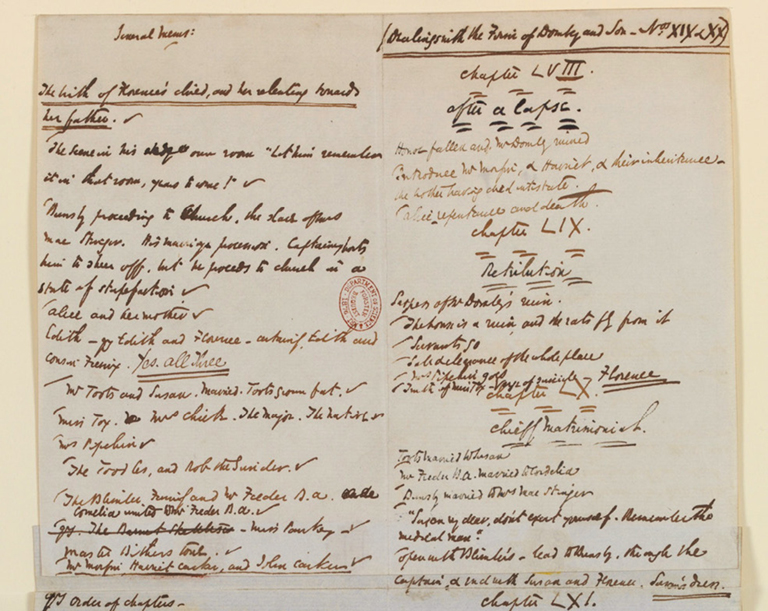
Image No.2012FE1509 (reduced and cropped): Forster Collection, National Art Library, Victoria and Albert Museum (2015). © Victoria and Albert Museum, London.
Click here to view a 'zoomifiable' version.
Transcription of Ws.19&20
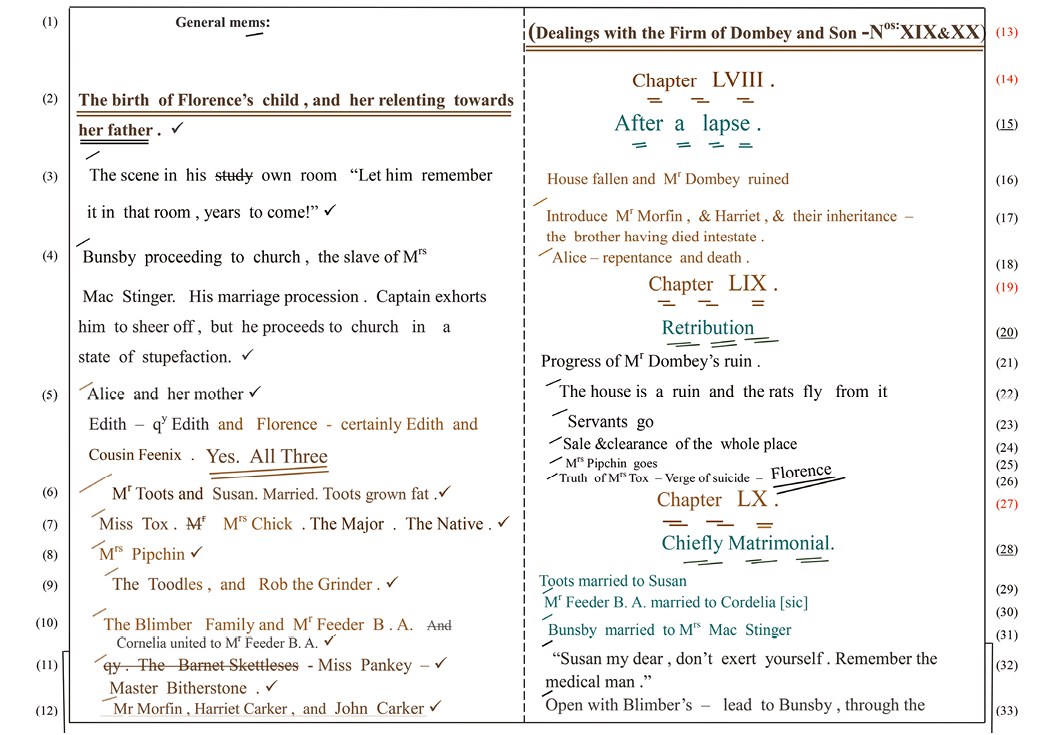
[See below for how the added leaf Ws.19&20a is attached to Ws.19&20.]
Commentary and order of entry (Ws.19&20)
On 29 February, Dickens goes down to Brighton to “finish the story” (L5:257). In an indication of the importance that he gives to the double number, he makes an early escape from the interruptions that come with his London life, “scarcely writing any letters”, and only returning “for a few hours at a time” to Urania Cottage on 6 and 7 March. He returns to Devonshire Terrace on the 16th “from the necessity of being near the printers”, perhaps to proofread the first two chapters the following day (L5:262), and remains there to finish the number. On the 21st, he expects to be “lingering over [Dombey], with a great desire to carry my care of him and his to the last […] until – I think – Thursday night [the 23rd]” (L5:263). On 31 March, Nos.19&20 for April 1848 are published.
LH
Initial plan for the number: (2)→ch.59
Number plan heading: (1)
Dickens has perhaps already entered (2)—with (13) on the right-hand page (see Ws.17 p.112). Entry (2) is a reminder to motivate Florence’s wish to be reconciled to her father by the birth of her child. Still using the thicker free-flowing quill, he heads the mems “General” because of the plan’s scope, forward and back (cf. Ws.31, ‘Outcomes’ p.48).
Additional plan: (3)→ch.59, (4)→ch.60
Entry (3) notes the setting of Dombey’s breakdown and the memory that begins the flood of memories (see 795882 and cf. 96101, 253272–73 and 500551). In entry (4), a strong contrast to (3), Cuttle meets the hapless Bunsby being led off to be married. “His” emphasizes the comic contrast to other marriage processions.
Further plan: (5), (6), (7), (8), (9), (10), (11) & (12)
Dickens plans to sum up the fortunes of most named characters by a final action and/or description. In recalling them, he groups them together, where possible in preparation for an incident or closing scene: in entry (5) with Alice and her mother, Edith and Feenix, and perhaps Edith and Florence; in (6) with Susan married to Toots (grown fat); in (10) with the Blimbers and Feeder (married to Cornelia); and in (12) with three characters underlined for their part in the last twist of the Carker story. Other groupings (7), (9) and (11) reflect their contribution to earlier episodes—he queries the inclusion of the Skettles, presumably as less germane (but see below “Proofs” p.125). In (8), the fierce Mrs Pipchin stands alone. Throughout, density, corrosion and size often vary from one item to another, reflecting the many pauses in the hand. Nevertheless, Dickens scrupulously defines each group with a slash, carefully keeping, for example, the slash that defines group (12) distinct from its underline.
RH
Preliminary heading: (13), (14), (19) & (27)
Dickens has probably already entered the part heading (13) with (2) on the left-hand page. With an ink more liable to corrosion, he enters three chapter number headings, as for a single number.
Plan for ch.58: (16), (17) & (18)
Dickens leaves a gap for the title, then in a lighter, corroding and smaller hand, notes: Dombey’s bankruptcy, John and Harriet’s anonymous gift to Dombey (funded from Carker’s estate, arranged by Morfin), and Alice’s deathbed repentance. “Introduce” confirms the intent of an outline plan much extended in composition.
MS
Composition and titling of ch.58
Dickens is concerned to give the reader a sense of time passing, to make the timeline of the Dombey thread more obviously consistent with Florence’s marriage and the birth of her first child. After titling, then heavily revising and re-writing the first paragraph (see ‘Appendix E’ p.191), he elaborates the reactions to bankruptcy. He develops Perch the gossip and social drinker, then, through Morfin, brings in Harriet and her determination (with John) to use part of their inheritance from James to help Dombey (12). Harriet, having brought Alice out of the city to convalesce, comforts her as she dies, nursed by the morose Wickam (now well established as a carer). Mrs Brown’s revelation that Alice’s father was the brother of Edith’s father begins the long cadence to Alice’s death (5).96 (Ch.58 takes up MS pp.1–10, or just over eleven printed pages).
Plan for ch.59: (21), (22), (23), (24), (25) & (26)
Leaving a gap for the title, Dickens sums up his subject (21); the “Progress” covers both persons and things, the exoduses and the auction. In (22) he notes the varying end-of-paragraph refrain that will mark the successive departures of servants (23), of auctioned goods (24), and of Mrs Pipchin (25), in contrast to the return of the loyal Miss Tox. The important part Polly will play in the drama—here unmentioned—is perhaps devised during composition. Dombey transformed by his memories is brought to the “Verge of suicide”, when he is rescued by the forgiving and penitent Florence (26). There is no intrinsic evidence of planning other than the omission of the title and some irregularity of layout. However, the description, as it is in black, must precede the use of greeny blue, which begins with the composition of ch.59 and ends with the titling of ch.62 (assuming as seems likely that all uses of greeny blue ink are consecutive). Dickens presumably brought a supply of black with him when he came to Brighton. That supply of black running out, he falls back on a greeny blue ink that happens to be available at his lodgings (cf. the use of watery blue ink in Ws.12 p.93).
MS
Composition and titling of ch.59
The chapter is written in a greeny blue ink. Ingenious transitions, extensions and additions to the plan suggest that it has been frequently rehearsed. Dickens closes the first paragraph with the refrain (22), adding its varied repetition to the end of each section (23), (24) and (25). He includes a last appearance for Mrs Chick (7) and Mrs Pipchin (9). With her husband’s consent (inserted at proofing), Polly takes over as housekeeper, supported—to Bagstock’s astonishment (795882)—by the tender Miss Tox, now Rob’s new employer (7) and (9). After Dombey’s breakdown and rescue by Florence, he devises a retrospective coda, compressing a final departure scene into the last paragraph, in which Polly locks up the ironically signed “desirable Family Mansion” before returning to her home and children. (Ch.59 takes up MS pp.11–22, almost fourteen printed pages). Dickens writes that he saw “in Florence’s marriage, and […] return to her father, a brilliant opportunity”, perhaps referring to how both, in different ways, reveal the power of memory to heal and transform (see the top of right-hand column of p.117).
RH
Having completed ch.59, still in greeny blue, he makes at least one entry in each of the five chapters. The greeny blue entries are probably consecutive (like the watery blue entries of Ws.12). The order of entry suggests that he may have kept the greeny blue to write ch.59, but having insufficient to complete any other chapter, uses his supply for other entries (mostly chapter titles, see below).97
Title of chs.58 and 59: (15) & (20)
Dickens copies the titles in the manuscript to the worksheet.
Titling and plan for the first section of ch.60: (28); (29), (30) & (31)
Dickens still greeny blue enters the chapter’s title (28) and the plan for the marriages of the three couples, named in (29), (30) (31), in the order of their occurrence.
[Probably after writing ch.59 and certainly before making the last three entries in greeny blue, Dickens wafers a half-foolscap leaf Ws.19&20a to Ws.19&20. See the ‘Introduction to Ws.19&20a’ below p.123].
Facsimile of Ws.19&20a
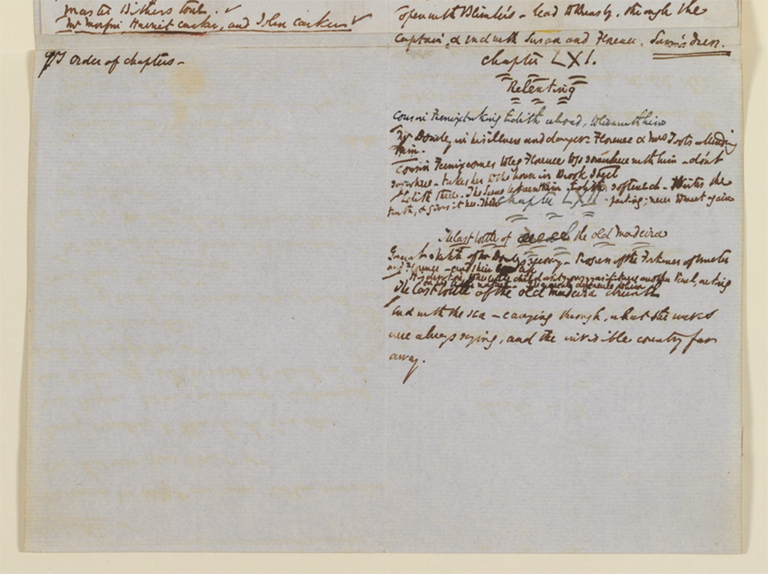
Image No.2012FE1509 (reduced and cropped): Forster Collection, National Art Library, Victoria and Albert Museum (2015). © Victoria and Albert Museum, London.
Click here to view a 'zoomifiable' version.
Transcription of Ws.19&20a
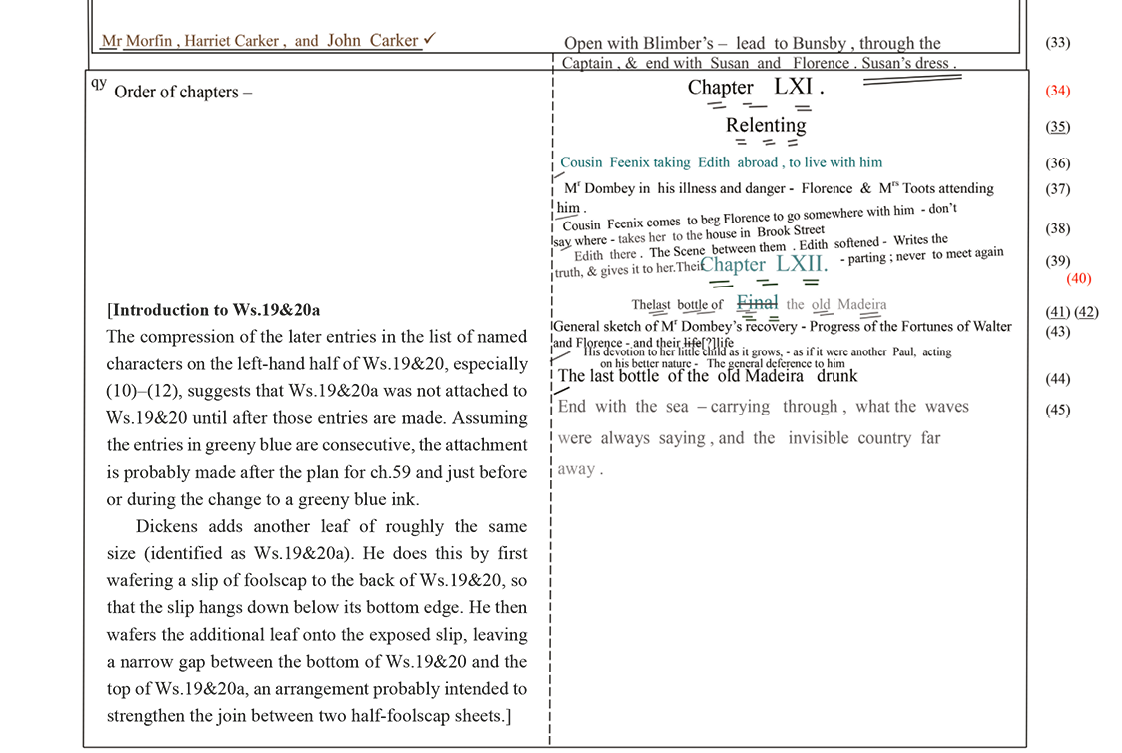
[Introduction to Ws.19&20a The compression of the later entries in the list of named characters on the left-hand half of Ws.19&20, especially (10)–(12), suggests that Ws.19&20a was not attached to Ws.19&20 until after those entries are made. Assuming the entries in greeny blue are consecutive, the attachment is probably made after the plan for ch.59 and just before or during the change to a greeny blue ink.
Dickens adds another leaf of roughly the same size (identified as Ws.19&20a). He does this by first wafering a slip of foolscap to the back of Ws.19&20, so that the slip hangs down below its bottom edge. He then wafers the additional leaf onto the exposed slip, leaving a narrow gap between the bottom of Ws.19&20 and the top of Ws.19&20a, an arrangement probably intended to strengthen the join between two half-foolscap sheets.]
Commentary and order of entry in Ws.19&20a (with some entries made to Ws.19&20)
RH
Plan for the first section of ch.61: (36)
Leaving space for number and title, Dickens gives the ending of Edith’s story; she is to settle in Italy, “under Feenix’s protection” (825916). He is perhaps still undecided about the meeting with Florence (5).
Chapter number heading and titling of ch.62: (40) & (41)
He enters the chapter number heading and the title “Final”.
Plan for the second section of ch.60: (32) & (33)
From now on writing in black—having returned to Devonshire Terrace on the 16th (see L5:262)—Dickens crossing to Ws.19&20 enters a final speech tag for the much-married Toots (32), then in entry (33), reminds himself of the order of the narrative, defined by person and place—its transitions carried by Cuttle. Crossing back to Ws.19&20a at “Captain”, he notes as a coda Susan’s re-adoption of her old dress in service (33), a gesture that conveys her unchanged loving attachment to Florence. The various directives and assembled entries in chs.60 and 61 confirm planning intent.
MS
Composition and title of ch.60
Dickens copies the title “Chiefly Matrimonial” to the worksheet (28). The initial transitions are managed through Toots, then after the arrival of Cuttle’s letter, through Cuttle as planned. Cuttle encounters Bunsby, a slave in the marriage procession; he tries and fails to dissuade him. Managing the coincidences with some self-mockery, Dickens dwells on this, the final wedding scene. It inverts romance and patriarchy for broad comic effect, in a last object lesson to the unworldly and unchanging Cuttle. To inquire after Dombey’s health, Cuttle makes his way to the Gays’ “out of London” home, where he re-joins Toots and Susan (816–17906). (Ch.60 takes up MS pp.23–30, or just over nine printed pages).
LH
Further plan
Entering “qy Order of chapters –” at the top of the left-hand half Dickens perhaps considers transposing chs.59 and 60.
He checks all of the left-hand entries in Ws.19&20, ticking all groups except for (5), where he only ticks “Alice […] mother” and (11), where he deletes “qy […] Skettleses” but ticks “Pankey” and “Bitherstone” mentioned in chs.59 and 60 (793879 and 805893).
List: [19&20]
He enters the headings for chs.58–60 once ch.60 is finished (p.179).
RH
Number heading for ch.61: (34)
Plan for the second section of ch.61: (37), (38) & (39)
Leaving a gap for the title, Dickens adds his plan for Dombey’s care and for Florence’s meeting with Edith.
MS and RH: (35)
Composition and titling of ch.61
Soon after beginning to compose, Dickens titles manuscript and worksheet (see ‘Appendix E’, ch.61, p.191).). He follows the sequence of the plan from entry (37), opening with Florence’s care of Dombey and his slow recovery, but—unplanned and perhaps an afterthought (cf. Toodles in ‘Proofs’)—adds the presence of Walter, who consents to Florence’s making a visit with Feenix to London and reassures her on the way. At Brook Street, Feenix takes her to the unsuspecting Edith.
When Edith’s resolve not to deny adultery wavers in the face of Florence’s love, Feenix intervenes and—as senior spokesman for the family name, who takes responsibility for the meeting—urges Edith “to set right whatever she has done wrong”, which she does by giving Florence the written account she has already prepared (826917). The development of Feenix ends with his epilogue, still speaking in his own characteristic style—perhaps also a humorous pastiche of the author’s own fondness for Shakespearian quotation and cadencing blank verse rhythms. (Ch.61 takes up MS pp.31–38, or just over eight printed pages).
Cutting and pasting from “and tenderness at once.” to the end of the chapter (827-28918-19), Dickens rewrites the chapter’s final paragraphs, so that he can on end on MS p.38—aware that it would leave four clear pages for ch.62. He calculates that forty-two manuscript pages is the equivalent of about forty-eight printed pages, i.e. three printers sheets, which leaves the fourth sheet for extra pages (see “Green covers”, p.9).
LH
Outcome: (5)
Dickens adds “Yes. All three” (with double underlines) to the three unticked items in (5).
Plan and titling of ch.62: (42), (43), (44) & (45)
Dickens deletes the earlier title “Final” (41), substituting (42) “The last bottle of the old Madeira” (its third broken double underline beneath “Fin” may be accidental ‘run-on’). He assembles his ideas, dividing the notes into three sections: the first, Dombey’s recovery and Walter’s good fortune (43), the second, the drinking of the last bottle of Madeira (44), and the third, a closing allusion to sea, waves and shore (44). Then he expands (43) by adding “and Florence – and their life” and inserting (44) “His devotion to her little child as it grows […] The general deference to him”.
Composition and titling of ch.62: (41)
Dickens reinstates the initial title, probably to avoid a repetition of the wine detail of the text, with which he now opens and which he later repeats. The refrain is inserted twice in MS (verso) with a “white line” to mark the passage of time, during which Florence has a second child.
Despite the care with which he planned the chapter, during composition he re-imagines the order of his plan and expands its content. The opening dramatises the “general deference” to Dombey. He reduces the “sketch” of Dombey’s recovery to a brief mention, “a storm that has passed”. He adds an explanation of Dombey’s acceptance of the annuity, Morfin’s marriage to Harriet and the new partnership of “Gills and Cuttle”. Walter’s success is reported (at second hand) through Toots, who bursts in to announce the birth of his little girl. Finally, Dickens holds back Dombey’s devotion to little Paul, which is evident to all, for a final scene of the children running free. It prefaces another tie, hinted at earlier, but only presented at the end, his intense relation to the granddaughter, known to no one but Florence, who can appreciate its significance. (The chapter takes up MS pp.38–42—with a quarter of the page unused—or four and a half printed pages).
List: [19&20a]
When he has completed ch.62, Dickens enters the headings for chs.61 and 62 on the back of the last leaf of the List p.180.
Additions
Dickens carries on the “care to him [Dombey] and his to the last” (L5:263). He works in a mention of the following: young Mr Skettles (living abroad with his father now a diplomat); Mr Toodles giving his approval for Polly’s return to the Dombey mansion; Miss Tox for one last time; and at the very last moment, he arranges for Forster to make good his omission of Diogenes (Life 484K:9490).98
Cuts
The additions to the text may have meant that Dickens had to cancel the last two paragraphs (see Horsman 1974, ‘Introduction’, p.xxxvi). However, he may also have other reasons: among them, perhaps, doubt at the implications of the final plea that it is better to die a young Paul than live an aged (and unredeemed) Dombey. The cancellation, creating closure on the “untold story”, adds weight to the final blank verse cadence “and smooths away the curls that shade her earnest eyes”.99







